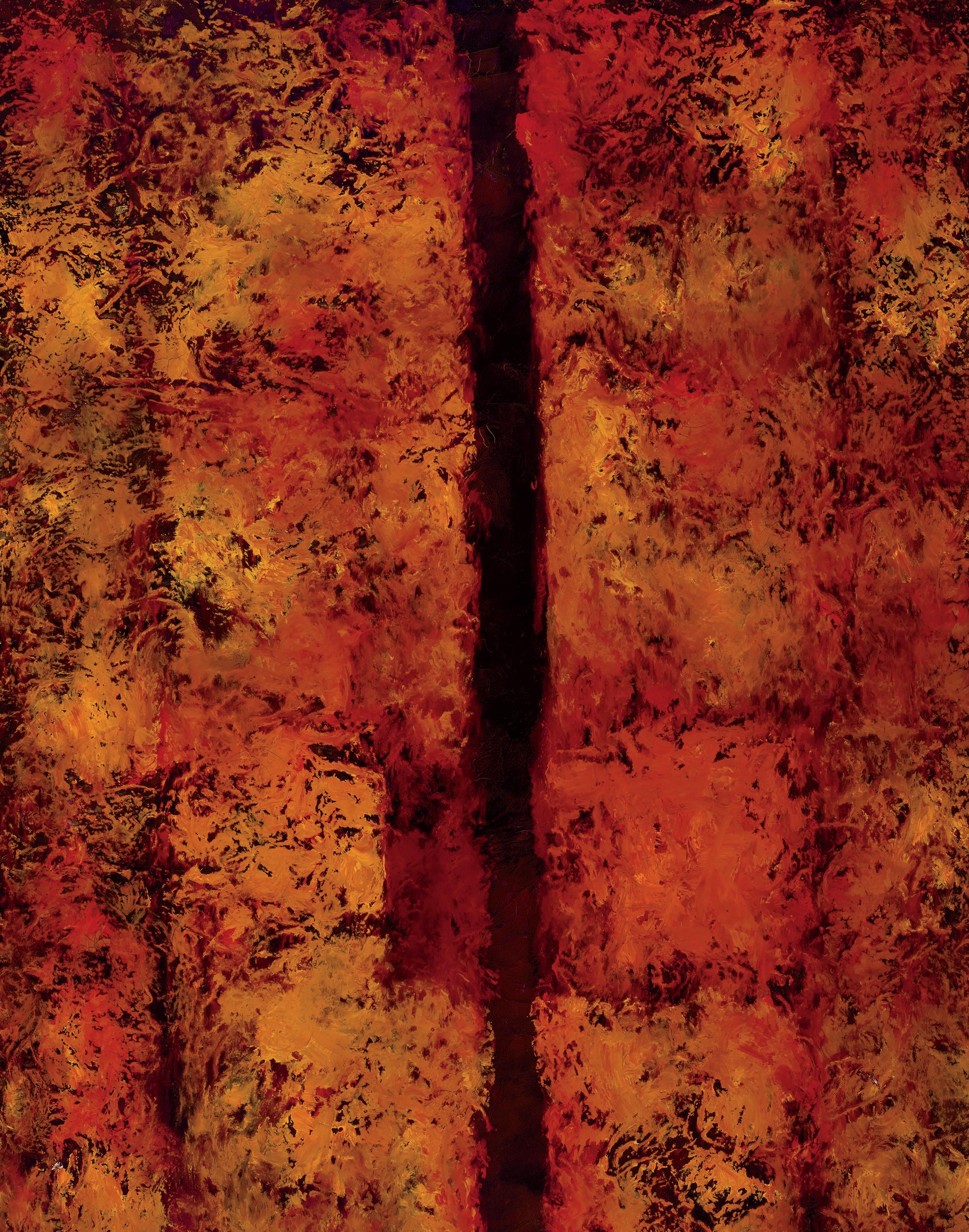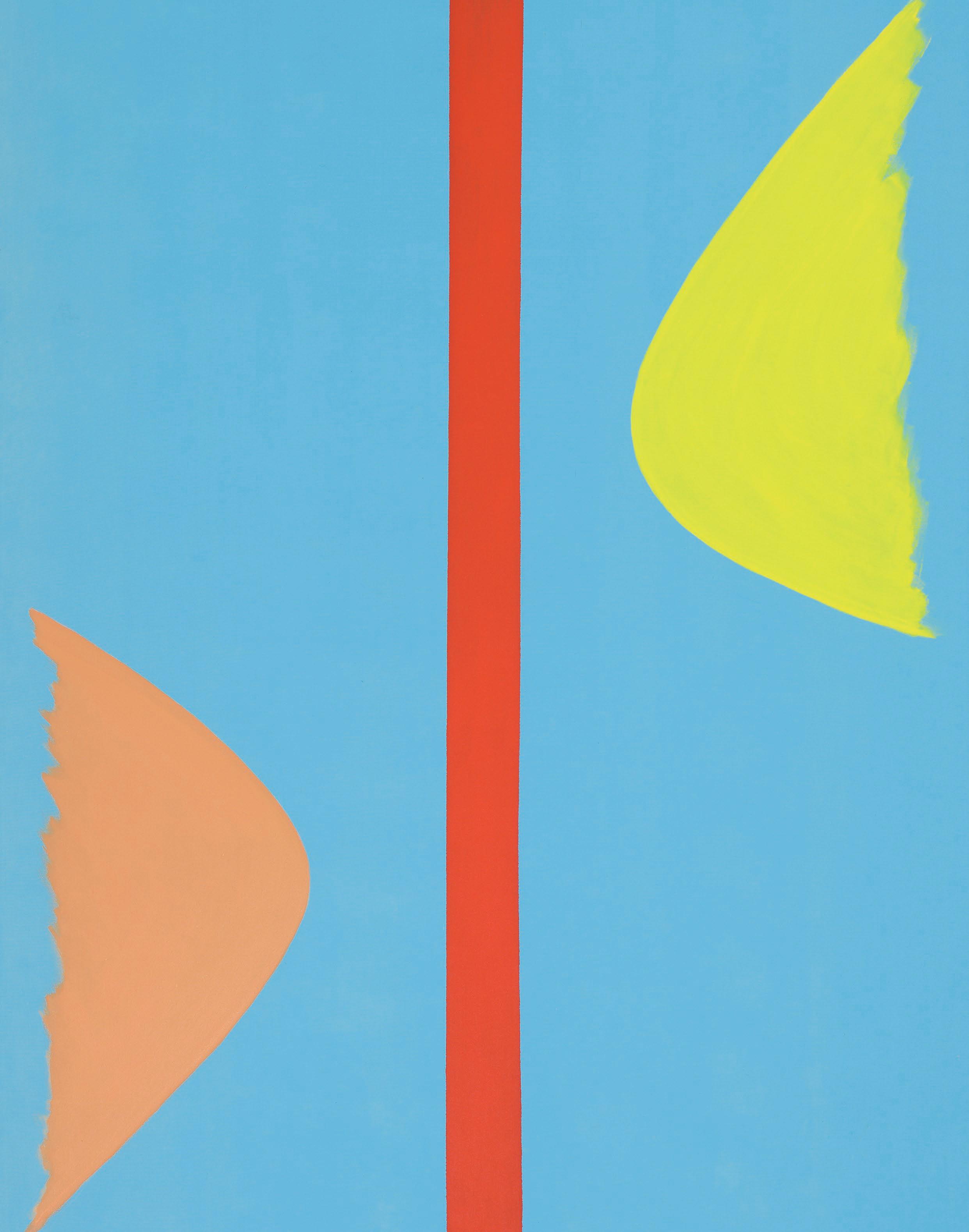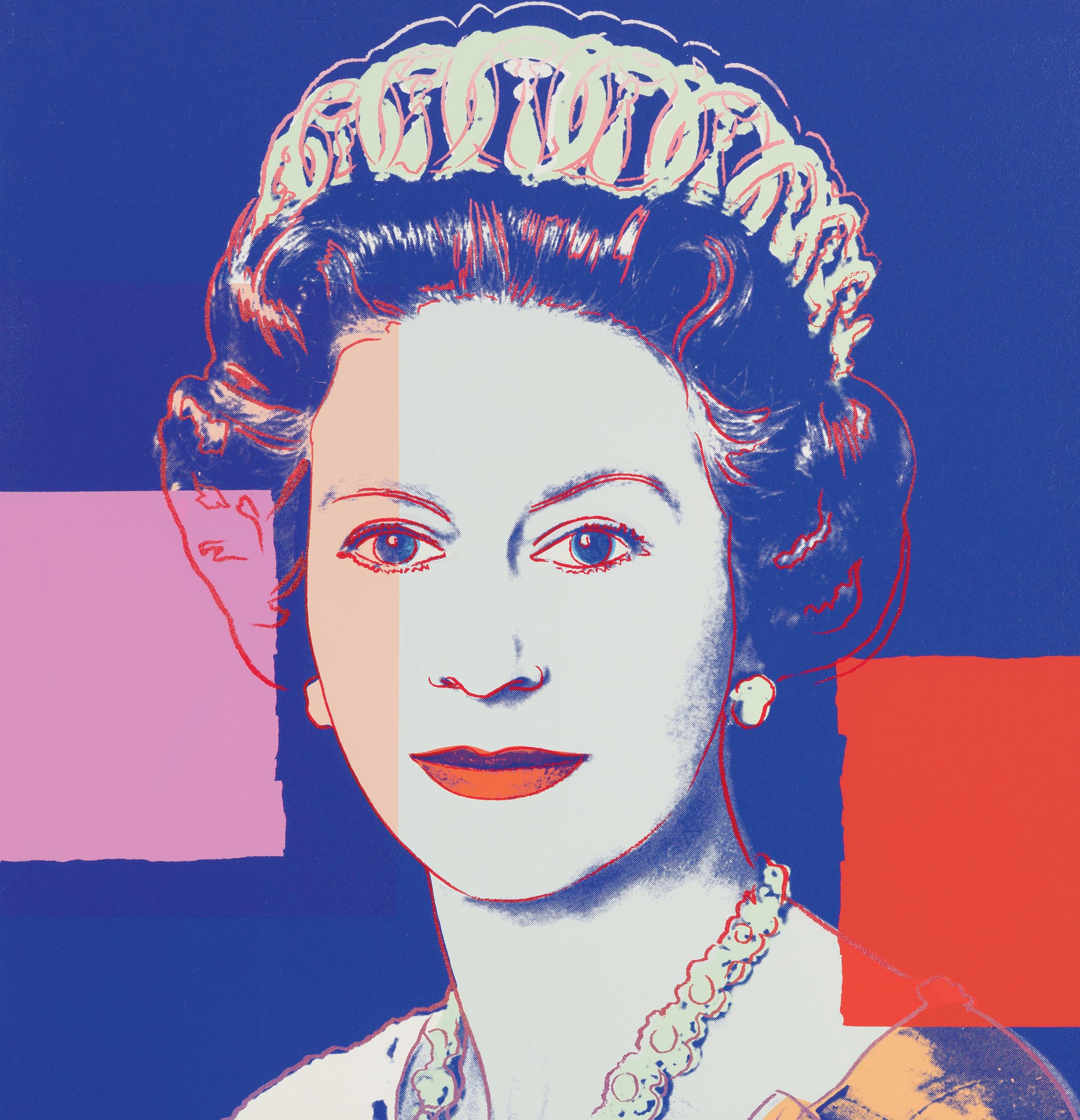
sA le Thursday, nOVEMBE r 24, 2022 · 2 p M p T | 5 pM ET post-w A r & contempor A ry A rt

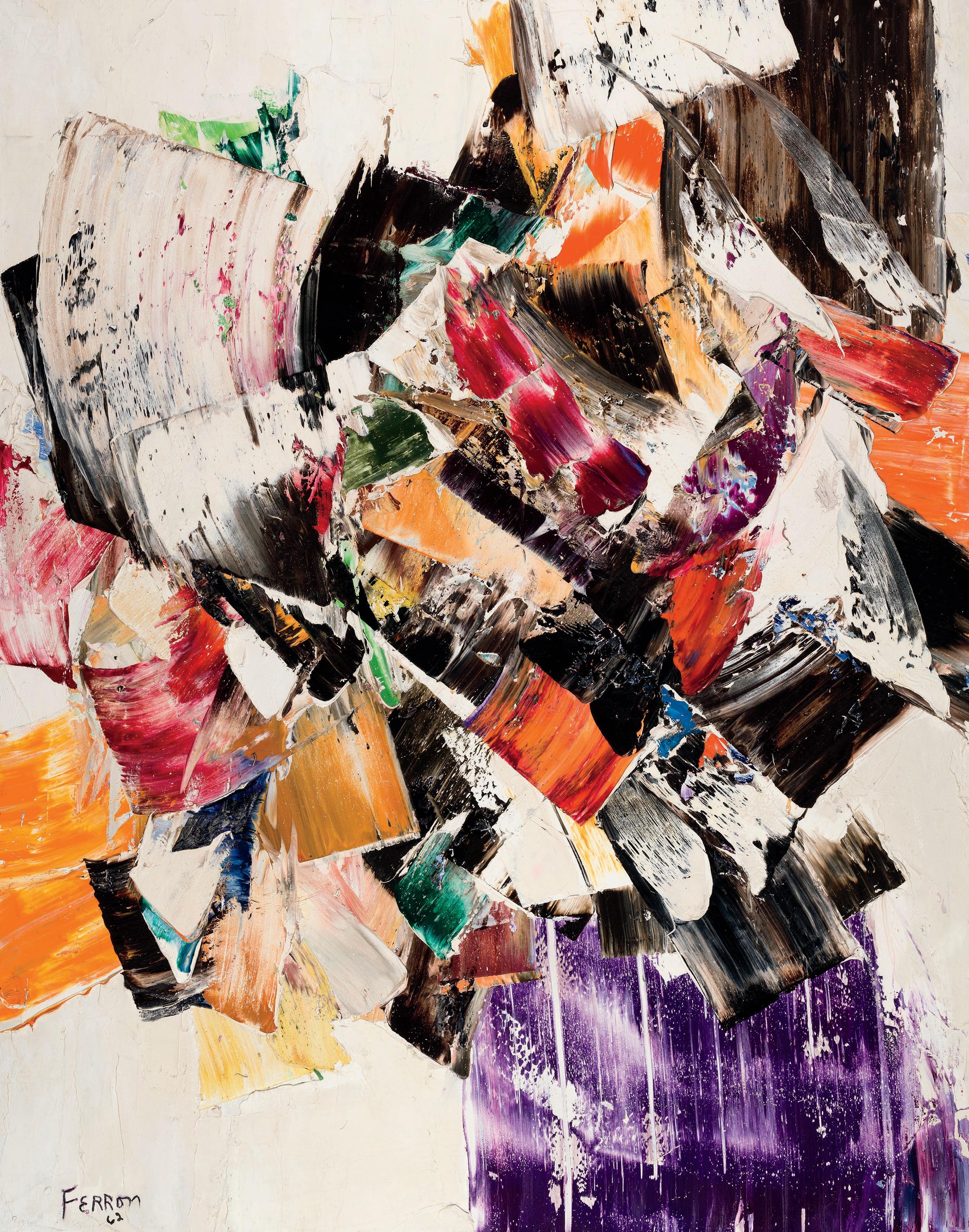

Auction
Thursday, November 24, 2022
Park Hyatt Hotel, Park Hyatt Ballroom
4 Avenue Road, Toronto
Together with Heffel’s Digital Saleroom
Video Presentation
Previews
By appointment
Heffel Gallery, Vancouver
2247 Granville Street
Saturday, October 15 through
Monday, October 24, 11 am to 6 pm PT
Galerie Heffel, Montreal
1840 rue Sherbrooke Ouest
Thursday, November 3 through Wednesday, November 9, 11 am to 6 pm ET
Heffel Gallery, Toronto

13 Hazelton Avenue
Together with our Yorkville exhibition galleries
Wednesday, November 16 through Wednesday, November 23, 11 am to 6 pm ET
1:30 PM PT | 4:30 PM ET Post-War & Contemporary Art 2 PM PT | 5 PM ET Canadian, Impressionist & Modern Art 4 PM PT | 7 PM ET
P ost-w A r & contem P or A ry A rt
Heffel Gallery Limited
Additionally herein referred to as “Heffel” or “Auction House”
cont A ct
Toll Free 1-888-818-6505 mail@heffel.com, www.heffel.com Please send all mail to our Vancouver address
t oronto
Main Yorkville Reception
13 Hazelton Avenue, Toronto, ON M 5 R 2 E 1 Telephone 416-961-6505, Fax 416-961-4245
15 Hazelton Avenue, Unit 200, Toronto, ON M 5 R 2 E 1
135 Yorkville Avenue, Unit 401, Toronto, ON M 5 R 3 W 5
155 Yorkville Avenue, 2nd Floor, Toronto, ON M 5 R 1 C 4
o tt A w A
451 Daly Avenue, Ottawa, ON K 1 N 6 H 6 Telephone 613-230-6505, Fax 613-230-6505
m ontre A l
1840 rue Sherbrooke Ouest, Montreal, QC H 3 H 1 E 4 Telephone 514-939-6505, Fax 514-939-1100
vA ncouver
2247 Granville Street, Vancouver, BC V 6 H 3 G 1 Telephone 604-732-6505, Fax 604-732-4245
north vA ncouver
2455 Dollarton Highway, Unit 108 North Vancouver, BC V 7 H 0 A 2 Telephone 604-732-6505 ext. 150, Fax 604-732-4245
cA lg A ry
Main Calgary Reception
888 4th Avenue SW, Unit 609, Calgary, AB T 2 P 0 V 2 Telephone 403-238-6505, Fax 403-265-4225
220 Manning Road NE , Unit 1080, Calgary, AB T 2 E 8 K 4
c or P or A te bA nk
Royal Bank of Canada, 2735 Granville Street Vancouver, BC V 6 H 3 J 1 Telephone 604-665-5700
Incoming wires are required to be sent in Canadian funds and must include: Heffel Gallery Limited, 2247 Granville Street, Vancouver, British Columbia V 6 H 3 G 1 as beneficiary.
b o A rd of d irectors
Chairman In Memoriam—Kenneth Grant Heffel
President—David Kenneth John Heffel Auctioneer License T 83-3364318 and #22-106727 Vice-President—Robert Campbell Scott Heffel Auctioneer License T 83-3365303 and #22-106726
Printed in Canada by Friesens ISBN : 978-1-927031-55-1
Heffel com Departments
consignments consignments@heffel.com
A PP r A is A ls appraisals@heffel.com
Absentee, t ele P hone & online b idding bids@heffel.com
s hi PP ing shipping@heffel.com
s ubscri P tions subscriptions@heffel.com
cA t A logue s ubscri P tions
Heffel Gallery Limited regularly publishes a variety of materials beneficial to the art collector. An Annual Subscription entitles you to receive our Auction Catalogues. Our Annual Subscription Form can be found on page 85 of this catalogue.
cA t A logue Production Essay Contributors—Marie-Hélène Busque, Mark Cheetham, Daniel Gallay, Michèle Grandbois, Alec Kerr, Sarah Stanners and Rosalin Te Omra Text Editing, Catalogue Production—Julia Balazs, David Heffel, Robert Heffel, Alec Kerr, Naomi Pauls, Tania Poggione and Rosalin Te Omra Director of Imaging—Martie Giefert Digital Imaging—Ward Bastian, Jasmin Daigle and Jared Tiller Catalogue Layout and Production—Kirbi Pitt and Clara Wong Catalogue Design—Peter Cocking
c o P yright
No part of this publication may be reproduced, stored in retrieval systems or transmitted in any form or by any means, digital, photocopy, electronic, mechanical, recorded or otherwise, without the prior written consent of Heffel Gallery Limited.

All photographic representations and other illustrations depicted are solely for guidance and are not to be relied upon in terms of tone or colour.

Follow us: L I X
at Auction
Bidding
Collection
Business Conduct,
4 Notice for Collectors 5 Auction Details Selling
Buying at Auction General
Increments Framing, Conservation and Shipping Written Valuations and Appraisals 7 Post-War & Contemporary Art Catalogue 74 Heffel Specialists 76 Terms and Conditions of Business 82 Property
Notice 83 Catalogue Abbreviations and Symbols 84 Catalogue Terms 84 Heffel’s Code of
Ethics and Practices 85 Annual Subscription Form 85 Collector Profile Form 86 Absentee Bid Form 87 Telephone Bid Form 88 Digital Saleroom Registration Form 89 Shipping Authorization Form for Property 90 Terms and Conditions for Shipping 91 Index of Artists by Lot contents
notice for c ollectors
Auction Location
P
hotel Park Hyatt Ballroom
4 Avenue Road, Toronto
Together with Heffel’s Digital Saleroom Saleroom Telephone 1-888-212-6505
To attend the auction or bid in person, please contact bids@heffel.com to reserve your seat and register in advance. Complimentary food and beverages will be served in the ballroom.
Auction Notice
The Buyer and the Consignor are hereby advised to read fully the Terms and Conditions of Business and Catalogue Terms, which set out and establish the rights and obligations of the Auction House, the Buyer and the Consignor, and the terms by which the Auction House shall conduct the sale and handle other related matters. This information appears on pages 76 through 84 of this publication.
Please visit www.heffel.com for information on which Lots will be present at each preview location, virtual auction previews and to book your in person preview appointment. Preview appointments can also be booked by calling 1-888-818-6505.

Absentee, Telephone and Digital Saleroom Bidding
If you are unable to attend our auction in person, Heffel recom mends submitting an Absentee Bid Form to participate. Heffel also accepts telephone bidding, prioritized by the first received Tele phone Bid Form and limited to available Telephone Bid Operators per Lot. Alternatively, Heffel offers online bidding in real time through our Digital Saleroom, subject to advanced registration and approval. All forms of remote bidding participation and reg istration must be received by Heffel at least two (2) business days prior to the commencement of the sale. Information on absentee, telephone and online bidding appears on pages 5, 86, 87 and 88 of this publication.
Live Stream
Please note that we produce a live stream of our sale beginning with a video presentation at 4:30 PM ET and the auction commencing at 5 PM ET. We recommend that you test your video streaming 30 minutes prior to our sale at: www.heffel.com
All Lots and additional images depicting the frame and verso are available at www.heffel.com.
Estimates and Currency
Our Estimates are in Canadian funds. Exchange values are subject to change and are provided for guidance only. Buying 1.00 Canadian dollar will cost approximately 0.72 US dollar, 0.75 euro, 0.66 British pound, 0.70 Swiss franc, 102 Japanese yen or 5.2 Hong Kong dollars as of our publication date.
4
A rk hyA tt
uction det A ils
Selling at Auction
Heffel offers individuals, collectors, corporations and public entities a full-service firm for the successful de-acquisition of their artworks. Interested parties should contact us to arrange for a private and confidential appointment to discuss their pre ferred method of disposition and to analyse preliminary auction estimates, pre-sale reserves and consignment procedures. This service is offered free of charge.
If you are from out of town or are unable to visit us at our premises, we would be pleased to assess the saleability of your artworks by mail, courier or e-mail. Please provide us with pho tographic or digital reproductions of the artworks front and verso and information pertaining to title, artist, medium, size, date, provenance, etc. Representatives of our firm travel regularly to major Canadian cities to meet with Prospective Sellers.
It is recommended that property for inclusion in our sale arrive at Heffel at least 90 days prior to our auction. This allows time to photograph, research, catalogue and promote works and complete any required work such as re-framing, cleaning or con servation. All property is stored free of charge until the auction; however, insurance is the Consignor’s expense.
Consignors will receive, for completion, a Consignment Agree ment and Consignment Receipt, which set forth the terms and fees for our services. The Seller’s Commission is the amount paid by the Consignor to the Auction House on the sale of a Lot, which is calcu lated on the Hammer Price, at the rates specified in writing by the Consignor and the Auction House on the Consignment Agreement, plus applicable Sales Tax. Consignors are entitled to set a mutu ally agreed Reserve or minimum selling price on their artworks.
Buying at Auction
All items that are offered and sold by Heffel are subject to our published Terms and Conditions of Business, our Catalogue Terms and any oral announcements made during the course of our sale. Heffel charges a Buyer’s Premium calculated on the Hammer Price as follows: a rate of twenty-five percent (25%) of the Hammer Price of the Lot up to and including $ 25,000; plus twenty percent (20%) on the part of the Hammer Price over $ 25,000 and up to and including $ 5,000,000; plus fifteen percent (15%) on the part of the Hammer Price over $ 5,000,000, plus applicable Sales Tax.
If you are unable to attend our auction in person, you can bid by completing the Absentee Bid Form found on page 86 of this catalogue. Please note that all Absentee Bid Forms should be received by Heffel at least two (2) business days prior to the commencement of the sale. Bidding by telephone, although limited, is available. Please make arrangements for this service well in advance of the sale. Telephone lines are assigned in order of the sequence in which requests are received. We also recom mend that you leave an Absentee Bid amount that we will execute on your behalf in the event we are unable to reach you by tele phone. Digital Saleroom online bidding is available subject to pre-registration approval by the Auction House at least two (2) business days in advance of the auction.
Payment must be made by: a) Bank Wire direct to the Auction House’s account, b) Certified Cheque or Bank Draft, c) a Per sonal or Corporate Cheque, d) Debit Card and Credit Card only by Visa, Mastercard or Union Pay or e) Interac e-Transfer. Bank
Wire payments should be made to the Royal Bank of Canada as per the account transit details provided on your invoice. All Cer tified Cheques, Bank Drafts and Personal or Corporate Cheques must be verified and cleared by the Auction House’s bank prior to all purchases being released. Credit Card payments are subject to our acceptance and approval and to a maximum of $ 5,000 if the Buyer is providing their Credit Card details by fax or to a maximum of $ 25,000 per Lot purchased if paying online or if the Credit Card is presented in person with valid identification. The Buyer is limited to two e-Transfers per Lot and up to a maximum of $ 10,000 per e-Transfer as per the instructions provided on your invoice. In all circumstances, the Auction House prefers payment by Bank Wire.
General Bidding Increments
Bidding typically begins below the low estimate and generally advances in the following bid increments:
$ 50 300 $ 25 increments
$ 300 500 $ 50 $ 500 2,000 $ 100
$ 2,000–5,000 $ 250 $ 5,000–10,000 $ 500
$ 10,000–20,000 $ 1,000
$ 20,000–50,000 $ 2,500
$ 50,000–100,000 $ 5,000
$ 100,000–300,000 $ 10,000
$ 300,000–1,000,000 $ 25,000
$ 1,000,000–2,000,000 $ 50,000 $ 2,000,000–3,000,000 $ 100,000 $ 3,000,000–5,000,000 $ 250,000 $ 5,000,000–10,000,000 $ 500,000 $ 10,000,000+ $ 1,000,000
Framing, Conservation and Shipping
As a Consignor, it may be advantageous for you to have your art work re-framed and/or cleaned and conserved to enhance its saleability. As a Buyer, your recently acquired artwork may demand a frame complementary to your collection. As a full-service orga nization, we offer guidance and in-house expertise to facilitate these needs. Buyers who acquire items that require local delivery or out-of-town shipping should refer to our Shipping Authorization Form for Property on page 89 and our Terms and Conditions for Shipping on page 90 of this publication. Please feel free to con tact us to assist you in all of your requirements or to answer any of your related questions. Full completion of our shipping form is required prior to purchases being released by Heffel.
Written Valuations and Appraisals
Written valuations and appraisals for probate, insurance, family division and other purposes can be carried out in our offices or at your premises. Appraisal fees vary according to circumstances. If, within five years of the appraisal, valued or appraised artwork is consigned and sold through Heffel, the client will be refunded the appraisal fee, less incurred “out of pocket” expenses on a prorated basis.
5 A
VERSION 2022.09 © H E ff E l G A ll ER y lIMITE d
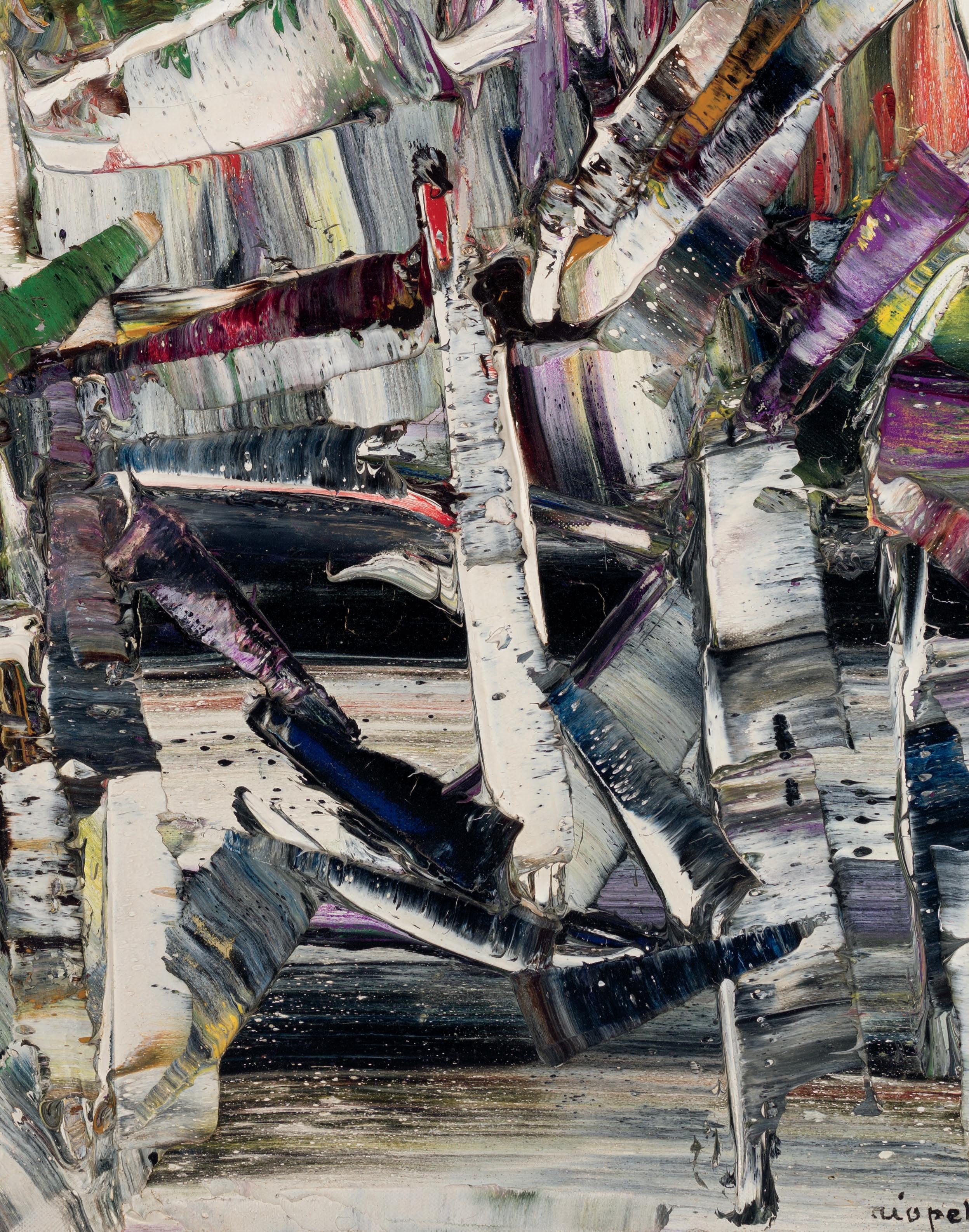
P ost-w A r & c ontem P or A ry
A rt catalogue
f
A turing
from
The Family of Paul-Vanier Beaulieu
The Family of Margaret Carton
The Family of William Perehudoff
An Important Private Collection, Vancouver
& other Important Private and Corporate Collections

sA le Thursday, Nov EM b E r 24, 2022 · 2 P M PT | 5 PM ET
e
w orks

8
Sans titre
oil on canvas, signed and dated 1947 and on verso titled Sans titre and Abstraction and dated on the gallery labels
1/4 × 8 1/4 in, 31.1
Proven A
Galerie Bernard Desroches, Montreal Galerie Valentin, Montreal Private Collection, Edmonton
Maurice Perron, Photographies, Musée du Québec, 1998, reproduced page 51 Roald Nasgaard, Abstract Painting in Canada, Art Gallery of Nova Scotia, 2007, page 66
René Viau and Dorota Kozinska, Paul-Émile Borduas: exposition rétrospective, Galerie Valentin, 2010, reproduced page 12

75 Sherbrooke Street West, Montreal, Second Automatist Exhibition, February 15 – March 1, 1947
Galerie Bernard Desroches, Montreal, The Canadian Avant-garde of the 1950s and 1960s, November 8 – 28, 1989 Galerie Valentin, Montreal, Paul-Émile Borduas: exposition rétro spective, September 11 – 25, 2010, exhibited as Abstraction
HIS PAINTING IS from Paul-Émile Borduas’s Automatist period, just before the group’s publication in 1948 of the Refus global manifesto, which released a flood of controversy. In 1947, his work related to the use of automatic writing in Surrealism—an unconscious process he used in his gouaches, facilitated by the water-based fluidity of that medium. However, when Borduas was working in oil, he faced a problem, because oil did not dry instantaneously. So he worked in two stages. First he painted the background and allowed it to dry. Then, using brush and palette knife, he could intuitively add marks and shapes. In Sans titre, the shapes are aligned like a grid on the surface, “hovering above the pictures’ dream spaces,” as Roald Nasgaard described. The work has a strong figure / ground relationship, in which shapes, imply ing objects, float over a deep background, the “dream spaces” of Nasgaard’s description. This brightly hued painting is an out standing example of Borduas’s late 1940s Automatist period.
Sans titre was included in the Automatist group show that took place in February 1947 in the Montreal apartment that Claude Gauvreau shared with his mother. The artists covered the walls in jute and hung the walls Salon style, one painting above the other in rows. It was considered the most impressive of the group’s exhibitions.
This painting is included in François-Marc Gagnon’s online catalogue raisonné on the artist’s work at www.concordia.ca/ catalog/2772, catalogue #2005-0807.
9 1 Paul Émile Borduas AUTO CAS QMG RCA 1905 – 1960
12
× 21 cm
nce
l iter A ture
e xhibited
T
e stim A te: $ 70,000 – 90,000
Sans titre hanging at 75 Sherbrooke Street West at the Gauvreau home, Montreal, during the Second Automatist Exhibition, February 1947, Madeleine Arbour and Paul-Émile Borduas in background Photo: Maurice Perron, © Estate of Maurice Perron, private archives Courtesy of Line-Sylvie Perron
Marcelle Ferron
Sans titre (Diptyque)
oil on canvas diptych, on verso signed on the left canvas and inscribed Gauche and Droite, circa 1964 18 1/2 × 30 in, 47 × 76.2 cm
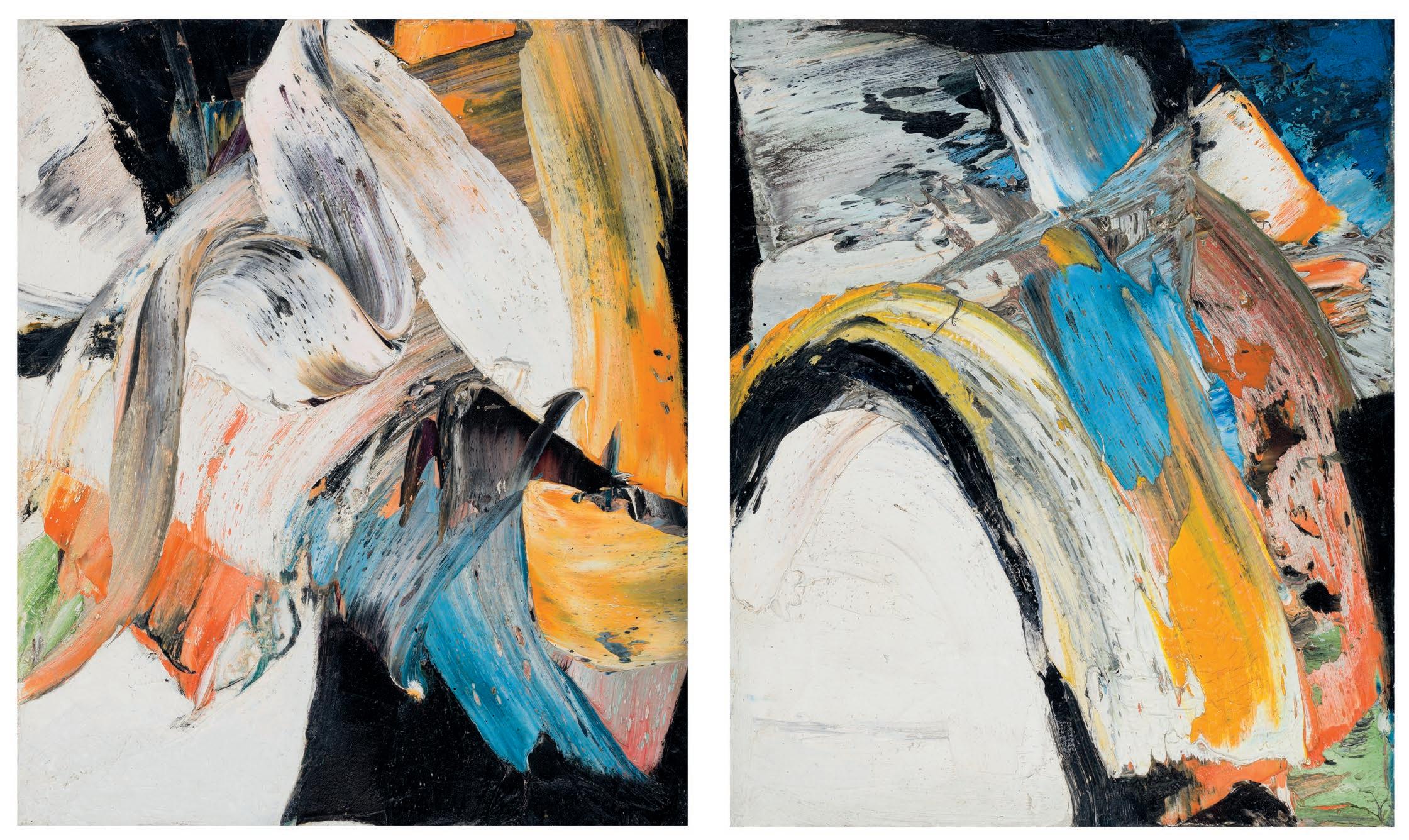
Proven A nce
A gift from the Artist to Noël Lajoie, Saint-Paul-Trois-Châteaux, France Private Collection, Toronto
A S ONE O f the original 16 signatories of Paul-Émile Borduas’s iconoclastic Refus global manifesto, Marcelle Ferron was committed to the aesthetic and artistic goals underlying the Automatists—in particular, the use of gesture as an essential ele ment of authentic artistic expression. This exceptional diptych is a fine example of the techniques she was developing in the 1960s
while she was based in Paris. The artist would build up layers of colour over a pure white ground, thickly applying paint directly from the tube (when she was not mixing pigments herself) and creating broad, sweeping strokes using a variety of palette knives.
After more than a decade in Paris, Ferron returned in 1966 to Quebec, where she became fascinated by the potential of stained glass as a medium; she would work exclusively with it for the next two decades. This painting, produced near the end of her time in France, brilliantly demonstrates that Ferron’s practice was already grounded in an intense interest in light and colour. Here, the jewel-like tones and flashing radiance transcend the material qualities of paint to create an exceptionally vibrant, expressive work.
The left canvas measures 18 1/4 × 15 1/8 inches, and the right canvas 18 1/2 × 14 7/8 inches.
10
e stim A te: $ 60,000 – 80,000 2
AANFM AUTO CAS QMG RCA SAAVQ SAPQ 1924 – 2001
Cellule orange
oil on canvas, signed and dated 1962 and on verso signed, titled on a label and dated 13-1-62
45 3/4 × 35 in, 116.2 × 88.9 cm
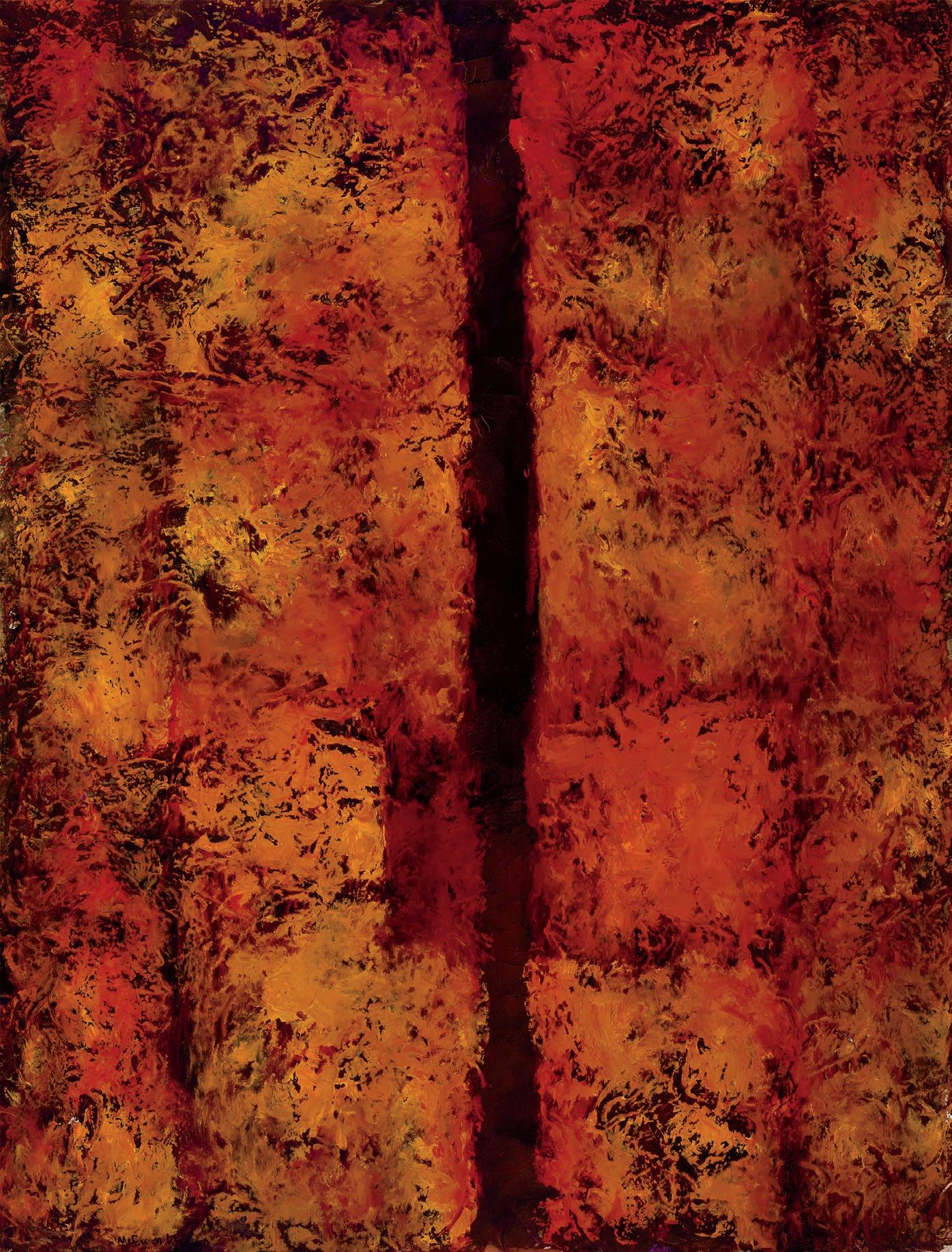
Proven A nce
Collection of the family of Paul-Vanier Beaulieu, Laval
T HIS f IER y CANVAS is a late example of Jean McEwen’s Cellules (Cells) paintings, a series of canvases he began in 1958. These works represented the culmina tion of the techniques he had developed throughout the 1950s—shimmering light effects, architectonic arrangements, softly impastoed surfaces—and calcified them into what became his most recognizable pictorial language. Here, paint is applied in stratified, porous layers, creating an interplay between opacity and transpar ency. Colour is applied in thick textures and thinned glazes: oranges, yellows and ochres are laid over and beneath deeper crimsons and carmines that produce a roiling, incendiary internal glow. Emerg ing from these energetic eruptions are subtle, almost imperceptible geome tries. The prominent central division is bordered by two echoing vertical ripples that seem to recede and billow across the surface. Less distinct is the ethereal rectilinear form in the bottom half of the canvas—perhaps the “cell” of the title— which seems to float out of the haze of colour. Barely perceived, it is formed in the negative, a void emerging from the rifts between colours—skilfully show casing McEwen’s lyrical explorations of depth, vibrancy of colour and texture.
e stim A te: $ 70,000 – 90,000
11 3 Jean Albert McEwen AANFM RCA 1923 – 1999
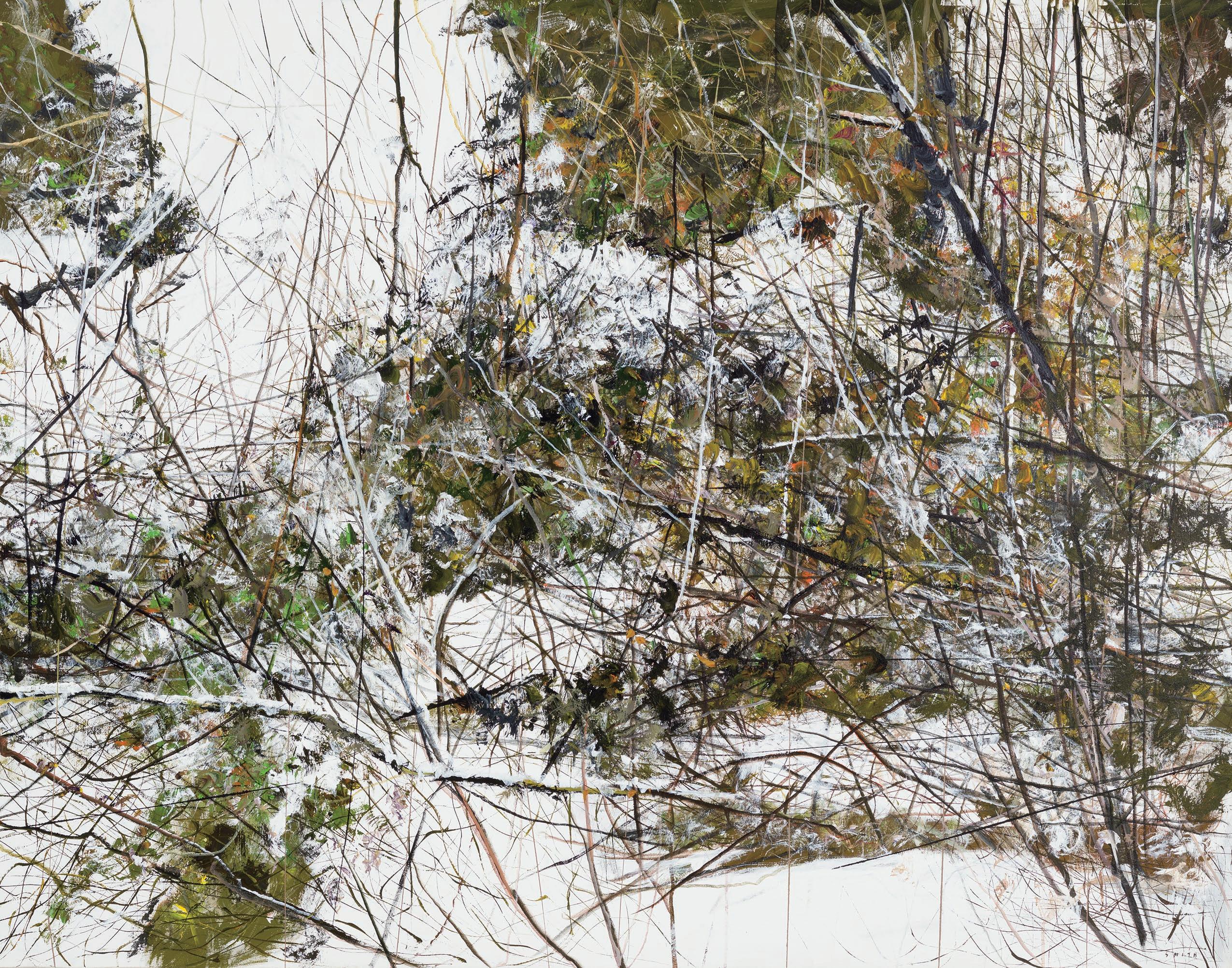
12
4 Gordon Appelbe Smith
Cypress #3
acrylic on canvas, signed and on verso titled and dated 2012 55 × 70 in, 139.7 × 177.8 cm
Proven A nce
Equinox Gallery, Vancouver An Important Private Collection, Vancouver
l iter A ture
Ian M. Thom and Andrew Hunter, Gordon Smith: The Act of Painting, Vancouver Art Gallery, 1997, page 101 Andy Sylvester, Gordon Smith: Don’t Look Back, 2014, essay by Ian Wallace, pages 100 and 119
I N 2012 , G OR d ON S MITH produced a group of works based on Cypress Mountain landscapes. This mountain was directly above Smith’s home and studio in West Vancouver, its wild forest only a short drive away. This work is a superb acrylic from the Entanglements series.
Branches and greenery emerge from a snow-covered forest floor, in a work that is more representational than abstract. Smith was always creating different balances between abstraction and landscape in his painting. This work evokes the presence of a particular section of woods, yet it could be anywhere on the mountain, as we are not given landmarks. In Cypress #3, Smith is primarily concerned with paint and the definition of space. The artist plays with perspective—the patch of snow in the top left reads vertically, as if rising up a hill, and it acts to tilt the whole plane forward. A tracery of branches overlays the forest floor; some of these are delicate, some are thicker, with the larger ones edged with a layer of snow. These branches block entry to the scene—this is not a landscape you feel you can step into. It is one to be observed for the patterns of lines on a colour field. Smith’s fluid definition of the forest floor is established through soft brushwork, with snow broken by dark splotches and patches
of moss and forest debris. The dominant palette of white, green, brown and black is illuminated by daubs of ochre, orange, green and red that add sparks of energy.
As Ian Wallace wrote, Smith was “committed to the historical destiny of painting as a vision of modernity, actively declaring his individual existence through the free marking that is the idiom of abstract painting.” Smith’s commitment to modernism dates from 1951, when he studied at the California School of Fine Arts with Elmer Bischoff. He was exposed to American artists such as Clyfford Still, Richard Diebenkorn and Arshile Gorky, and this marked a turning point for him. In 1957, he went to Harvard to study and met Walter Gropius, the German-American archi tect who was the founder in 1919 of the modernist Bauhaus School, whose influence was important to Smith. In Vancou ver, the modernist scene was crossing artistic boundaries and included architects, artists and writers. Smith stated he had “many mentors with varying interests: Arthur [Erickson], Jack [Shadbolt] . . . George Woodcock, Jack Parnell, . . . Geoff Massey and many others in a community of very engaged people.” He also felt that “the Vancouver [post-war] art community was ahead of any other in Canada. There were more active artists in Vancou ver than anywhere else in the country experimenting with new ideas, with abstraction.”
Smith famously stated that he was “one hundred painters deep.” He continually absorbed ideas, using them to form his unique, ever-evolving style. Smith worked in his studio every day, and his will to paint was a declaration of his very existence. His passion and dedication to his art was, and continues to be, an inspiration to artists.
Consignor proceeds will benefit Ballet BC , Food Stash Foundation and the y MCA of Greater Vancouver.
e stim A te: $ 70,000 – 90,000
13
BCSFA CGP CPE OC RCA 1919 – 2020
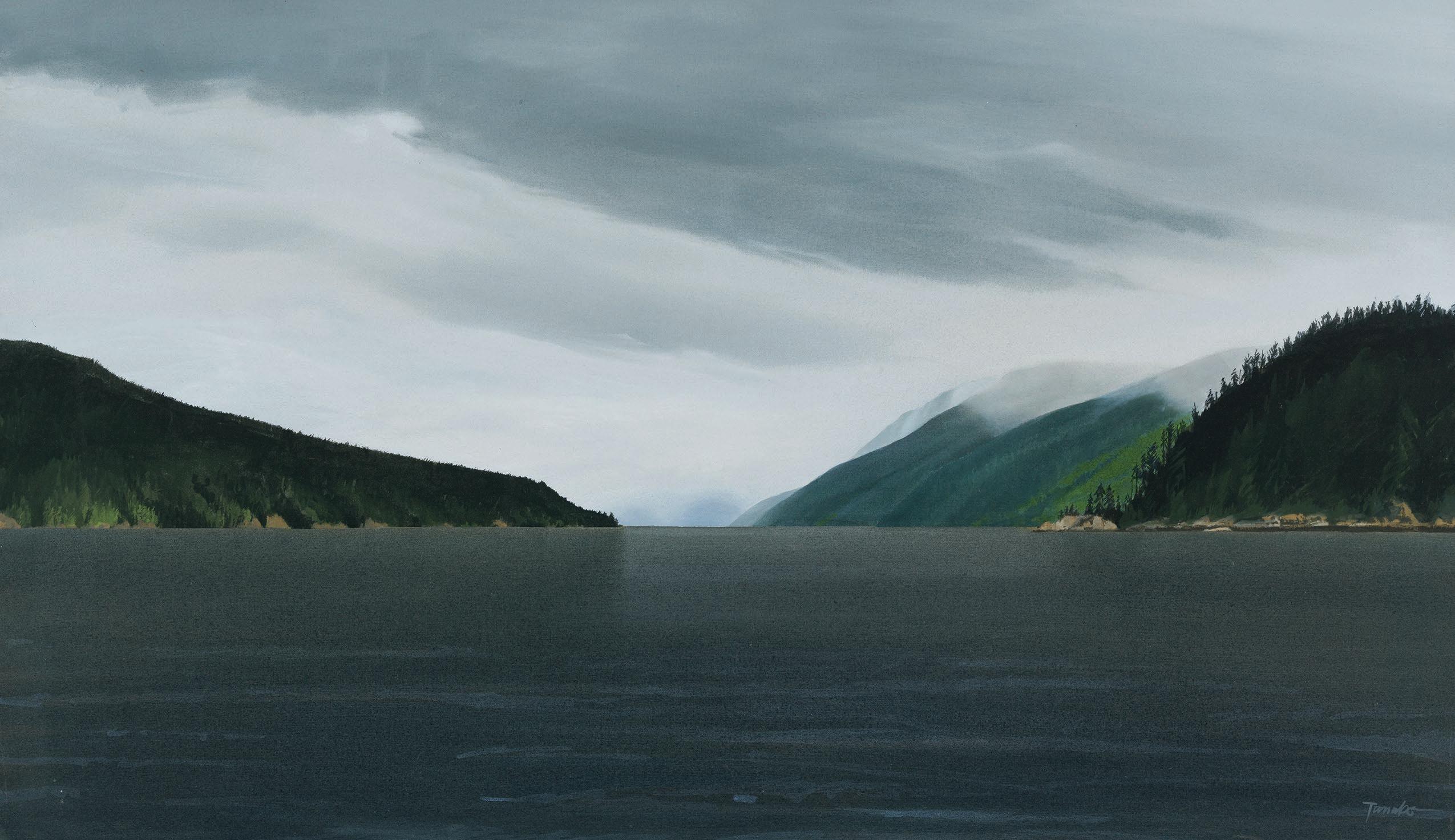
14
Tanabe
Alberni Inlet 1/96
acrylic on canvas, signed and on verso signed, titled, dated 1996 on the Equinox Gallery label and inscribed Errington 32 × 55 in, 81.3 × 139.7 cm
Proven A nce
Equinox Gallery, Vancouver Private Collection, Vancouver
T AKAO T ANABE GREW up in Seal Cove, a small fishing village that is now part of Prince Rupert, on British Columbia’s northern coast. On his return to the coast in 1980 from Banff, he settled in Errington, on Vancouver Island. A self-described minimalist, Tanabe began to paint simplified coastal landscapes, depicting nature without human presence. He builds his images with up to nine layers of paint, smoothly applied, creating a floating, trans parent surface. Here, Tanabe depicts Alberni Inlet, a long, narrow fjord that runs inland from the Pacific Ocean towards Port Alberni on Vancouver Island. In this dramatic painting, layers of clouds parade across the sky in a diagonal movement, and the progres sion of tones in the overcast sky moves from stormy darkness to lighter grey and a glowing pale grey at the horizon. Tanabe often uses this device of funneling towards a brightness on the horizon, thereby creating a focal point of uplifting light. Dark landforms and looming mountains capped by descending mist intensify the moody atmosphere. The opaque ocean, a steel-grey tone unique to these coastal waters during such weather conditions, laps towards us in soft waves. Alberni Inlet 1/96, with its magisterial beauty, is a superb Tanabe painting.
15 5 Takao
OC 1926 –
e stim A te: $ 60,000 – 80,000
Low Tide at Crofton Beach
watercolour on paper, signed and dated 2000 and on verso signed, titled and dated 18 × 24 in, 45.7 × 61 cm
Proven A nce
Private Collection, British Columbia
By descent to the present Private Collection, British Columbia
l iter A ture
Jacques Barbeau, The E.J. Hughes Album: The Paintings, Volume 1, 1932 – 1991, 2011, the 1979 oil Low Tide at Crofton Beach reproduced page 73
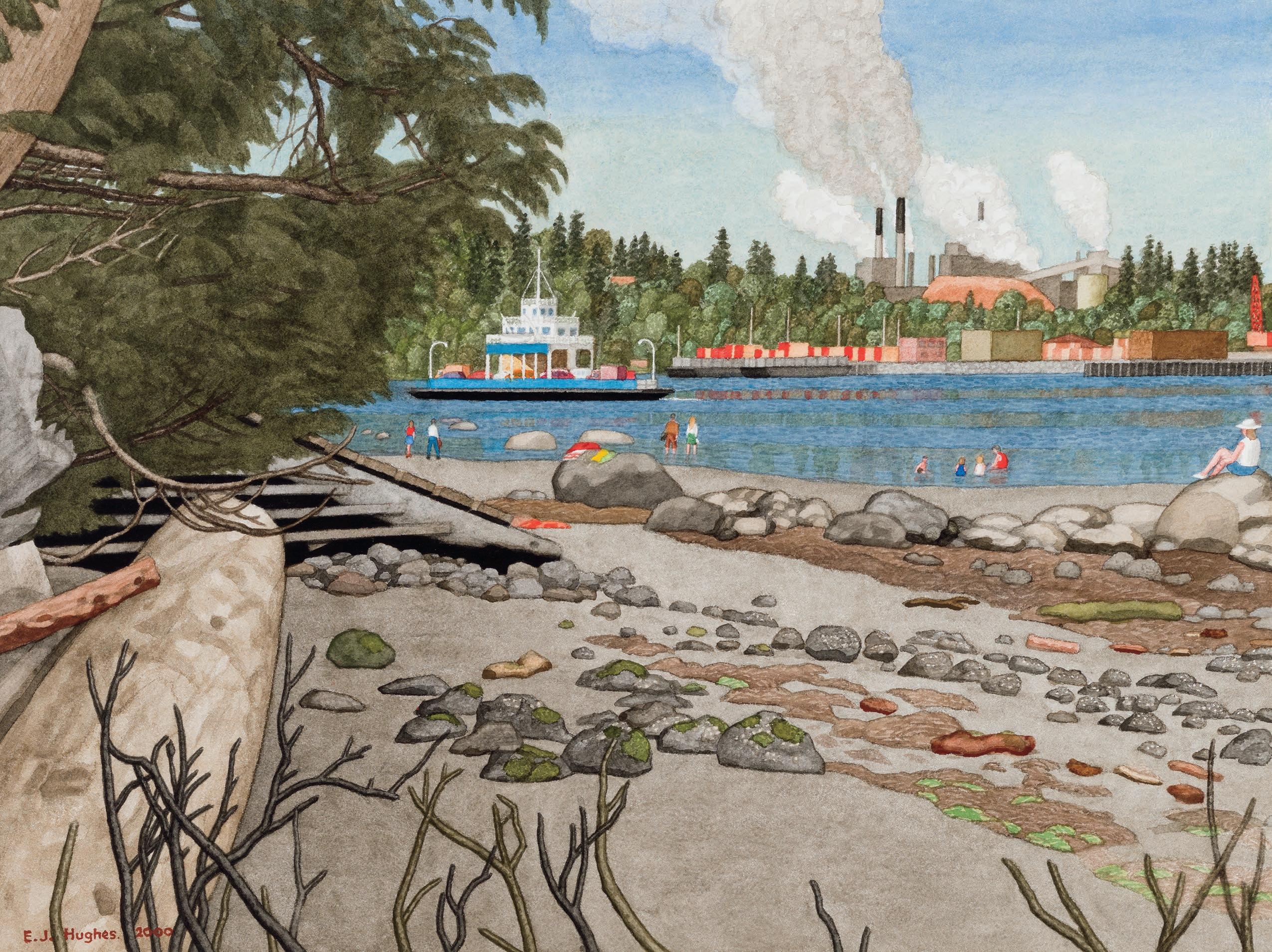
O NE O f E.J. H UGHES ’ S favourite subjects was Crofton, a town with a deep-water port and a ferry terminal for Saltspring Island. In the background is a pulp and paper mill; on the east shore of Vancouver Island, industry existed side by side with nature, and Hughes found these juxtapositions interesting. As early as
1939, Hughes explored this subject with Orville Fisher and Paul Goranson in a suite of 12 murals with themes of British Colum bia’s industry and life, created for the Golden Gate International Exposition in San Francisco.
In Low Tide at Crofton Beach, Hughes deploys a striking per spective along the beach towards the ferry terminal and mill, and depicts numerous people enjoying the ambience of the shore. The composition is meticulously thought out: after passing over the foreground screen of branches, everything points forward—the huge driftwood log leads the eye to stairs to an unseen house, and then lines of rocks lead the eye along the beach to the small ferry, an iconic image in Hughes’s work. The natural colour palette is punctuated by splashes of colour: beach towels draped over a boulder, bright hues of clothing, the cars on the ferry, and the red ends of stacked lumber on the mill dock.
After 1991, Hughes exclusively painted watercolours. He often returned to past subjects, as he did here, to a 1979 oil, and this remarkable work showcases Hughes’s technical prowess and his refined compositional skills.
16
e stim A te: $ 40,000 – 60,000
6 Edward John (E.J.) Hughes
BCSFA
CGP
OC RCA 1913 – 2007
The Museum at Crofton, BC watercolour on paper, signed and dated 1996 and on verso signed, titled and titled The Museum, Crofton, BC on the Dominion Gallery label, dated and inscribed B 9370 and with the Dominion Gallery Inventory #F 9410 on the gallery label 18 × 24 in, 45.7 × 61 cm
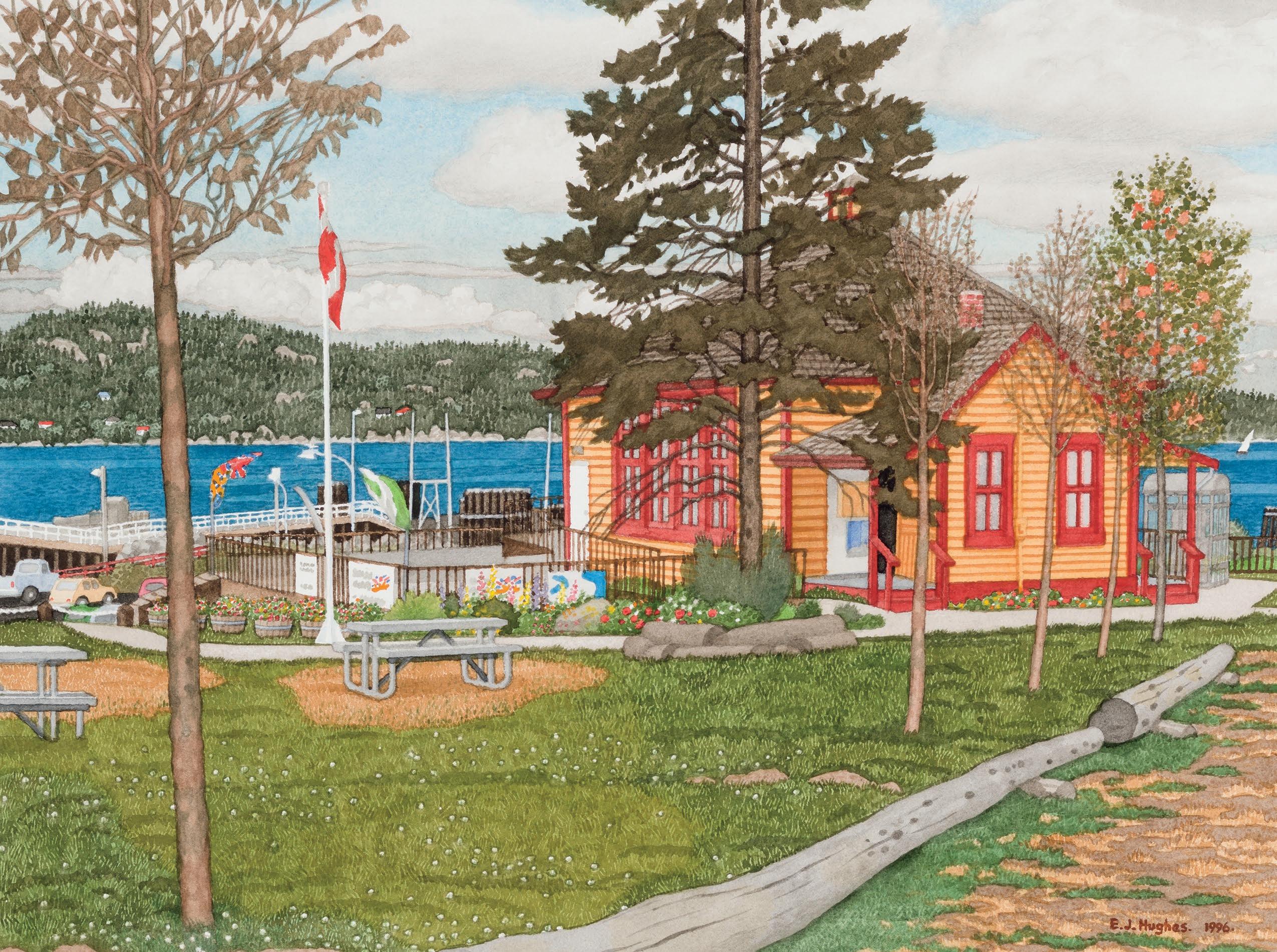
Proven A nce Dominion Gallery, Montreal
An Important Private Collection, Vancouver
E.J. H UGHES O f TEN painted Crofton, a small town not far from his home in Duncan, on eastern Vancouver Island. Here he depicts the Crofton Old School Museum. Set in a former oneroom schoolhouse on the town’s waterfront, it contains displays based on the history of Crofton and the surrounding area, includ ing the industries of mining and forestry.
In 1991, Hughes turned from painting in oil to watercolour, referencing the plein air graphite sketches he had made over many years, annotated by field notes or colour maps he drew on separate sheets of paper. Hughes was a master of watercolour, as seen in this striking work. He varied his washes from transparent, as in the pale turquoise sky, to dense, as in the richly coloured schoolhouse and the dark foliage of the evergreen. This is a strong composition full of charming details, such as the sailboat to the right of the museum, the Canadian flag, and the cars at the bottom of the hill by the dock. The blooming plants around the museum and the patterning of small white flowers twinkling in the grass give warmth to the scene. Across from Crofton rise the hills of Saltspring Island, and the billowing cumulus clouds hover ing above them add a dreamy feeling to this bucolic setting.
Consignor proceeds will benefit Ballet BC , Food Stash Foundation and the y MCA of Greater Vancouver.
17
e stim A te: $ 40,000 – 60,000
7
Edward John (E.J.) Hughes BCSFA CGP OC RCA 1913 – 2007
Artist
Collection,
William Moore and Stuart Reid, Celebrating Life:
Art of Doris McCarthy, McMichael Canadian Art Collection, 1999, pages
S TARTING IN 1974 , one of Doris McCarthy’s favourite places to visit over many years was Newfoundland. In early trips, McCarthy traveled to the province’s isolated outports by supply boat, which was often the only way to access them. She desired to represent all of Canada in her work—from the Rockies to the Atlantic provinces and the North—and captured the unique
essence of whatever location she painted. In Newfoundland, McCarthy takes a folk art approach in her style, depicting the elements of the scene with simplicity and clarity. Houses are reduced to their unadorned essentials—simplified walls, windows and roofs—with boats and boathouses painted in the same style. She communicates the warmth of these small communities— people greet each other on the path, while behind them, animals have a humorous faceoff. There is a remarkable stillness to the scene, in the motionless boat reflections, the suspended clouds, and the green glow of the hillside basking in the radiance of the sunny day.
Group of Seven member A.J. Casson called McCarthy “a remarkable woman who developed her own vision and stuck to it.” Later, art historian Jeffrey Spalding stated that McCarthy’s work “provided the link between the Group in the twenties and thirties and the artists who emerged in the sixties.” Newfoundland expresses McCarthy’s revelatory sense of this special place.
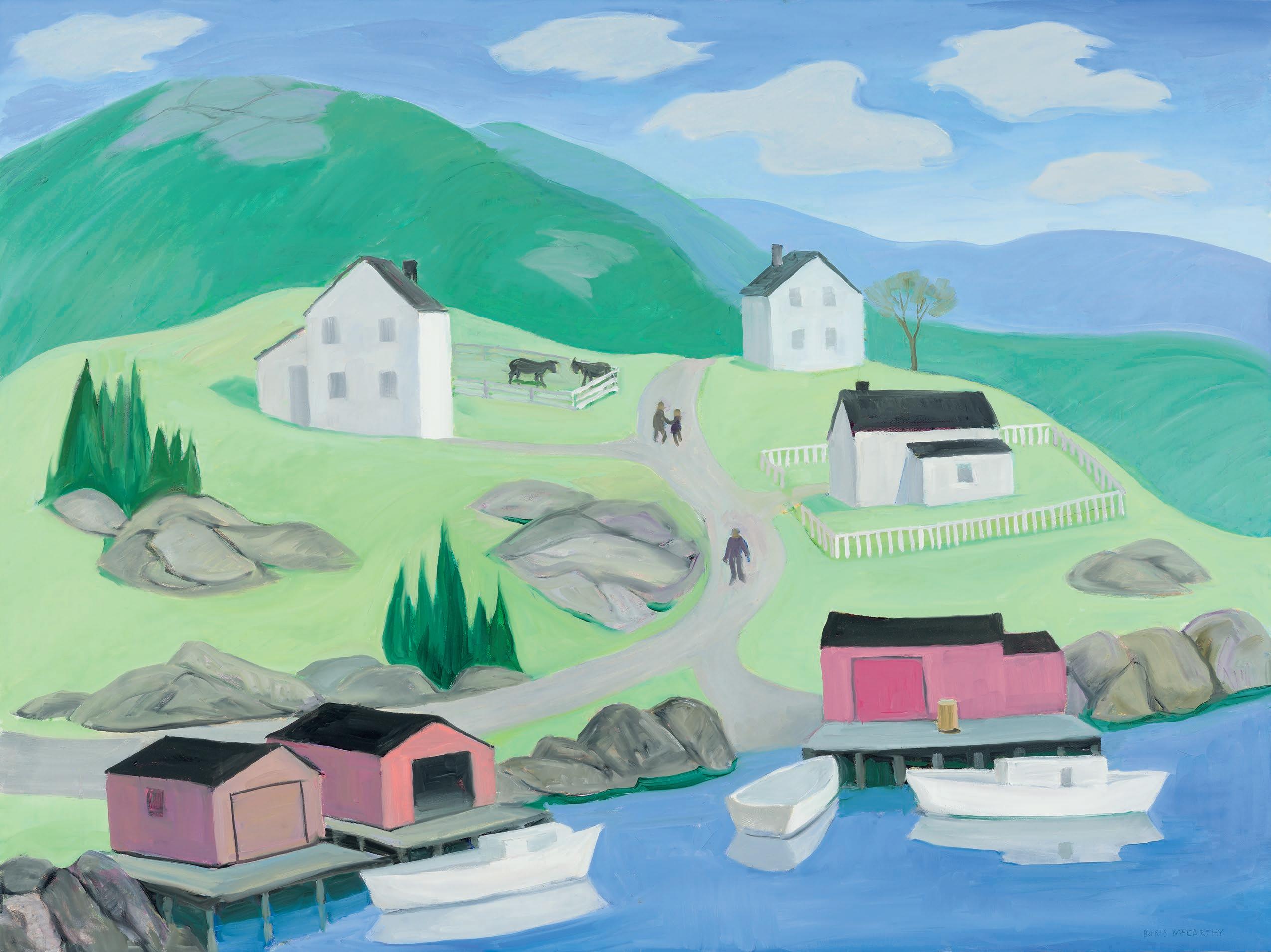
18
e stim A te: $ 20,000 – 30,000 8 Doris Jean McCarthy CSPWC OC OSA RCA 1910 – 2010 Newfoundland oil on canvas, signed and on verso dated 2005/02/14 36 × 48 in, 91.4 × 121.9 cm Proven A nce Estate of the
Private
Alberta l iter A ture
The
84 and 178
9 Doris Jean McCarthy
Three Peaks Plus, Above Ice Shapes
on canvas, signed and on verso titled and dated 2005/03/27
× 48 in, 91.4 × 121.9
A nce
of the Artist
Collection, Alberta
William Moore and Stuart Reid, Celebrating Life: The Art of Doris McCarthy, McMichael Canadian Art Collection, 1999, page 214
fROM HER f IRST trip to the region in 1937, to Edith and Maligne Lakes, Doris McCarthy was fascinated with the majesty and solitude of the Canadian Rockies. Much later, she returned yearly from 1974 to 1980, painting at such stunning locations as Banff, Golden and Jasper. This dramatic Jasper scene captures the bold shapes of towering mountains, their glaciers melting and running
down channels in the rock surface. McCarthy’s admiration for the Group of Seven can be observed in her work, particularly for Lawren Harris, whose studio she visited in 1928. She was inspired by his use of sculpted forms pared to their essential shapes, as seen in her depiction of these peaks many decades later.
Paul Gauguin wrote: “Don’t copy nature too closely. Art is an abstraction; as you dream amid nature, extrapolate art from it.” McCarthy does just that in her unique interpretation of this majestic scene, using simplified shape, colour and line. Glacial runoff is distilled to curves of blue running through featureless white snow, banks of trees are rendered as a ribbon of green, and clouds appear as oval shapes. The abstracted quality of Three Peaks Plus, Above Ice Shapes intensifies this landscape, giving it tremendous impact.
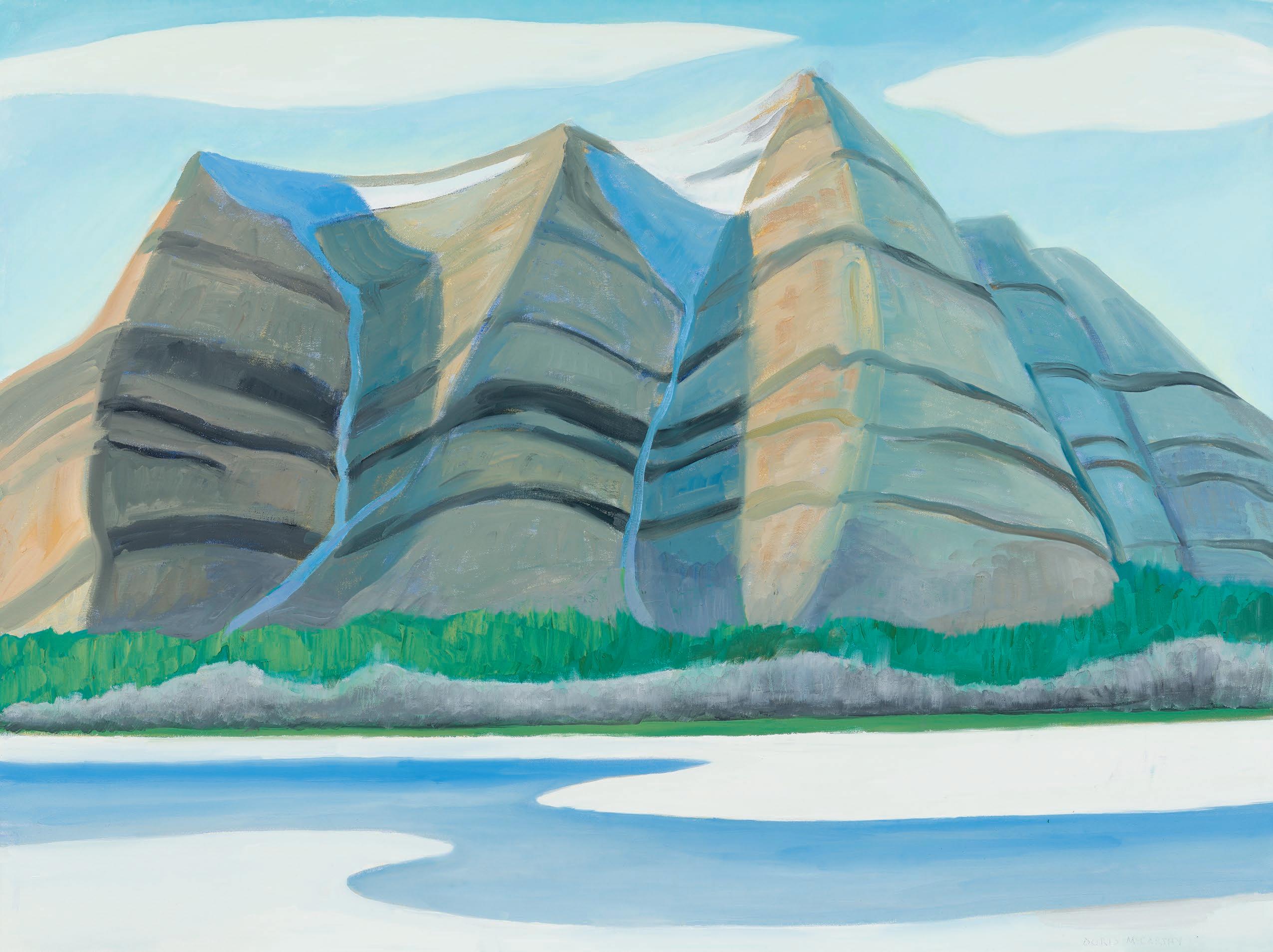
19
e stim A te: $ 20,000 – 30,000
CSPWC OC OSA RCA 1910 – 2010
oil
36
cm Proven
Estate
Private
l iter A ture

20
Blue, Red #4
acrylic on canvas, on verso signed, titled, dated May 1969, inscribed Top (with arrow) and Acrylic Polymer W.B. and stamped André Emmerich Gallery 87 3/4 × 55 1/4 in, 222.9 × 140.3 cm
Proven A nce
Collection of the Artist David Mirvish Gallery, Toronto Charles Millard, Washington, d C , 1971 – 1978 André Emmerich Gallery, New York Ethan Stroud, Texas
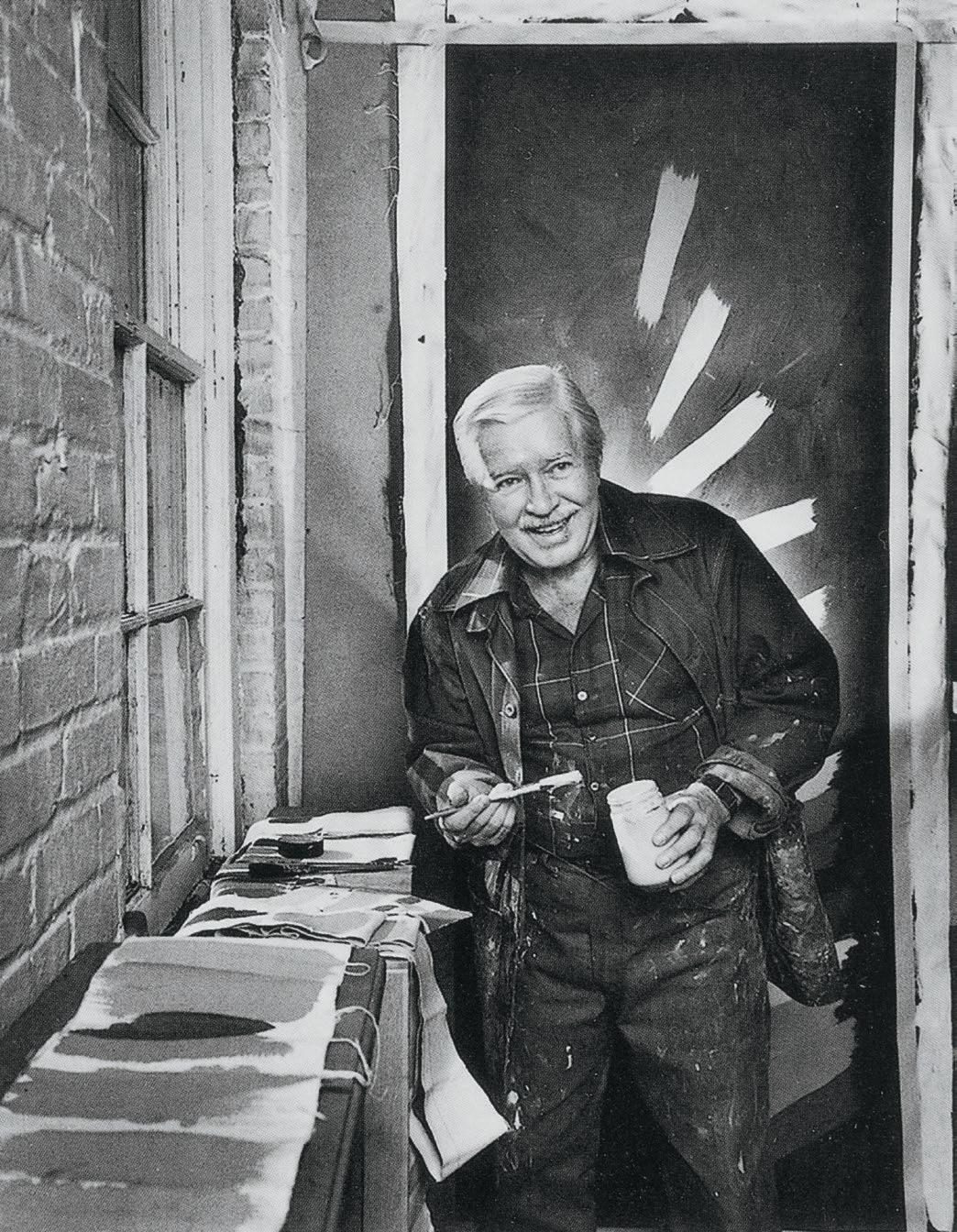
Contemporary Art, Christie’s New York, November 12, 1980, lot 54 André Emmerich Gallery, New York Marcel Elefant, Montreal, 1981 – 1991 Private Collection, Montreal, 1991 – circa 2006
Miriam Shiell Fine Art, Toronto Marilyn and Charles Baillie Private Collection, California
l iter A ture
Karen Wilkin, editor, Jack Bush, 1984, reproduced page 137
H OWEVER ABSTRACT J ACK B USH ever got, the real world always touched his work in one way or another. In the case of Blue, Red #4, the true inspiration for the painting was out of this world. The artist’s second record book, in which he logged his paintings from about 1961 through 1973, reveals that this painting was ini tially titled Moon Approach. Although Bush crossed out this more
21 10 Jack Hamilton Bush ARCA CGP CSGA CSPWC OSA P1 1 1909 – 1977
Jack Bush, November 1974 Photo: Yousuf Karsh Courtesy of the Estate of Yousuf Karsh
descriptive title, the painting’s shapes and colours remain connected to its core influence: the Apollo 10 mission to orbit the moon.

Bush painted this abstract canvas between May 28 and May 30, 1969, just days after NASA’s Apollo 10 mission returned to Earth on May 26. Apollo 10 was the dress rehearsal for Apollo 11, which landed humans on the moon later that summer, on July 20, 1969. Until then, Apollo 10 was the closest a manned spacecraft had ever gotten to the moon. On the mission’s fourth day, astronauts flew the lunar module within 14.5 kilo metres of the moon’s surface. The lunar module was nicknamed Snoopy on account of Apollo 10’s mandate to pass close to the moon’s surface so they could capture images to help prepare for the future mission’s landing.
Most notably, Apollo 10 made the first live colour TV broadcast from space. According to NASA , Apollo 10’s several TV broadcasts caught the attention of more than a billion people who watched from home. Viewers saw their own planet appear smaller and smaller and, even tually, it was seen to rise above the lunar horizon. The Bushes owned a colour TV, and this live footage of the spacecraft’s moon approach undoubtedly made an impression on the artist. The line in Bush’s painting resembles a pivoted hori zon line, just like so many of the images transmitted from the Apollo 10 mission, which made vertical passes over the lunar surface (figure 1). In the painting, the two half-shapes on either side of the red line recall the shape of the Earth, half in shadow, as it rose over the moon’s sur face. With two of these shapes on either side of the line, it is possible that one rep resents the Earth (seen from the moon) and the other represents the moon (seen from the Earth).
The colours in this painting are so distinct that they earned their place in Bush’s revised title, Blue, Red #4. The background is overtly sky blue and, how ever abstract this composition may be, it exudes a sense of positivity like the great blue yonder. More literally, it is the kind of blue that backdrops virtually all rocket launches seen on TV. Even more specifically, the red line might have

22
FIGURE 1: Earth from the Moon, AS 10-27-3892
Photo: Apollo 10 Magazine 27/N Courtesy of Apollospace
FIGURE
2:
The Moon from Apollo 10, AS 10-34-5108
Photo: Apollo 10 Magazine 34/M Courtesy of Apollospace
been inspired by the curious red line created by the window of the spacecraft seen in several photos and TV broadcasts from Apollo 10 (figure 2).
On a purely aesthetic level, Bush had been experimenting with the contrast between red and blue in his paintings from the beginning of 1969. In January he painted Red, Blue #1 and in Feb ruary he painted Red, Blue #2. The last two paintings in this quasi series, Blue, Red #3 and Blue, Red #4, were both painted in May and bear titles with a slight variation from the first two. Unlike the first three paintings, Blue, Red #4 does not boast a multico loured fringe of stripes along its bottom half. Paradoxically, this painting is the most starkly abstract composition, and yet it is the
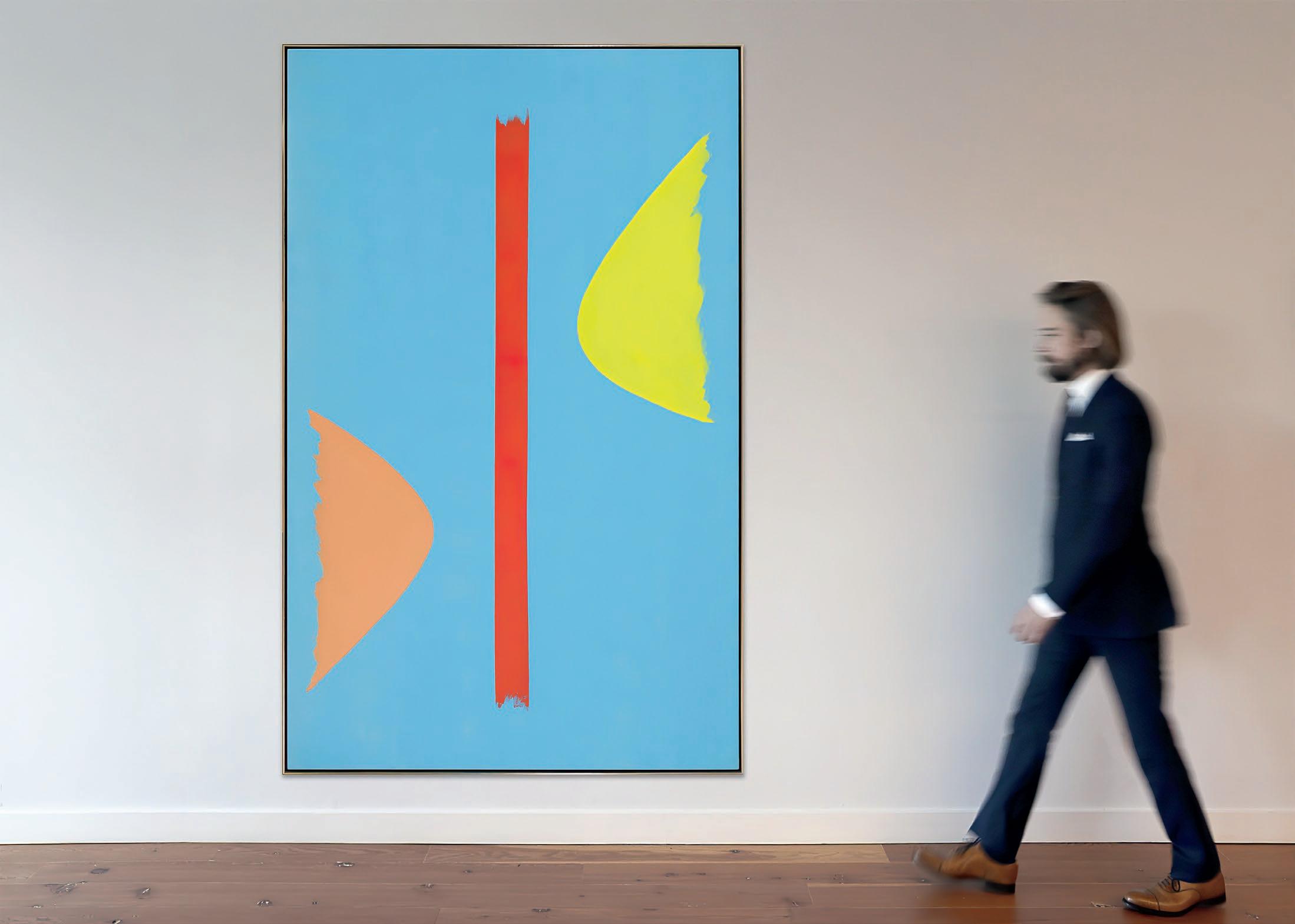
most referential. Blue, Red #4 marks a shift in our world view. The revolution (around the moon) was being televised, and it was in full colour.
We thank Dr. Sarah Stanners, director of the Jack Bush Catalogue Raisonné, contributor to the Bush retrospective origi nating at the National Gallery of Canada in 2014, and assistant professor at the University of Toronto, Department of Art History, for contributing the above essay.
This work will be included in Stanners’s forthcoming Jack Bush Paintings: A Catalogue Raisonné.
e stim A te: $ 400,000 – 500,000
23

24
Zephrus #2
oil on canvas, signed and on verso signed, titled and dated 1967 52 3/4 × 69 3/4 in, 134 × 177.2 cm
Proven A nce
Family of the Artist
l iter A ture
John Climer, Eleven Saskatchewan Artists, Mendel Art Gallery, 1967, unpaginated
Zephrus #2, A f TER Zephyrus, god of the west wind and herald of spring in Greek mythology, is an apt title for this wonderful canvas by William Perehudoff. It contains in its composition and colour combinations a joyful freshness, and a lightness of touch that still retains an inherent strength. The playfully asymmetric forms might suggest a windmill, or even a child’s pinwheel, but aside from any potential interpretations, what remains unavoid able is the artist’s inquisitive, keen and buoyant belief in what he called “the optimism of colour.”
Perehudoff was part of an emerging generation of abstraction ists in the 1950s and 1960s, and he was influenced, as was his peer and contemporary Jack Bush, by New York critic Clement Greenberg. Perehudoff’s canvases from the 1960s are some of his rarest and most sought after; they capture the artist’s first, exhilarating engagement with the ideas and approaches that would guide the rest of his career.
e
stim A te: $ 30,000 – 50,000
25 11 William (Bill) Perehudoff OC RCA 1918 – 2013
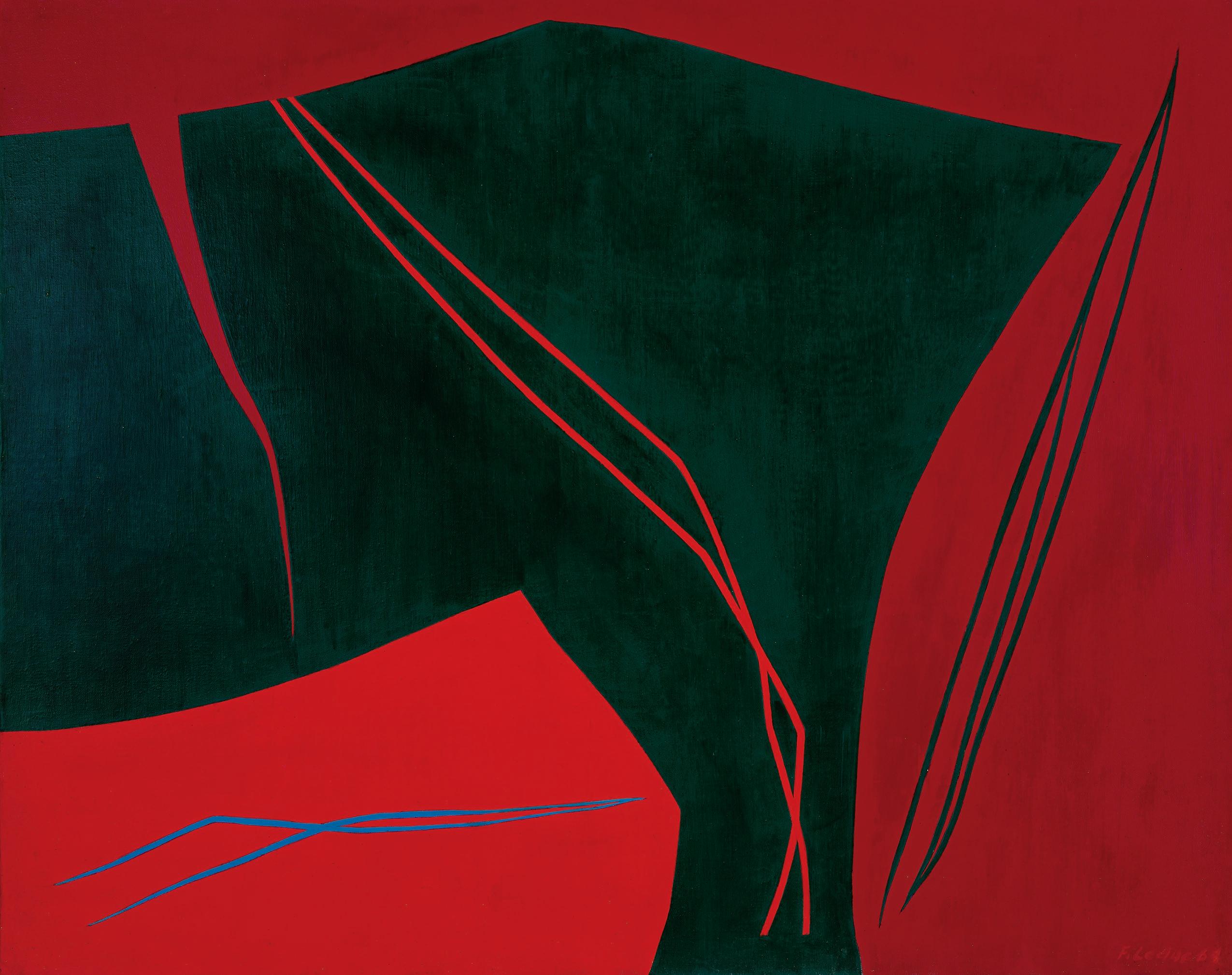
26
Fernand Leduc
Vibration vert-rouge
oil on canvas, signed and dated 1963 and on verso inscribed Musée d’art contemporain, Cité du Havre, Montréal and 4500 F and stamped with a customs stamp
1/2 × 36 in, 72.4 × 91.4 cm
Proven
Acquired directly from the Artist by a Private Collector, Montreal, 1970 Private Collection, Montreal
Fernand Leduc in Rea Montbizon, “On Gallery Avenue,” Montreal Gazette, October 2, 1965, page 22
Bernard Teyssedre, Fernand Leduc, Musée d’art contemporain, Montreal, 1971, listed, unpaginated
Musée du Québec, Quebec City, Fernand Leduc, March 9 – April 4, 1966
Musée d’art contemporain, Montreal, Fernand Leduc, April 14 – May 8, 1966
Musée d’art contemporain, Montreal, Rétrospective Fernand Leduc, December 9, 1970 – January 17, 1971, catalogue #70
What is essential is to arrive at the greatest intensity with the simplest means. I have to look for the most intense colour to achieve the most intense response and create the most dynamic results Shape and colour have to interact in such a way that both contribute equally to the result of dynamisme.
fERNAN d lE d UC , Montreal Gazette, 1965
Vibration Vert-rouge IS the embodiment of Fernand Leduc’s thoughts quoted above. In this minimalist composition typical of his 1960s hard-edge works, he created a dynamic and vibrating painting. He organized intricate organic shapes of intensely satu rated red, maroon and dark green, over which zigzag calligraphic red, green and blue lines. Leduc’s acute understanding of chro matic relations and tensions is on full display in the sleek surface of this canvas.
Leduc was an artist of many revolutions. He was one of the 16 signatories of the Refus global manifesto, and he adopted the Automatist gestural approach to painting early in his career. Then, in 1955 and throughout the 1960s, he moved towards geometric, hard-edge abstraction similar to the work of the Plasticiens. In 1970, he started working on a series titled Microchromies, con sisting of monochromatic paintings with extremely subtle tonal variations. Over the course of his career, Leduc streamlined his visual language to focus on colour, shape and light, ultimately achieving the “greatest intensity with the simplest means.” Vibration vert-rouge is a stunning example of the artist’s unique approach to hard-edge abstraction.
27
e stim A te: $ 25,000 – 35,000 12
AANFM AUTO CAS LP QMG 1916 – 2014
28
A nce
l iter A ture
e xhibited
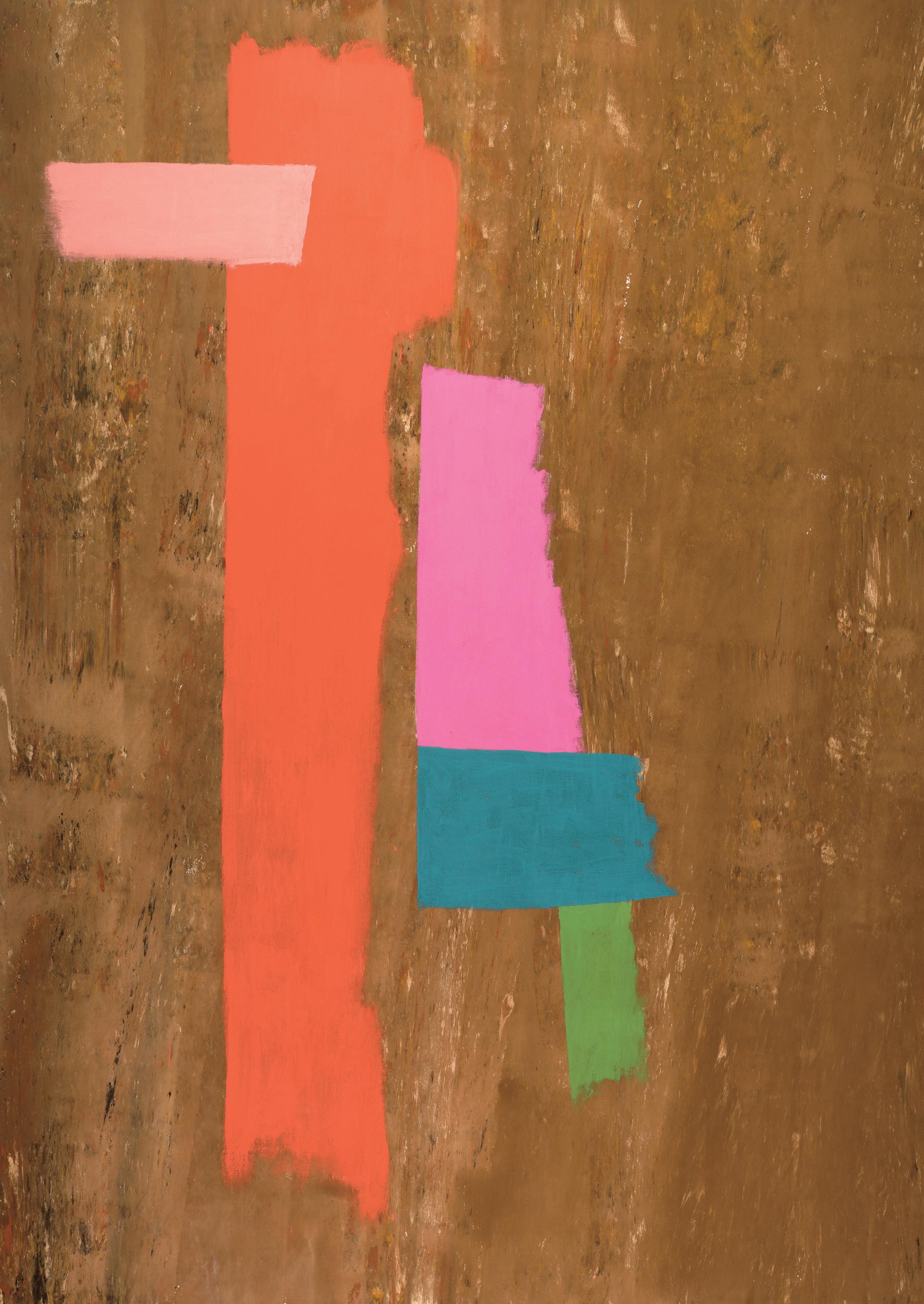
28
13 Jack Hamilton Bush
Orange Totem
acrylic on canvas, on verso signed, titled, dated November 1973 and inscribed Top (with arrow) / Toronto / Acrylic Polymer W.B. 87 × 62 in, 221 × 157.5 cm
Proven A nce
David Mirvish Gallery, Toronto, April 1974
Ronald Baker, Toronto, July 1974
Malcolm Fisher, 2019
Private Collection, Toronto
David Mirvish Gallery, Toronto, Jack Bush: Recent Paintings, 1974
I N THE SPRING of 1974, Orange Totem made its debut in a solo exhibition titled Jack Bush: Recent Paintings at David Mirvish Gallery. By summertime, the painting was acquired by a private collector, who kept it for 45 years. Orange Totem is, as its title indi cates, a part of Jack Bush’s Totem series, which totals 21 paintings made between 1973 and 1974. These paintings are prized by their owners. Remarkably, the majority of the Totem paintings (16 out of 21) were retained by their private owners for at least 30 years before they changed hands, if at all.
Characterized by flat sections of bold colour stacked one atop the other, each painting in the Totem series is highly original. Orange Totem features shapes of colour that have migrated to produce an adjacent smaller stack of colours, making it the first side-by-side or double totem in the series. Rather than form or symbology, Bush was concerned with achieving the most effec tive syntax or arrangement of colour in each Totem painting. Akin to Hans Hofmann, whose rectilinear blocks of colour emphasize the surface of the abstract composition, Bush maintains a sense of active tension between his high-key colour combinations. In Orange Totem, the intensity of colour is pumped up by the sharp contrast between the hot and cold colours: orange against blue and pink against green. As Roald Nasgaard observed in his review of the exhibition of Bush’s recent work in 1974, the colours pres ent in his new work could “exert themselves with the full sonority of the mid-sixties pictures which perhaps until now have not been surpassed.” 1
The coexistence of rough edges and hard edges on these flat figures of colour work similarly as reminders of the real subject of the picture: paint on canvas. Paradoxically, these colourful swatches illustrate painterly gestures without indulging in the action of painterly gesture. The same challenge is met with the
mottled ground. Bush had first produced a mottled ground in 1969, when he aimed to replicate the surface of a rock. This background teases the tenets of post-painterly abstraction on two levels: it achieves the look of texture without actually being textured (depth is denied), and these deceiving variations of dark, light and mid-tone browns are endlessly varied without a single flick of the wrist. Bush rolled on these grounds after dipping his roller into unmixed paint. Any gestural mark made in this process was a purposeful product of chance, the purpose being to exclude the old value of virtuosity in painting.
Bush had been a painter since the late 1920s but, by 1973, he was a recognized and respected leader amongst American abstract painters. Curator Kenworth Moffett had organized a survey of Bush’s mature paintings that opened as the inaugural exhibition for the new contemporary art wing at the Museum of Fine Arts, Boston, in February 1972. Moffett’s preface to the exhi bition catalogue indicates the positive reception of Bush’s work abroad, as he stated:
From a historical point of view Bush’s most recent paintings seem to synthesize the kind of graphic improvisations found in Miró and Gottlieb with the American color painting. They also recall certain aspects of Matisse, especially in their color and in their handling of figure-ground relationships. But beyond all comparisons and influences, they are the work of a very original artistic personality. They show that assurance and freedom of a major painter at the height of his powers.2
Painted just a matter of months after Moffett’s praise was published, Orange Totem is a testament to Bush’s late-career confidence and innovative spirit.
We thank Dr. Sarah Stanners, director of the Jack Bush Catalogue Raisonné, contributor to the Bush retrospective origi nating at the National Gallery of Canada in 2014, and assistant professor at the University of Toronto, Department of Art History, for contributing the above essay.
This work will be included in Stanners’s forthcoming Jack Bush Paintings: A Catalogue Raisonné.
1. Roald Nasgaard, “Toronto: Jack Bush at David Mirvish,” Arts Magazine 48, no. 9 (June 1974): 70.
2. Kenworth Moffett, Jack Bush Exhibition for the Inauguration of the New Contemporary Gallery (Boston: Museum of Fine Arts, 1972), exhibition catalogue, unpaginated.
e stim A te: $ 250,000 – 350,000
29
ARCA CGP CSGA CSPWC OSA P1 1 1909 – 1977
e xhibited
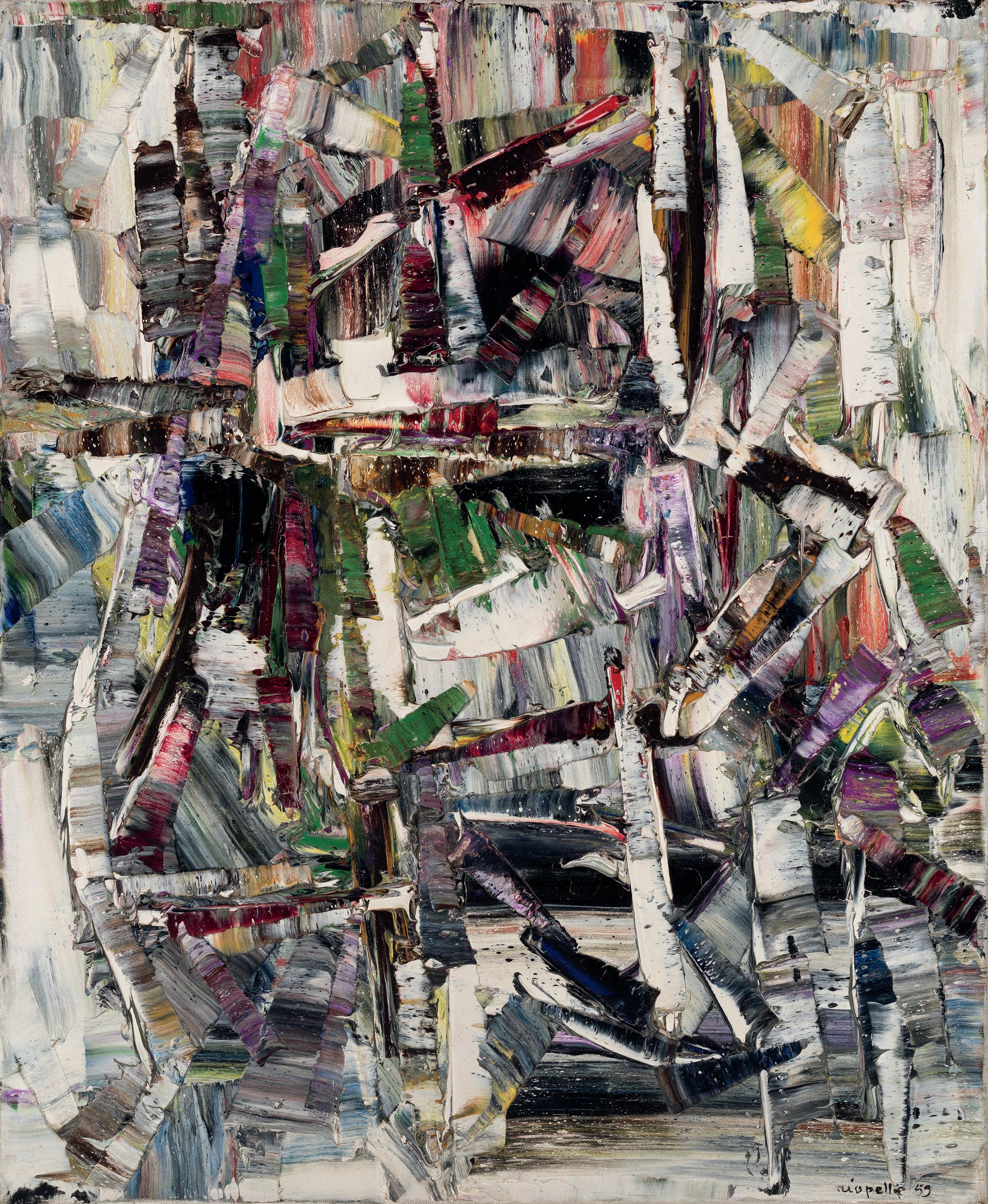
30
Jean Paul Riopelle
Engloutis
oil on canvas, signed and dated 1959 and on verso titled and dated on a gallery label 28 3/4 × 23 1/2 in, 73 × 59.7 cm
Proven A nce
Pierre Matisse Gallery, New York Marlborough-Gerson Gallery Inc., New York
Important Canadian Art, Sotheby’s Canada in association with Ritchie’s, November 18, 2003, lot 116 Private Collection, Toronto
l iter A ture
Gilles Vigneault et al., Jean-Paul Riopelle, Montreal Museum of Fine Arts, 1991, pages 34 and 35 Yseult Riopelle, Jean Paul Riopelle Catalogue Raisonné, Volume 2, 1954 – 1959, 2004, reproduced page 319, catalogue #1959.010 H /1959
T
HIS IS AN outstanding example of Jean Paul Riopelle’s work from 1959 to 1960 discussed by Herta Wescher in a 1960 article in Cimaise. As she described these works: “The dense mosaics characteristic of his paintings of ten years ago have been bro ken up, allowing space to enter from all sides. Now order and chaos intermingle; diagonals, curves and sharp hooks attack the verticals, voids are trapped at the heart of incredibly crowded centres . . . ” During this time, Riopelle gave his works titles more evocative of landscape, and Engloutis, which translates as “engulfed or swallowed up,” perhaps refers to density in natural growth. This work is infused with a vital power created by its thick layers of paint and the sheer innovative variety of knife-strokes, which interact in every direction. They vibrate both on the sur face and in depths of dimensionality. Riopelle’s knife-strokes still relate to his mosaic work, but they do not form the tight pattern of such paintings as Pavane, his masterpiece canvas from 1954. Spears of white rise up from pale grounds and over depths of black, while multicoloured hues explode everywhere. Engloutis is a painting of tremendous vitality, drawing our eye, as Harry Bellet writes, “in headlong pursuit of the painter’s frenetic brushwork.”
e
A te: $ 150,000 – 250,000
31 14
AUTO CAS OC QMG RCA SCA 1923 – 2002
stim
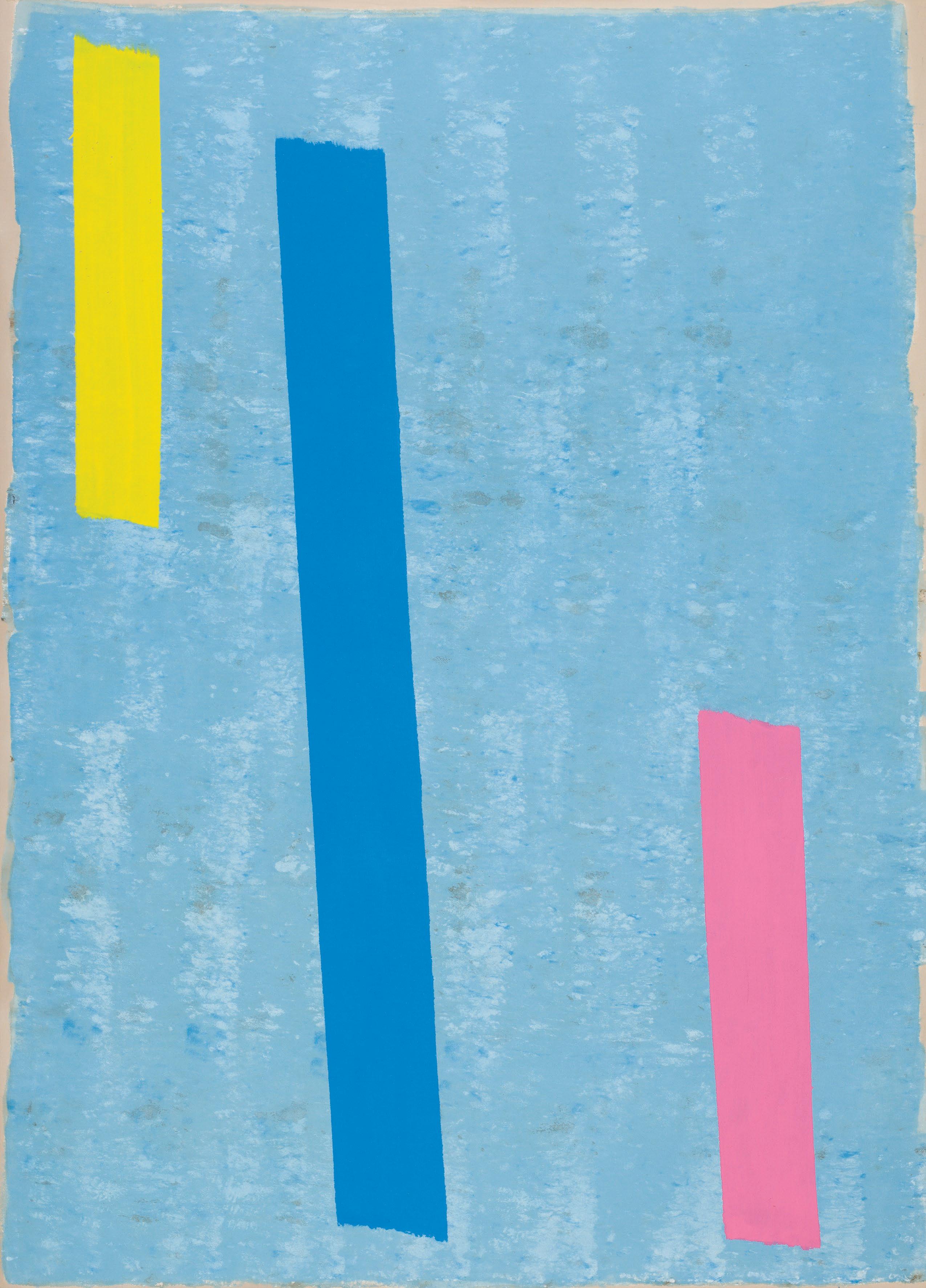
32
Jack Hamilton Bush
Summer Lake
acrylic on canvas, on verso signed, titled, dated January 1973 and inscribed Toronto and Top twice 68 1/4 × 49 3/4 in, 173.4 × 126.4 cm
Proven A nce
André Emmerich Gallery, Zurich, March 1973
Downstairs Gallery, Edmonton
Rothmans, Benson & Hedges Inc. Private Collection, Vancouver
l iter A ture
John Mclean, “Jack Bush: Recent Paintings,” Studio International, vol. 188, no. 968, July – August 1974, pages 27 – 29, reproduced page 29
André Emmerich Gallery, Zurich, Switzerland, Jack Bush: Neue Bilder, March 30 – April 27, 1974
J ACK B USH ENJO y E d cottage life, and most summers, the Bush family rented a lakeside cottage in Ontario. In the 1940s, they stayed near the town of Tiny on Thunder Beach. Through the 1950s, the Bush family cottaged at Lake of Bays in Muskoka. These are just a couple of examples of Bush’s vacation spots that he usually traveled to in the month of July, during which he enjoyed painting his surroundings at leisure. Summer Lake, how ever, was painted between January and February 1973, no doubt based on a desire to get away from the worst months of winter in Toronto, even if only on canvas.
As early as 1952, Bush began to experiment with abstracting lakeside subjects. At first, with paintings such as Summer Day (1952), islands and trees were reduced to flat, geometric shapes in bright colours, but their position in the composition remained logical, including a green triangular shape amid blue below for water and blue above for sky. Soon after, landforms and water bodies became more wholly abstract, merging foreground with background, often creating an irregular patchwork of colour, as
seen in paintings such as Hazel—Crooked Lake (1954). By the 1970s, when Bush painted Summer Lake (1973), his compositions were so completely abstract that the title of the painting stands as the only remaining reference to the subject.
In his Wolseley Street studio, Bush often had more than one painting on the go. When executing Summer Lake, the artist prepped a second piece of canvas, upon which he made a painting he called Wet Sand. He worked on these two paintings simul taneously, primarily guided by his focus on colour and ground effects—but nature’s mastery of colour was never far from Bush’s mind and eye. Like the surface of water, or the surface of a beach, it was nature that inspired Bush’s first mottled-ground paintings in 1969. On a trip through Ireland, Bush was impressed by the field markers he saw along the roadsides. Thinking of these stark symbols painted on large stones, Bush returned to his studio in Toronto intent on replicating rock surfaces. In October 1969, Bush executed Irish Rock #1 and Irish Rock #2 using a roller and unmixed paint, not unlike his method for making Summer Lake. With the Irish Rock paintings, however, Bush aimed to represent what he saw when creating the grounds. Summer Lake, on the other hand, leaves the representation of nature behind in favour of representing the challenges of abstraction.
Like no other modernist painter, especially amongst his Colour Field peers, Bush flirted with texture and depth while his works remained utterly flat. Like a still lake on a summer day, it is the surface tension that invites us to dive in.
We thank Dr. Sarah Stanners, director of the Jack Bush Catalogue Raisonné, contributor to the Bush retrospective origi nating at the National Gallery of Canada in 2014, and assistant professor at the University of Toronto, Department of Art History, for contributing the above essay.
This work will be included in Stanners’s forthcoming Jack Bush Paintings: A Catalogue Raisonné.
Artist markings on the reverse indicate that the artwork can be displayed vertically or horizontally. Summer Lake was presented vertically at the 1974 exhibition in Zurich.
e stim A te: $ 300,000 – 400,000
33
15
ARCA CGP CSGA CSPWC OSA P1 1 1909 – 1977
e xhibited

34
Paul Riopelle
Sans titre
oil on canvas, signed and on verso inscribed Mr Lamzman / Y -18614 / W 3068 / 4 , circa 1966 25 3/4 × 32 in, 65.4 × 81.3 cm
Proven A nce
Galerie Maeght, Paris Galerie Martal, Montreal Important Canadian Art, Sotheby’s Canada in association with Ritchie’s, May 27, 2003, lot 187 Private Collection, Toronto
l iter A ture
Yseult Riopelle, Jean Paul Riopelle Catalogue Raisonné, Volume 4, 1966 – 1971, 2014, page 39, reproduced page 116, catalogue #1966.053 H .1966
I T WAS C l AIME d that Jean Paul Riopelle did not like to paint if anyone was watching him. Nevertheless, there is an intrigu ing eyewitness account from book dealer Robert Keane, who recounted:
I will never forget this scene. First, he did not paint with a brush but rather with what looked like a putty knife. Second, judging by the hundreds of empty tubes that lay at his feet, he was using a phenomenal quantity of paint. He did not unscrew his tubes. He decapitated them in one move with his knife Red, blue, or green: the colours appeared suddenly at the tip of his fingers . . . he held all the tubes . . . as many as his hand could hold in his fist and then either poured them directly on the canvas or managed to have one colour mixing with the next by pressing the tubes in a certain way.
Riopelle’s use of colour in Sans titre is luxurious, and his paint work is tactile—built in ridges, swoops and squiggles. He loosely retained his mosaic approach of gathering layers of paint on his knife and revealing them in the swipes of his knife-strokes. Riopelle’s method of painting gave free rein to chance or acci dent, as the Surrealists put it, and his brushwork is the essence of freedom and unpredictability.
e stim A te: $ 150,000 – 250,000
35 16 Jean
AUTO CAS OC QMG RCA SCA 1923 – 2002
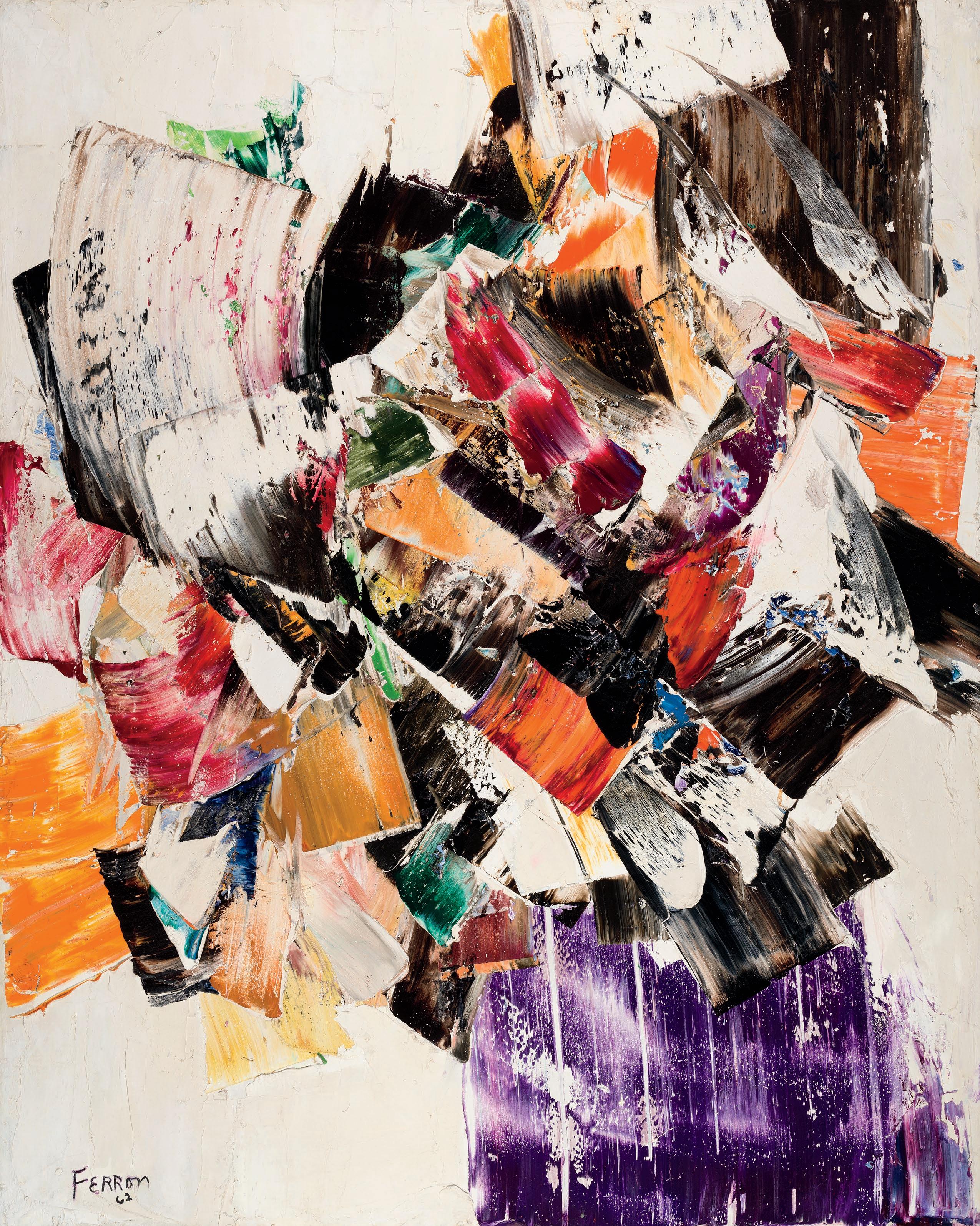
36
Marcelle Ferron
Sans titre
oil on canvas, signed and dated 1962 63 3/4 × 51 in, 161.9 × 129.5 cm
Pierre Roy, Montreal Private Collection, Toronto
Herta Wescher, Marcelle Ferron de 1945 à 1970, Musée d’art contemporain, 1970, listed, unpaginated Monique Crouillère, director, Ferron, Marcelle, National Film Board of Canada, 1989 A.K. Prakash, Independent Spirit, 2008, reproduced page 191
Musée d’art contemporain, Montreal, Marcelle Ferron de 1945 à 1970, April 8 – May 31, 1970, catalogue #62
T HROUGHOUT HER CAREER , Marcelle Ferron’s painting was defined by an expressive, exuberant approach to colour and gesture. After meeting Paul-Émile Borduas in 1946, she quickly became a powerful voice in the emerging language of Québécois painterly abstraction. Between 1953 and 1966, Ferron swapped Montreal for Paris, where she rapidly developed her technique and practice. She began to eschew the use of brushes in favour of palette knives. These would frequently be impressive in their own right—Ferron employed a metalsmith to custom build larger-than-normal tools in a variety of widths and lengths, up to a metre long. She also employed what she called “squeegees,” knives with a large blade fixed at right angles to the handle, which she would use for what she termed “great moments” or “rakings.” She would use these knives and spatulas to create ever larger and more fluid painterly gestures, pulling vibrant hues through white backgrounds to create rich, riotous fields of colour.
As she was limited in resources while in Montreal in the 1940s, the works that Ferron produced were by necessity modest in size, characterized by dense tessellations and subdued earth tones. In Paris, however, Ferron’s canvases were increasingly large, chromatic and dramatic, sometimes reaching monumental scale— such as this impressive example. Her paintings moved away
from the compactness of her earlier works and employed a more vibrant, expressive use of colour—at least partially as a response to a European market that demanded it—and, courtesy of a gen erous patron, she was able to use more expensive pigments. She would grind and mix these pigments herself, binding them with linseed and poppy-seed oils; the latter of these is lighter-coloured and yellows less with age, and is a medium particularly suited for the mixing of whites. Ferron was especially resolute in her use of white in particular, and would frequently return to paintings as they aged (so long as they were still in her possession) in order to re-apply fresh paint over white areas that had become dirtied or yellowed. This ensured that her paintings would continually be revitalized, dynamically refreshed and improved upon, even after the final formal arrangement was broadly settled.
The relentless primacy of white demonstrates its importance in her compositions, functioning as both background and struc ture for the more chromatic pigments. This is perhaps no more evident than in Sans titre. Here, the central structure is contained by blank spaces at the corners, suggesting the function of white as both background and boundary. Nonetheless, rather than a neutral field, it serves to illuminate the canvas in a vivid brilliance. White streaks through the fierce clash of colours, applied in wide striated bands: oranges, carmines and ochres through to greens and blues. Large patches of brownish blacks recall the earlier influence of Ferron’s mentor, Borduas. The structure is anchored at the bottom by a huge slash of violet, commanding the most visual attention: produced with one wide stroke, this swathe of violet sutures the canvas together, containing the vibrating swoops of colour. Important to this work is its unrelenting size: expanded to monumental scale, the clashing cascades of brushstrokes demand the viewer participate in its uncompromising, tumultuous spontaneity.
Executed in 1962, Sans titre shows Ferron at her most confi dent, skilful and energetic. During the 1960s, she participated in major group shows, such as at the Louvre in 1960 and the Musée d’art moderne de Paris in 1962 and 1965, and her work was showcased alongside paintings by Joan Mitchell and Sam Francis. She won the silver medal at the Bienal de São Paulo in 1961, making her the first Québécoise to receive such an international recognition.
e stim A te: $ 200,000 – 300,000
37
17
AANFM AUTO CAS QMG RCA SAAVQ SAPQ 1924 – 2001
Proven A nce
l iter A ture
e xhibited
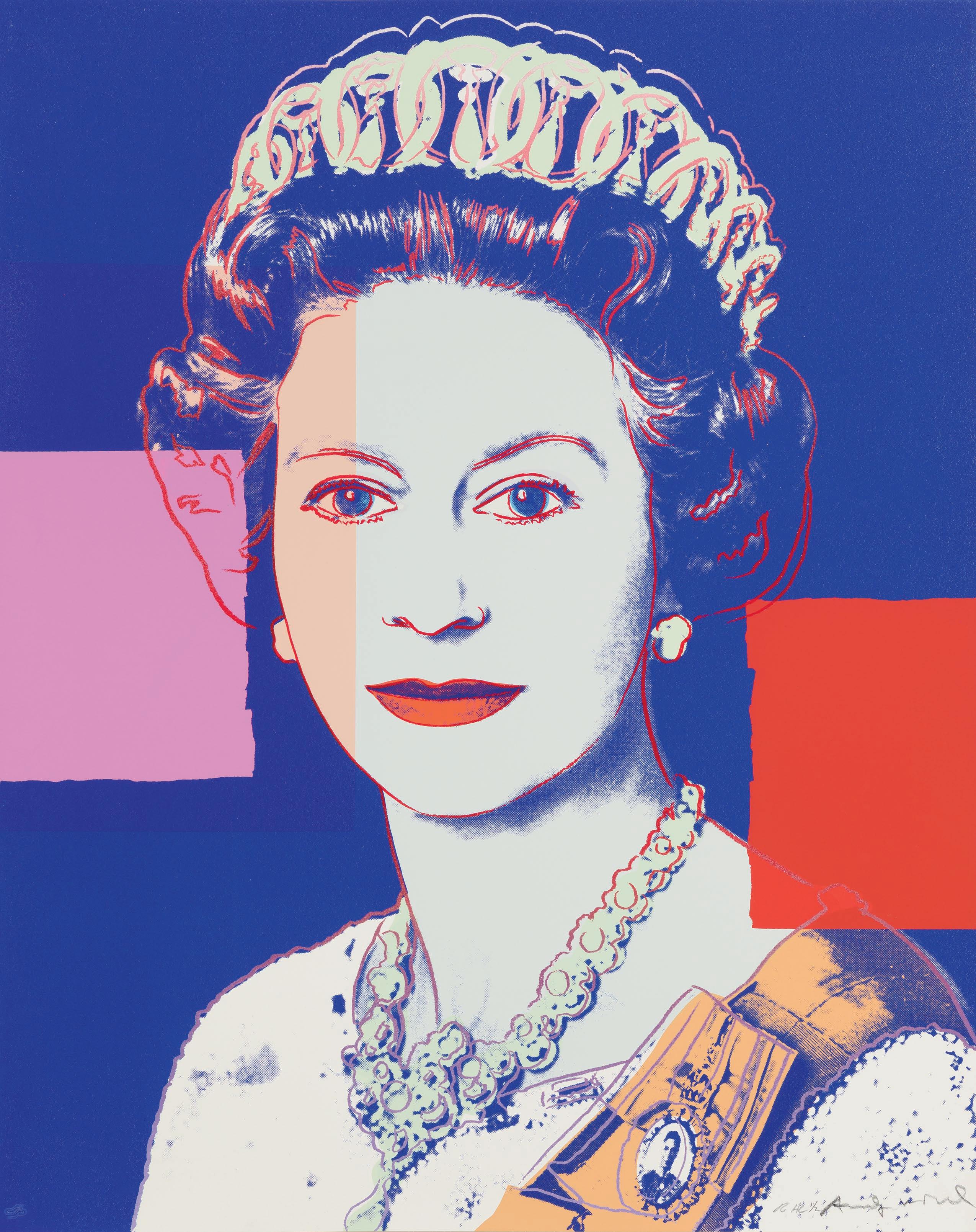
38
18 Andy Warhol
1928 – 1987 American
Queen Elizabeth II of the United Kingdom, from Reigning Queens, Royal Edition (F.S.II .337 A ) screenprint on Lenox Museum Board with diamond dust, signed in graphite and editioned R HC 1/2, with the printer’s blindstamp, Rupert Jasen Smith, New York and on verso stamped with the artist’s copyright stamp, published by George C.P. Mulder, Amsterdam, 1985 39 3/8 × 31 1/2 in, 100 × 80 cm
Proven A
Equinox Gallery, Vancouver Bob Rennie, Vancouver
Acquired from the above by the present Private Collection, Vancouver, circa 1996
Frayda Feldman and Jörg Schellman, Andy Warhol Prints: A Catalogue Raisonné 1962 – 1987, fourth edition, 2003, catalogue #II .337 A , listed and reproduced page 143, listed page 219
I N 1982 , A N dy WARHO l’ S European dealer and publisher George Mulder wrote to Queen Elizabeth’s private secretary, Sir William Heseltine, to state Warhol’s wish to produce a set of screenprint portraits of the monarch. While the Palace accorded the request, Heseltine’s response was muted: “While the Queen would certainly not wish to put any obstacles in Mr. Warhol’s way, she would not dream of offering any comment on this idea” (figure 1). In 1985, this first reserved response changed to a more positive tone when the Queen saw photographs of Warhol’s screenprints. Heseltine thanked Mulder and commented that “Her Majesty was most pleased and interested to see” these images (figure 2).
As the longest reigning monarch of the British crown, Elizabeth II was the subject of many portraits—official and
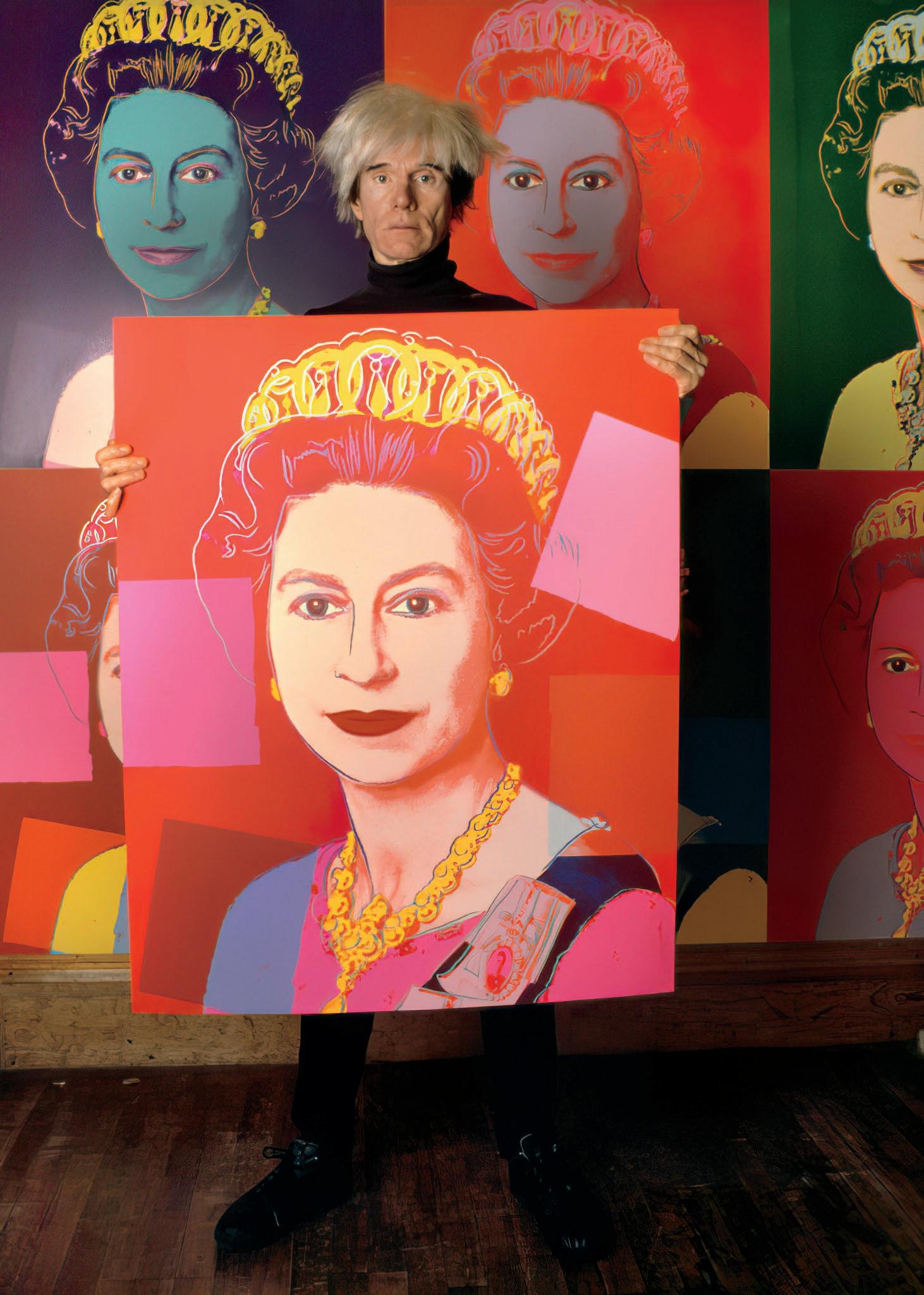
39
nce
l iter A ture
Andy Warhol holding a screenprint of Queen Elizabeth II in his studio at the Factory, New York, 1985 Photo: Derek Hudson Courtesy of Getty Images
FIGURE 1: Letter from Sir William Heseltine to publisher George C.P. Mulder, September 16, 1982

otherwise—produced by some of the world’s most illustrious painters and photographers. Heseltine’s guarded response showed the care with which Elizabeth II ’s image was treated. Warhol, as the avant-garde prince of Pop Art, was perhaps regarded with caution. He was well-known for his portraits of public figures: film stars such as Liz Taylor and Marilyn Mon roe, political figures such as John F. Kennedy and Mao, music stars such as Elvis. Warhol was fascinated with celebrity, and the Queen was renowned around the world.
Warhol proceeded to produce his Reigning Queens series, a set of large portraits published in 1985, based on official or media photographs of the only four reigning queens in the world at the time: Queen Elizabeth II of the United Kingdom, Queen Beatrix of the Netherlands, Queen Margrethe II of Denmark, and Queen Ntfombi Tfwala of Swaziland (now Eswatini). This iconic image of Queen Elizabeth II is based on a photograph taken by Peter Grugeon at Windsor Castle in 1975, which was released in 1977 on the occasion of her Silver Jubilee. She is beautiful, resplendent in her regalia of the diamond and pearl Grand Duchess Vladimir Tiara and a diamond and pearl necklace, wearing a blue sash
FIGURE 2: Letter from Sir William Heseltine to publisher George C.P. Mulder, March 14, 1985
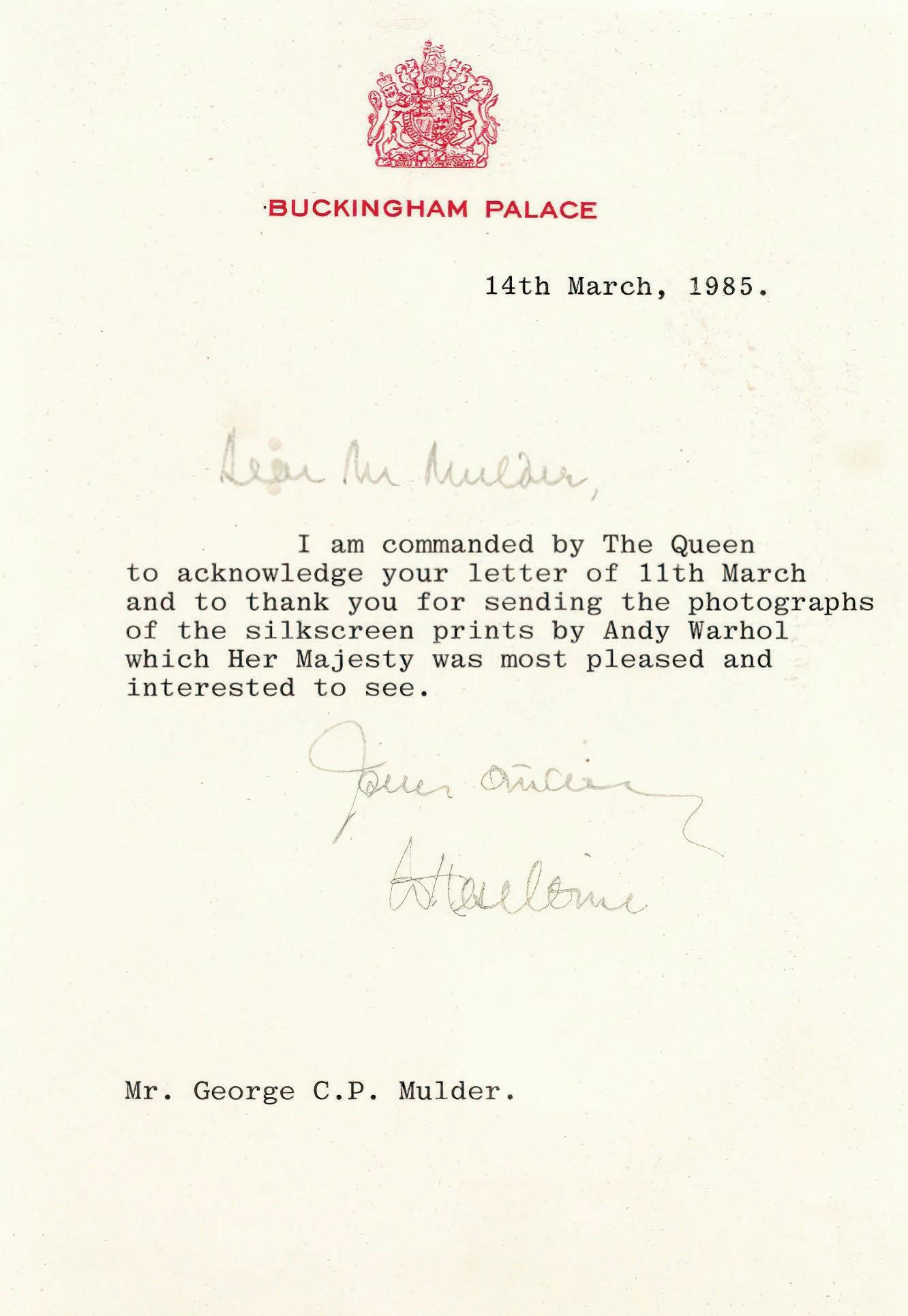
pinned with a medallion with a miniature portrait of her father, George VI . Her expression is somewhat Mona Lisa–like—she has an enigmatic smile and appears to look beyond the photographer. She is warm but dignified, conscious of the fact that she is sitting for a formal photograph.
Warhol produced four versions of the portrait in different colours, with coloured lines drawn on the screenprint of the photograph and overlaid with contrasting patches of geometric colour blocks. Colour in this series has a vivid, chromatic inten sity, and our print, produced with a regal blue background, is perhaps the most striking of the four colourways. While the standard edition of this series was a run of 40 prints, this print is from the coveted Royal Edition, a smaller deluxe run of 30 which included crushed glass or “diamond dust,” applied directly to the screenprint. This “diamond dust” was sprinkled into the outlines of the portraits, allowing them to glimmer and sparkle in the light, lending an especially magnificent impression when viewed in person.
Three decades later, the Queen’s true approval of the port folio was revealed when in May 2012, during the year of her
40
Diamond Jubilee, the Royal Collection acquired Warhol’s suite of four prints from the deluxe edition of 30 with diamond dust. Later that year, the prints were exhibited at Windsor Castle in the exhibition The Queen: Portraits of a Monarch (figure 3). They were the only portraits she owned that she did not commission and pose for.
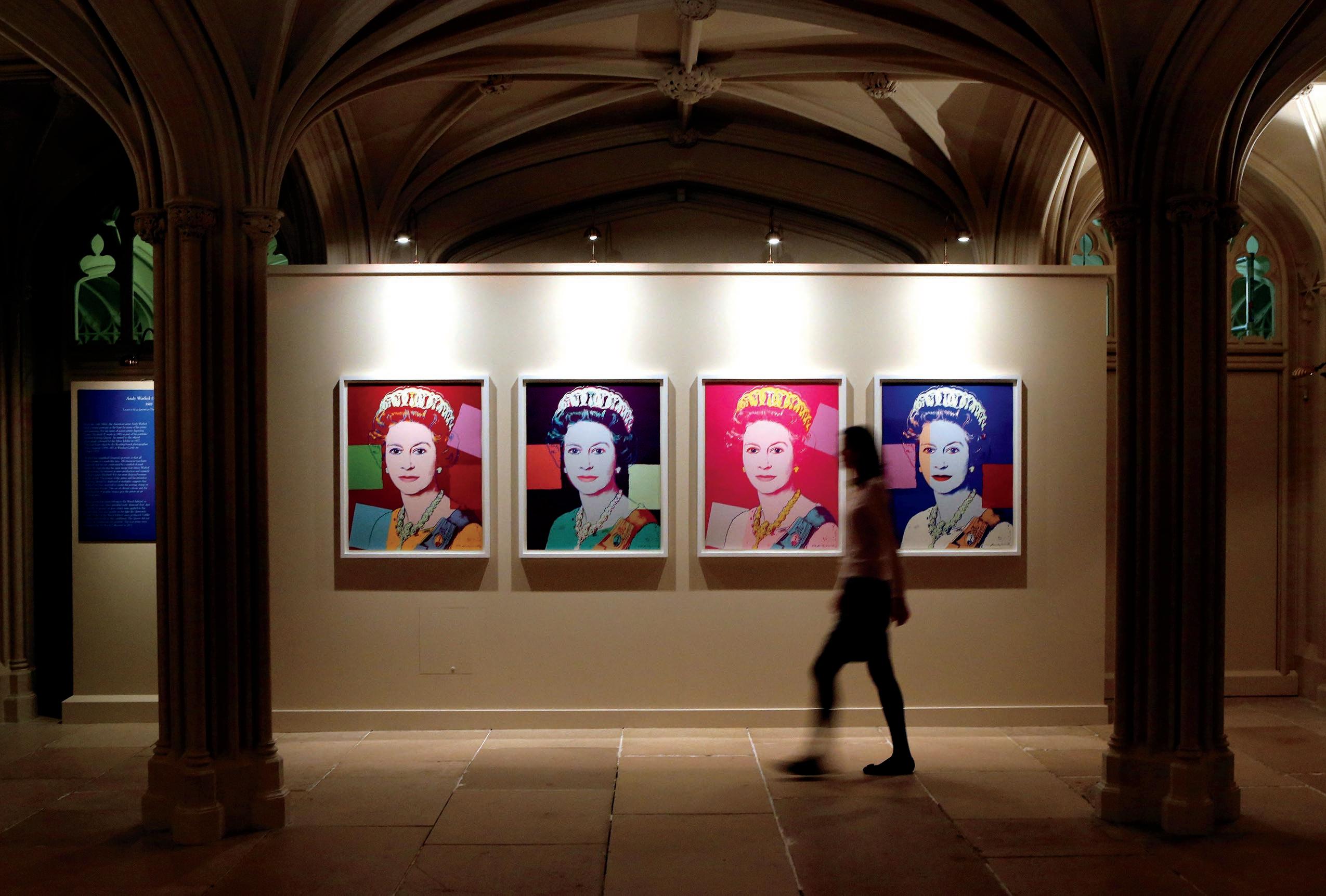
The present owners acquired this print from Vancouver collec tor Bob Rennie, who has one of the largest and most important collections of contemporary art globally. Rennie has been fea tured in artnews magazine’s annual list of Top 200 Collectors, and sits on the Board of Trustees at the Art Institute of Chicago.
This work is editioned “HC ” for Hors Commerce—“out of trade” or “not for sale”—one of only two such prints aside from the 30 numbered prints of the Royal Edition. Due to their rarity, HC s are the most desirable editions of prints: not commercially available during the initial run, they are typically given as gifts directly from the artist.
41
e stim A te: $ 500,000 – 600,000
FIGURE
3:
The Queen: Portraits of a Monarch, an exhibition at Windsor Castle that included the suite of four screenprints of Elizabeth II , Royal Edition, by Andy Warhol, 2012 Photo: Steve Parsons Courtesy of PA Images
19 Barbara Hepworth
1903 – 1975 British
Young Girl (Brown on Brown) oil and pencil on board, signed and dated August 1951 and on verso signed, titled and dated 21 1/2 × 13 3/4 in, 54.6 × 34.9 cm
Proven A nce
G. Blair Laing Limited, Toronto, 1964 Private Collection, Toronto
New Sculpture and Drawings by Barbara Hepworth, The Lefevre Gallery, 1952, listed, unpaginated
The Lefevre Gallery, London, New Sculpture and Drawings by Barbara Hepworth, October 1952, catalogue #30
fO ll OWING THE S ECON d World War, finding marble in short supply, Barbara Hepworth made a notable turn towards figura tion and drawing. After her daughter was hospitalized in 1944, Hepworth became fascinated with surgical procedures and the technical, manual skill of the surgeons who performed them. She brought her sketch pad into the operating theatre at Princess Elizabeth Orthopaedic Centre in Exeter, taking the opportunity to observe the precise, skilled movements of individuals at work; between 1947 and 1949, she produced nearly 80 works in ink and chalk known as the Hospital Drawings.
Contemporaneous with these drawings was a group of nude figurative works done between 1947 and 1951, including Young Girl (Brown on Brown), an indication of her interest in introducing a more grounded, human element—a tempering of her modern ism that coincided with a more organic turn in her sculpture at this time. Hepworth would employ dancers as her models, pre ferring to observe their bodies in motion or relaxed in moments of natural pause, rather than in fixed, artificial poses. She became thoroughly familiar with their movements, capturing their poise and energy through graceful, minimalist pencil drawings. A group of the resulting figurative works (as well as some purely abstract pieces) was shown in 1950 in the British Pavilion at the Venice Biennale, alongside works by the earlier British artists John Constable and Matthew Smith—suggesting, perhaps, that
Hepworth’s modernism could be seen as a continuation of a more painterly inheritance.
Young Girl undeniably occupies the space between painting and drawing. The board was prepared with gesso and oil washes, which were then scraped back. Over this surface Hepworth has laid graphite pencil, capturing the model with delicate precision. The standing figure initially appears static, effaced of all iden tifying features, but quickly becomes animated by Hepworth’s rhythmic line work. The curve of the spine, the rapidly worked and reworked legs, and the brief suggestion of hair express, with minimal rendering, the restrained movement and strength of the dancer at rest. Despite this austerity, we still get a sense of her presence in how she sinks her weight on her leg or in the carved hollow of her back. The body of the figure is further worked through dimensional techniques of relief shading—the contours and muscles suggested through burnishing and scratching into the underlying medium—which allows the exposure of the brown ground to suggest the colour of skin. In this sense, the flat surface takes on subtle depths and dimensionality, molded by the use of sculptural manipulations.
The title’s singular Girl assures us that this is not a pair of fig ures but a single subject, multiplied or reflected. The dancer is placed in a dialogue with her own body, existing in two contigu ous moments or simultaneously seen from two points of view. To this end Hepworth is employing an almost Cubist construction to explore the relationship of multiple figures (indeed, the 1950 Venice Biennale also included prominent works by Pablo Picasso and Georges Braque). Hepworth explored this technique further in her sculpture, which at this time was beginning to take on a more organic, figurative quality. Young Girl shows that the two media were influencing one another: the skilful handiwork of the artist elevates sketching into sculpture, and the figure draw ing becomes monumental. This work ably demonstrates that Hepworth’s drawings are not ancillary to her sculpture, but are highly effective demonstrations of the artist’s marriage of form and line.
We thank Sophie Bowness, PhD, for providing information in preparing this catalogue entry. Bowness is preparing the revised catalogue raisonné of Hepworth’s paintings and drawings, in which this work is included as #BH d 286.
e stim A te: $ 40,000 – 60,000
42
l iter A ture
e xhibited

43
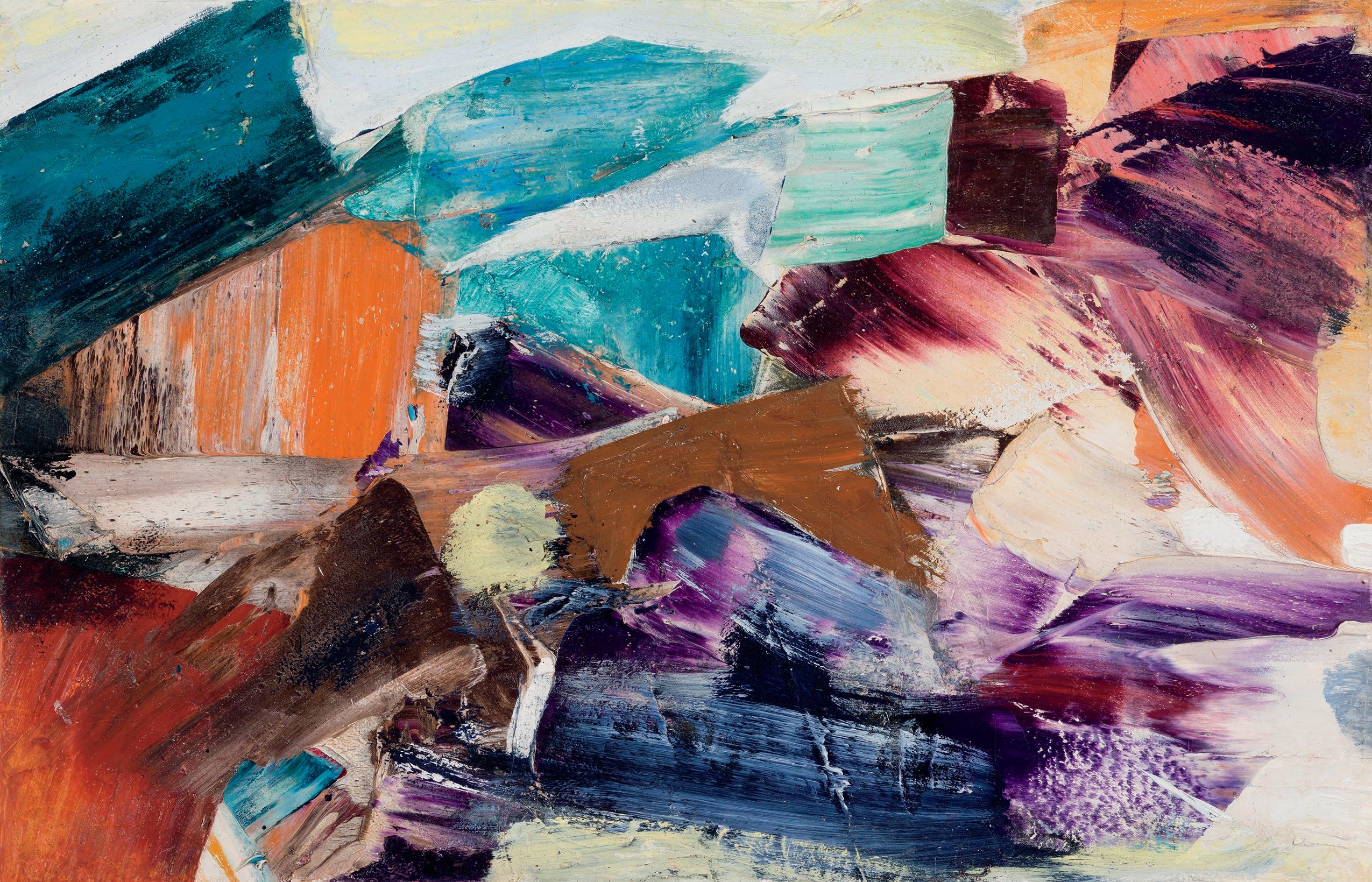
44
Ferron
Sans titre
oil on board, on verso signed, numbered 88 on a label and stamped with the Succession Marcelle Ferron stamp, circa 1959
18 1/4 × 28 in, 46.4 × 71.1 cm
Proven A nce
Private Collection, Toronto
l iter A ture
Roald Nasgaard, Abstract Painting in Canada, Art Gallery of Nova Scotia, 2007, page 83 Robert Enright, “The Art of Structuring Intimacy,”
Marcelle Ferron: Monograph, 2008, page 12
M ARCE ll E fERRON WAS born in 1924 in Louiseville, Quebec. She studied to become a painter at the École des beaux-arts in Quebec City in the early 1940s, but withdrew from their program, as she considered it too academic and conformist. When she left Quebec City for Montreal, she frequented many galleries and museums in search of inspiration, and after seeing an exhibition of Paul-Émile Borduas’s paintings, she was struck by his works and felt the urgent need to meet with him. Their first encoun ter, in 1946, was life changing for the young artist. She was then introduced to a group of individuals who would later become members of the Automatist group: Pierre Gauvreau, Françoise Sullivan, Fernand Leduc, Jean-Paul Mousseau, Marcel Barbeau and Jean Paul Riopelle.
Ferron’s link to the Automatists was made official in August 1948, when she became one of the 16 signatories of Borduas’s Refus global manifesto. This document signaled an important cultural shift in Quebec. Art historian Roald Nasgaard explains that it was “a passionate attack on all the repressive social, political, historical and religious forces that had shaped the Québécois people . . . ” Not only was it the driving force behind the Automatist movement, it is now regarded as a milestone in the modernization of Quebec, exposing the province to the cosmo politan ideas of the post-war era. At the young age of 24, Ferron was one of seven women artists to sign it. But the aftermath of
the manifesto’s publication was challenging. Its author, Borduas, and its signatories found it almost impossible to show their works in “la belle province.” Borduas was fired from his teaching posi tion at the École du meuble and had to move to New York, and eventually Paris. In 1953, Ferron also left for the “City of Light” with her three daughters, all aged under five; she stayed in Paris until 1966.
During her Parisian period, her canvases became larger and her palette more colourful. She applied her paints with broader strokes of the spatula, with a renewed focus on gesture and rhythm. Art critic Robert Enright wrote:
She never dripped paint in the manner of Pollock or Riopelle; her pigment is not released as much as it is set down. There are no spatters and rag smears mixed in with the brushwork on Ferron’s surface. Before long, she reached the point where she used a palette knife the way a mason employs a trowel. She lays it on.
Sans titre is typical of her production dating from the late 1950s and early 1960s. Here, Ferron covers the entire surface of the canvas with an incredibly coherent and rich selection of colours. Intense blues—ranging from ultramarine to light turquoise—along with saturated touches of amethyst, maroon, crimson, orange and brown are counterbalanced with luminous whites, making our eyes dance all over the work. These colours are layered in sharp, overlapping strokes with her trusty palette knife—laid down in thick swoops, her impasto reveals the grainy texture of the paint that she mixed herself from pure pigments. Enright wrote: “Ferron layers coloured shapes one on top of the other, but the effect is less the creation of tissues of transpar ency than laying down a foundation, as if the shapes were about to shift themselves into some pre-determined form. The use of marks to make forms and forms to create structure is Marcelle Ferron’s painterly signature.”
Executed around 1959, Sans titre is from Ferron’s best and most coveted period and showcases one of her finest selections of colours.
e stim A te: $ 50,000 – 70,000
45
20 Marcelle
AANFM AUTO CAS QMG RCA SAAVQ SAPQ 1924 – 2001
21 Takao Tanabe
OC 1926 –
Gulf of Georgia 10/86: Near Campbell River acrylic on canvas, signed and dated 1986 and on verso signed, titled and inscribed Errington 38 × 96 in, 96.5 × 243.8 cm
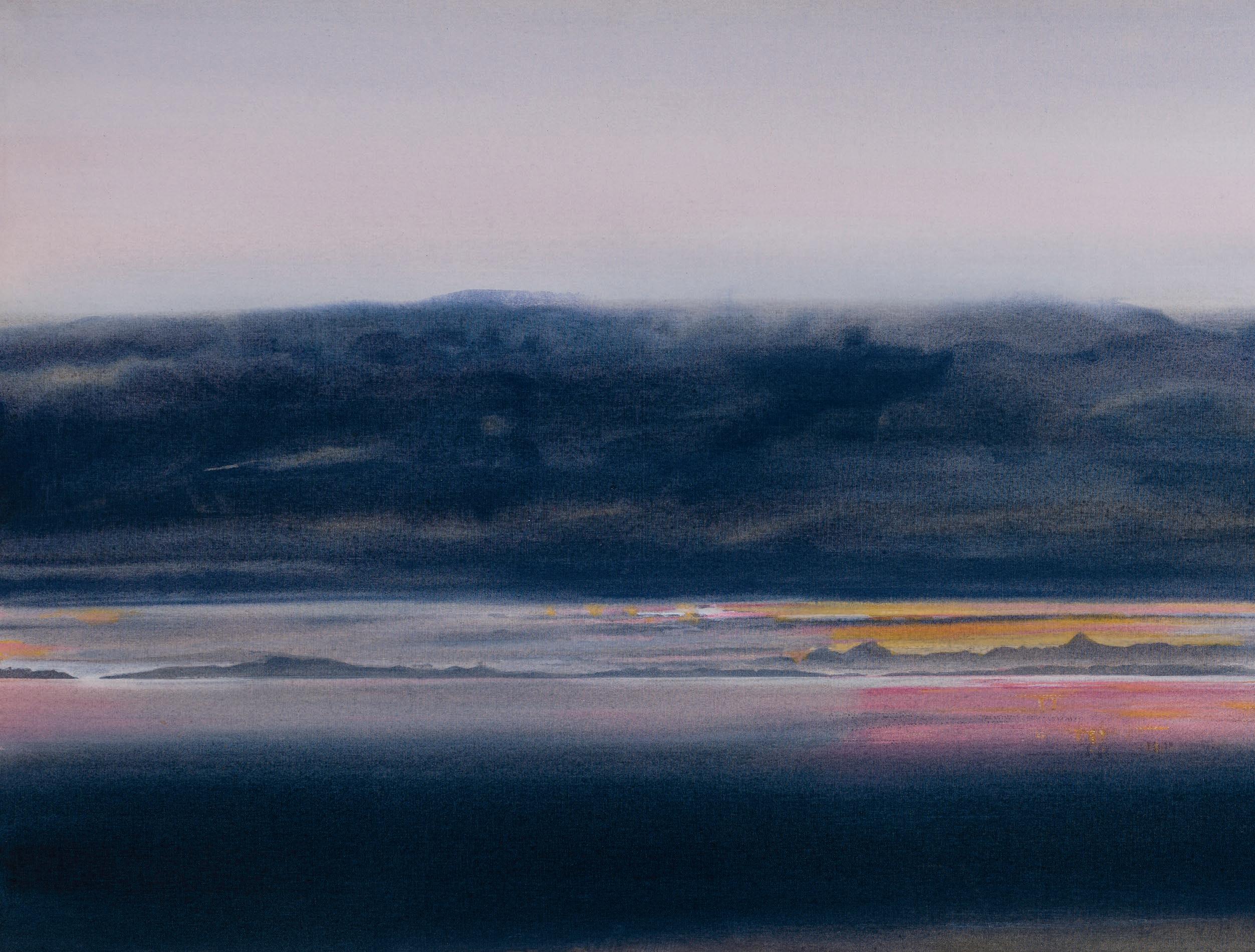
Proven A nce
Mira Godard Gallery, Toronto Private Collection, Toronto
l iter A ture
Ian M. Thom et al., Takao Tanabe, Vancouver Art Gallery, 2005, essay by Jeffrey Spalding, page 135 Becky Rynor, “An Interview with Takao Tanabe,” National Gallery of Canada Magazine, July 21, 2014, https://www.gallery.ca/magazine/artists/ an-interview-with-takao-tanabe
I N 1973 , T AKAO T ANABE became head of the art program and artist-in-residence at the Banff Centre. While there, Tanabe painted large prairie landscapes. These minimalist canvases depicted simple landforms, the imagery created by fields of paint stained into the canvas. In 1980, Tanabe resigned from teaching and moved back to his birthplace, British Columbia, to devote himself to painting full time. He settled in Errington, near Parks ville on the east side of Vancouver Island, and began to paint the coastal equivalent of prairie and sky works—views of the ocean backed by mountains and islands under moody skies, inspired by ferry trips between his home and the mainland. He stated: “Since I am somewhat of a loner, the whole idea of mists and fog and storm on the West Coast intrigued me then, and it still intrigues me.” There is no human presence, and no ships or small boats ply the ocean in his work, as for Tanabe, “the whole idea is Mother Nature, not human intervention, that I see and try to paint.” You can feel the silence in his work, sensing only the rippling sea, or the breath of the wind.
46
In response to his environment, Tanabe used a monochro matic blue-grey palette, but from 1986 to 1988, he broke his colour reserve with a series of expressive, more colourful paint ings such as this one. The view faces east; the sky is suffused with pale pink, and warm colours are reflected in the water from the unseen sunset behind the viewer. The darkened foreground indicates the transition to night, as do the deepening shadows on the mountains, creating contrast to the orange and deep pink tones. Mist rises from the water and settles into mountain hol lows, while vapours descend from their tops. It is a tremendously evocative painting. The scale of this work gives it an undeniable presence—its long horizon brings an expansion of the viewer’s vision, immersing them in the landscape.
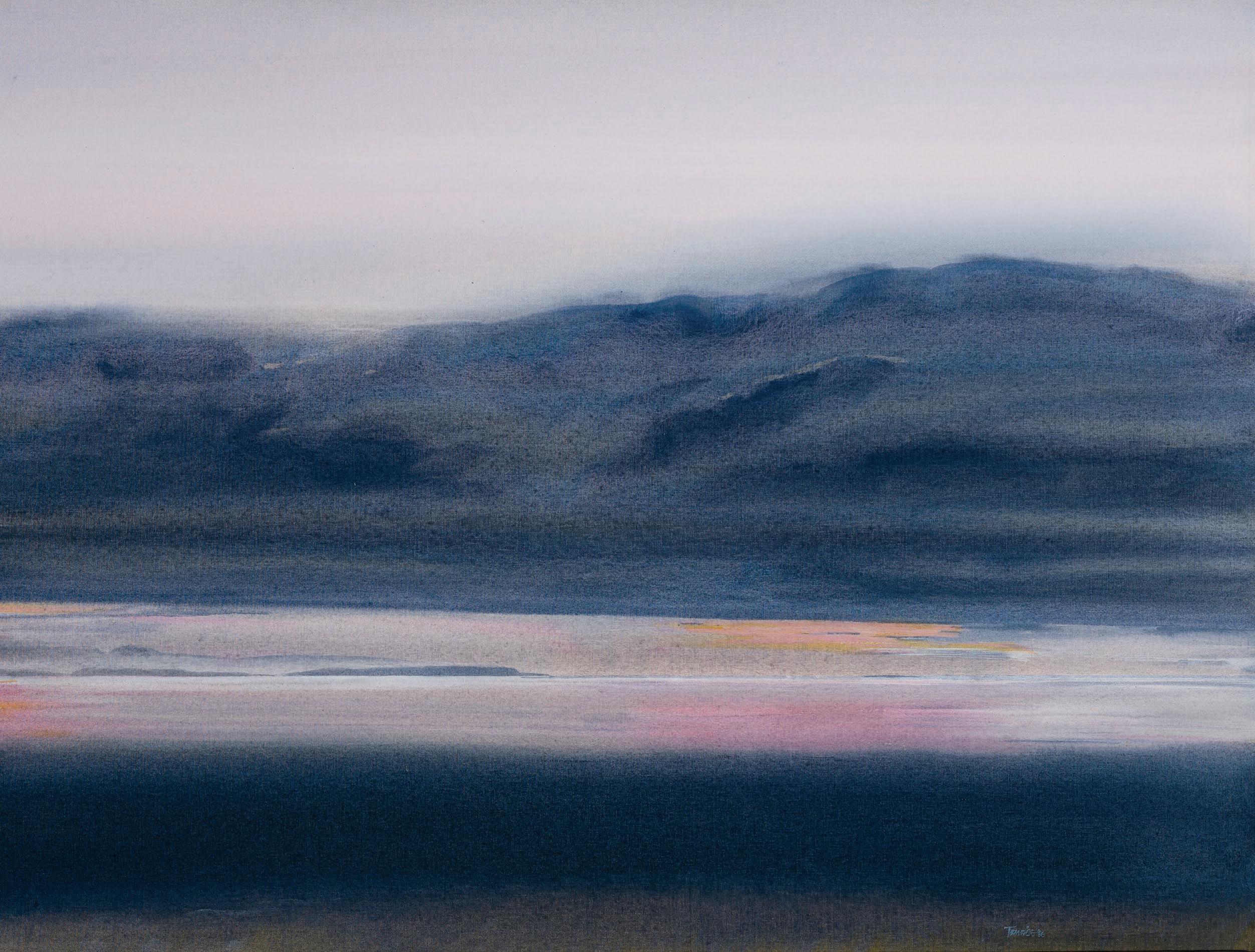
Tanabe works from photographs, his equivalent of the foundational sketch, in order to record the delicacy of these mist-enshrouded landscapes. He notes the exact location of each scene, like a navigator keeping records. In his coastal works, his paint surface changed from his previous staining approach as he
built up the paint in layers, as many as eight or nine, although he avoids brush-strokes, preferring a smooth surface.
Tanabe is one of Canada’s most important landscape paint ers, who has been called “the Turner of the Queen Charlottes” for his mastery of the depiction of moody weather. In Gulf of Georgia 10/86: Near Campbell River, the sensitivity and subtlety of his atmospheric effects is breathtaking.
e stim A te: $ 60,000 – 80,000
47
Gordon Appelbe Smith
acrylic on canvas, signed and on verso signed, titled, dated 2009 and inscribed with the inventory #20178 on the gallery label
60 × 67 in, 152.4 × 170.2 cm
Equinox Gallery, Vancouver
An Important Private Collection, Vancouver
Robert Enright, “Entanglements: Gordon Smith and the Art of Picture-Making,” Border Crossings, September 2012, paras. 2 and 4, https:// bordercrossingsmag.com/article/entanglements
beginning of Smith’s interest in entwining and interlocking shapes. But Structure with Red Sun was more rigid, while ts #6, from Smith’s Entanglements series, is all about organic growth and lines that curve and undulate.
G
MITH
IMPORTANCE as an early modernist in Vancouver cannot be overstated. He was at the core of a group of artists such as Jack Shadbolt and B.C. Binning who were very aware of the latest developments in art on the world stage. Also, Lawren Harris had moved to Vancouver in 1940 and brought with him his interest in abstraction. What distinguished Smith was his progression through various styles in his work, such as Abstract Expressionism, hard-edge painting, abstracted Black series paintings with text, and then abstracted landscapes such as the Pond, Snow and Entanglements series. He was inquisitive, con stantly experimenting and absorbing influences from artists that interested him, each step leading him on, keeping his work fresh and relevant.
The roots of paintings like ts #6 go back to the 1950s, when Smith was first exposed to Abstract Expressionism, to his tree paintings, such as Structure with Red Sun from 1955, with its strong grid of overlapping lines. In this work we can see the
Smith’s landscapes from the 2000s “emerge in, and through, nature,” as Robert Enright described, as does this abstracted explosion of growth at the level of the forest floor. As the artist stated in a 2008 film, “I’ve always loved tangles, that crossing over of things.” Like a miner working a rich vein of gold, Smith created his Entanglements paintings over a period of years, and ts #6 is an outstanding acrylic from this body of work. Branches are the focus here, and their overlapping patterns of lines fasci nate the eye. Pale in colouration, they are restless trails of paint that criss-cross in many directions. Smith’s brushwork is mas terful, both controlled and free. Twigs and branches are layered horizontally, with the central thicker branches acting like an armature, keeping the viewer’s eye at the surface. More delicate branches create a lacy pattern over moss, lichen, rich brown humus and lush grasses, containing the action at the forest floor. Smith’s colour palette is dominated by saturated tones of green, ivory and chocolate brown, but as is typical of the works in this series, brighter colours emerge from the depths—notes of red, yellow and caramel. Those splashes assert Smith’s painterly freedom amidst his use of the natural colours of the forest.
ts #6 shows that a small section of the forest floor could be a rich and fascinating subject for Smith’s consideration. It overlays the generative sources of earth and plant life with the seemingly random pilings of branches, which create an all-over pattern of tremendous vitality. Nature is unstoppable in its growth, and so was Smith in his devotion to his painting.
Consignor proceeds will benefit Ballet BC , Food Stash Foundation and the y MCA of Greater Vancouver.
48
e stim A te: $ 60,000 – 80,000 22
BCSFA CGP CPE OC RCA 1919 – 2020 TS #6
Proven A nce
l iter A ture
OR d ON S
’ S
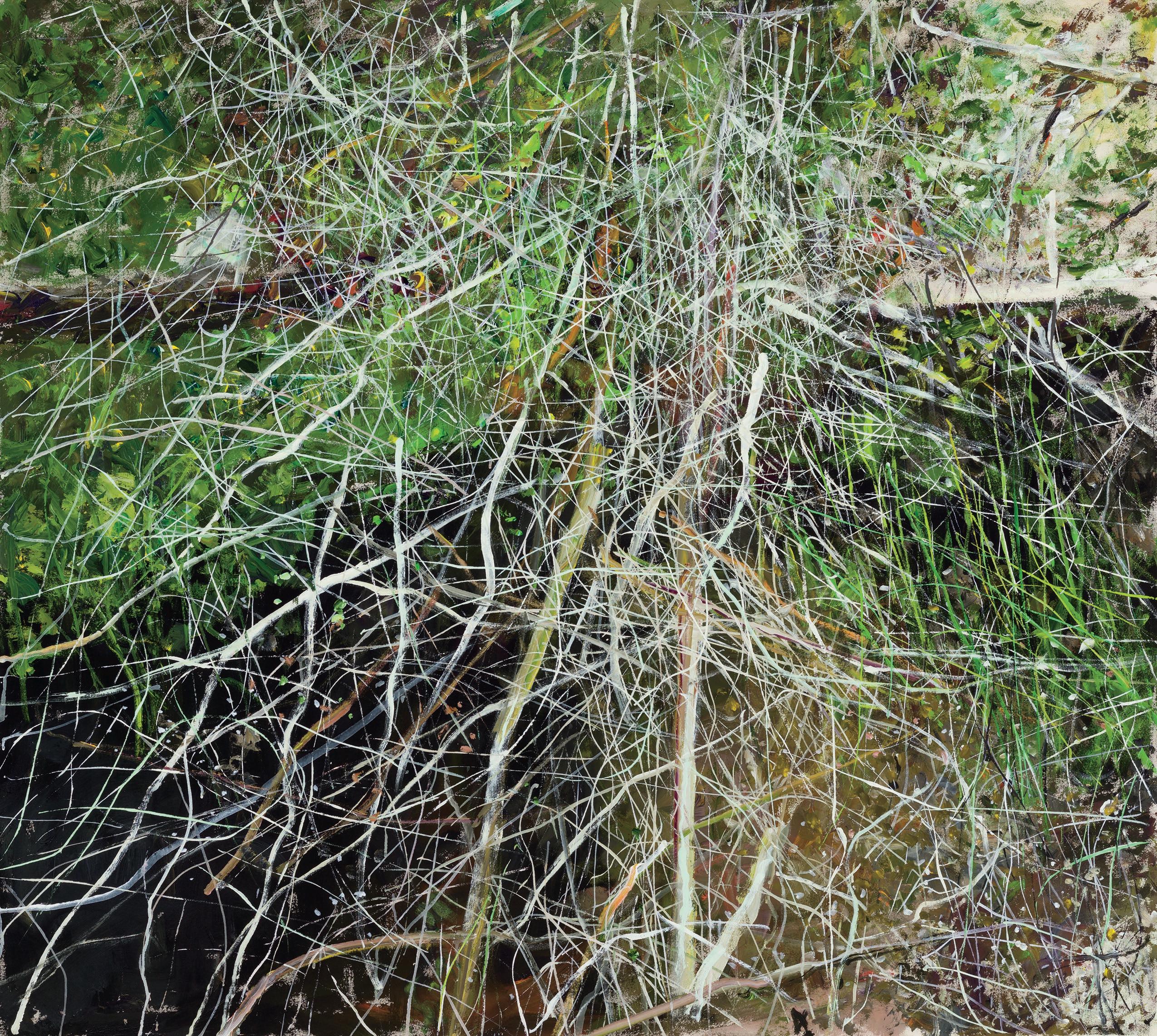
49
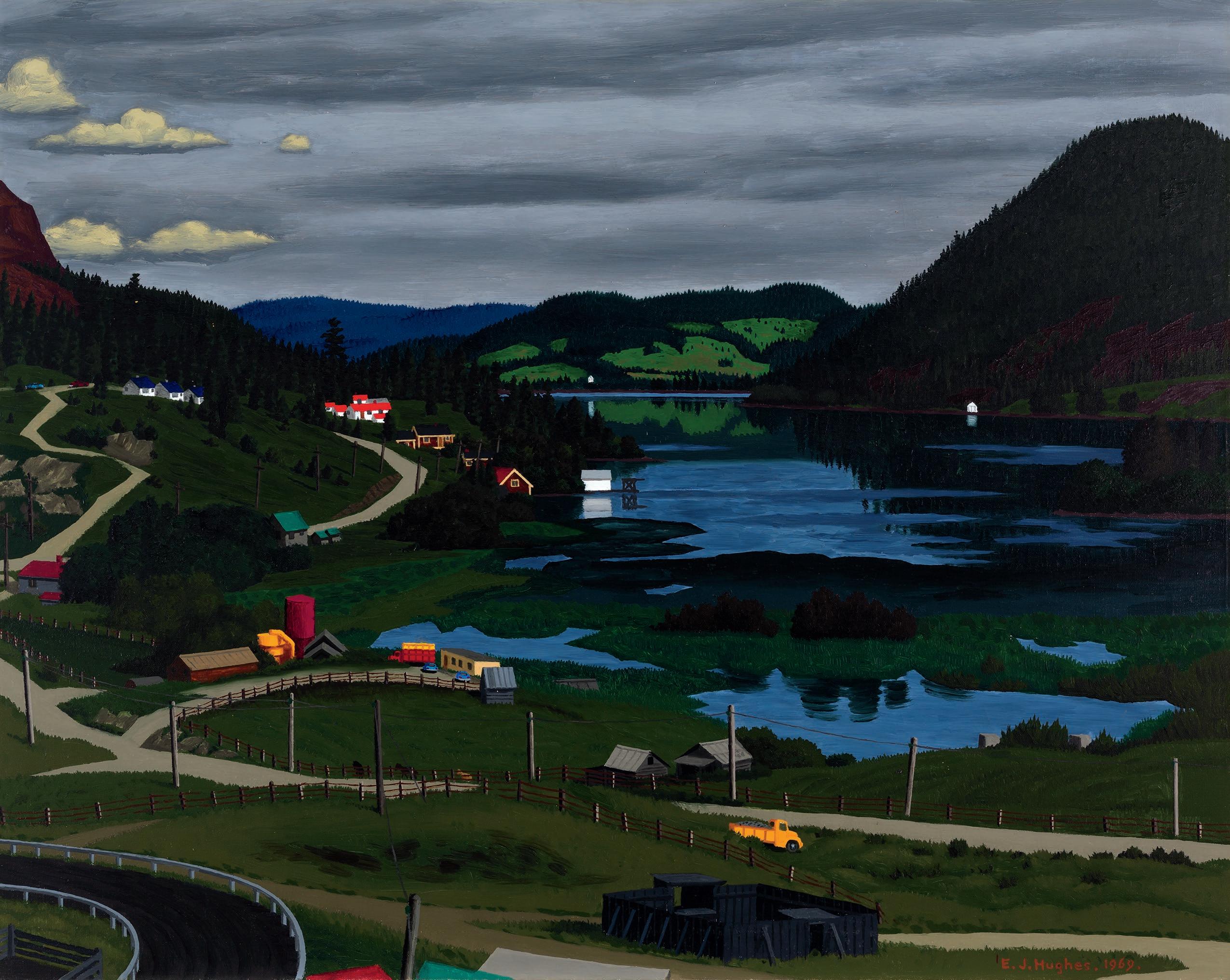
50
Williams Lake
oil on canvas, signed and dated 1969 and on verso signed, titled, dated and inscribed 1/6/76 and Propriété de Lucile Valiquette
32 × 40 1/4 in, 81.3 × 102.2 cm
Proven A nce
Dominion Gallery, Montreal Lucile Valiquette, 1976
By descent to a Private Collection, Montreal
Post-War & Contemporary Art, Heffel Fine Art Auction House, May 23, 2007, lot 189 Equinox Gallery, Vancouver Private Collection, Vancouver
Jane Young, E.J. Hughes, 1931 – 1982: A Retrospective Exhibition, Surrey Art Gallery, 1983, page 71 Jacques Barbeau, The E.J. Hughes Album: The Paintings, Volume 1, 1932 – 1991, 2011, reproduced page 55
E.J. H UGHES UN d ERTOOK a number of trips to the Interior of British Columbia: in 1956 to the northern Okanagan around Kamloops, Ashcroft and Vernon; in 1958 to the Okanagan Valley around Penticton as well as to Revelstoke; in 1963 to the north ern Interior around the Thompson Valley and Williams Lake; and lastly, to the northern Interior in 1967, funded by a Canada Council grant. On the 1967 trip, Hughes first visited the Hazelton area in northern BC , then went south to the Kootenays, around Kaslo and Cranbrook. On this trip, Hughes enjoyed the use of his new Pontiac car for exploration, and as a mobile studio. Well known for his coastal BC works, Hughes also did a substantial body of work based on BC Interior subject matter. Notably, it was a 1969 canvas from the Interior, Kaslo on Kootenay Lake, which became his diploma piece for the Royal Canadian Academy of Arts. As is the case with this fine painting, Hughes would continue
to work on this subject matter in the studio, referencing pencil sketches executed on these trips.
Typical of the work of this sought-after period in Hughes’s oeuvre is the deeply coloured palette of rich blues and greens of lake and hills, and the inclusion of human presence in the landscape with the brightly coloured houses and trucks. The relationship between man and nature in Hughes’s work is a har monious one. As Jane Young comments, “While the Group and Carr continued the tradition of landscape painting of the nine teenth century which celebrated the sublime and overwhelming power of nature, Hughes has painted the world as a civilized and cultivated garden through which man wanders, at home and at peace.” Hughes’s careful placement of compositional elements is in play with the positioning of the low clouds to the left, which leaves an opening in the centre to draw the eye through the land scape over the lake and up to the high overcast sky. In Williams Lake, Hughes showed his predilection for a picturesque and finely detailed panoramic view, and he depicted the unique colour and light of the northern Interior with an eye for beauty.
51
e stim A te: $ 150,000 – 250,000 23 Edward John (E.J.) Hughes BCSFA CGP OC RCA 1913 – 2007
l iter A ture
The Thoughts of Youth Are Long, Long Thoughts mixed media on board, initialed and on verso titled and inscribed variously
Galerie Agnès Lefort, Montreal Private Collection, Montreal

I can see the shadowy lines of its trees, And catch, in sudden gleams, The sheen of the far-surrounding seas, And islands that were the Hesperides Of all my boyish dreams. And the burden of that old song, It murmurs and whispers still: ‘A boy’s will is the wind’s will, And the thoughts of youth are long, long thoughts.’
H.W. lONG f E ll OW, from “My Lost Youth”
52
24 William Kurelek ARCA OC OSA 1927 – 1977
31 × 41 in, 78.7 × 104.1 cm Proven A nce
this work, The Thoughts of Youth Are Long, Long Thoughts, is drawn from a poem written by American poet Henry Wadsworth Longfellow entitled “My Lost Youth.” As William Kurelek explains in the written note on the verso of this painting, Longfellow’s work was a favourite of his childhood, as it was con cerned with a nostalgia for the imaginative reveries of childhood. Each stanza of the poem ends in the refrain: “ ‘A boy’s will is the wind’s will / And the thoughts of youth are long, long thoughts.’ ”
For Longfellow, a child’s desires are like the wind, fluctuating, unable to settle, characterized by longing and far-flung dreaming rather than uncertainty. This is not something lost, however, and the dreamy adventures of his youth are continually brought back through his later reminiscence.

This same nostalgic recollection represents a foundational aspect of many of Kurelek’s paintings. Here, the artist echoes the recuperative potential of memory that Longfellow explored. He depicts a playful event from his childhood, in which a flooded field presents the adventure of an ocean voyage. He wrote, “All one needed was boyish imagination and to gaze down at the water, forgetting about the land at the edges of the flood, and the motion of the waves gave the illusion of rapidly sailing forward.” One boy is shown dramatically poling the raft forward across the glassy pond, ripples shooting behind him, while the others stare into the unseen depths of the (certainly shallow) pond. An every day scene on the surface, but we get the sense that the subjects are illuminating the scene through their own fantasies.
This sense of expanded imagination is emphasized by the relative spaciousness of the scene, which is uncluttered by the Brueghelian crowds or the cozy, intimate interiors that some times appear in Kurelek’s works. Instead, we are presented with a landscape that is both vast and vacant. The flooded farmyard and further fields are characterized by their openness and emptiness, accentuated by the scarcity of surrounding details: frost-covered mounds of earth, sparse trees at the pond’s edge, thin fence posts and distant birds acting as our only geographic markers in an otherwise featureless landscape. The spaciousness of this sweep ing prairie landscape is further emphasized by its deliberate horizontality, marked by the compressed panorama of a clear sky over a scant distant line of trees.
Kurelek frequently employed this compositional strategy— situating a moment of drama in an empty landscape, viewed from an elevated perspective—to highlight both the vastness of the western prairies and the sometimes challenging (both physically and spiritually) nature of the rural immigrant experience. His intent is often moralizing: the loneliness of the individual in an indifferent universe, or the mundane importance of work (and, equally, play). The impersonal beauty and vacancy of nature serves as an allegorical foundation for the hardships and desires
inscriptions on verso
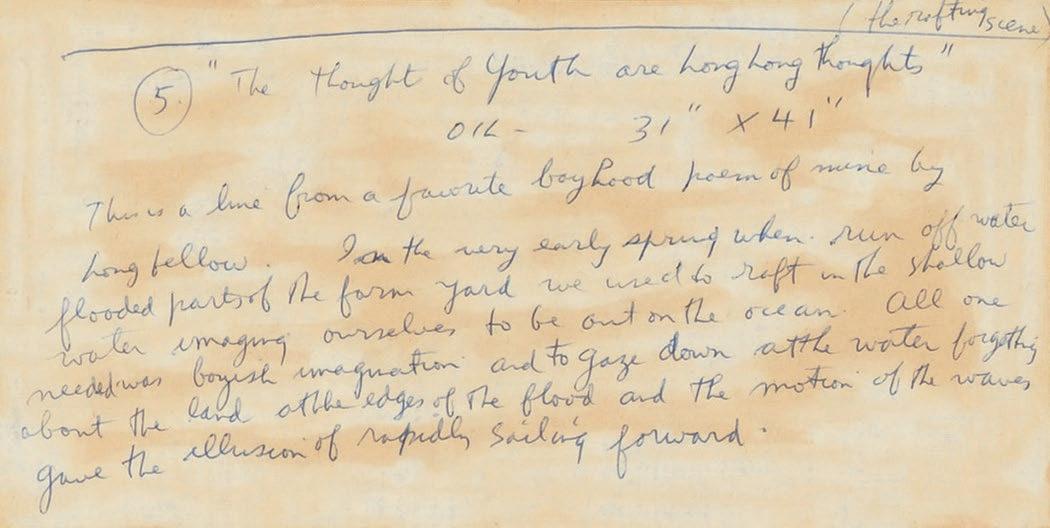
of Kurelek’s subjects, allowing them to perform, re-enact, explore and engage with their environment without limits. As if to under score this embellished emptiness, the upper left corner of the painting contains a small vignette of Christ, having fallen while carrying the cross—perhaps a surprisingly moralistic inclusion that nonetheless transforms the setting into something subtly phantasmagorical.
In the end, however, this scene is not fantastical or exagger ated. We cannot see the children’s imagined adventure as they see it: we are not shown the crashing waves or sweeping seas of their voyage across the pond. Instead, we are simply shown the blank canvas of their temporary stage, and their childlike intro spection as they explore their dreamscapes. In The Thoughts of Youth Are Long, Long Thoughts, Kurelek grounds an expanded space of infinite potential with something very intimate: a mem ory of joyful reverie, free of existential worry or danger. This work is in the original frame made by the artist.
e
53 T HE TIT l E O f
stim A te: $ 100,000 – 150,000
25 William Kurelek
The Bog Road Today
mixed media on board, initialed and dated 1971 and on verso titled and dated on the gallery label 10 3/4 × 48 in, 27.3 × 121.9 cm
Proven A nce
The Isaacs Gallery Ltd., Toronto Private Collection, Toronto
l iter A ture
William Kurelek, Kurelek’s Canada, 1975, page 12 William Kurelek, interview by Michael Ewanchuk, circa 1975, excerpt “I really fell in love with nature,” University of Manitoba Archives and Special Collections, available at https://kurelek.ca/audio-video/audio
I N 1934 , THE K URE l EK family left their homestead in Whit ford, Alberta, and resettled on a farm some 40 kilometres north of Winnipeg in Stonewall, Manitoba. Their attempts to grow wheat there met with failure, and William’s father, Dmytro, like many of his immigrant neighbours, began raising dairy cattle
instead. The new property was ideal for grazing, as it backed onto a large stretch of swampy wetlands to the east—today called Oak Hammock Marsh, then known as St. Andrews Bog, and to the Kureleks, as simply “the bog.”
Kurelek would speak about how much he enjoyed that “great, free, flat bogland” while he was growing up, in particular how it represented an escape from the chores and demands of field work. He stated:
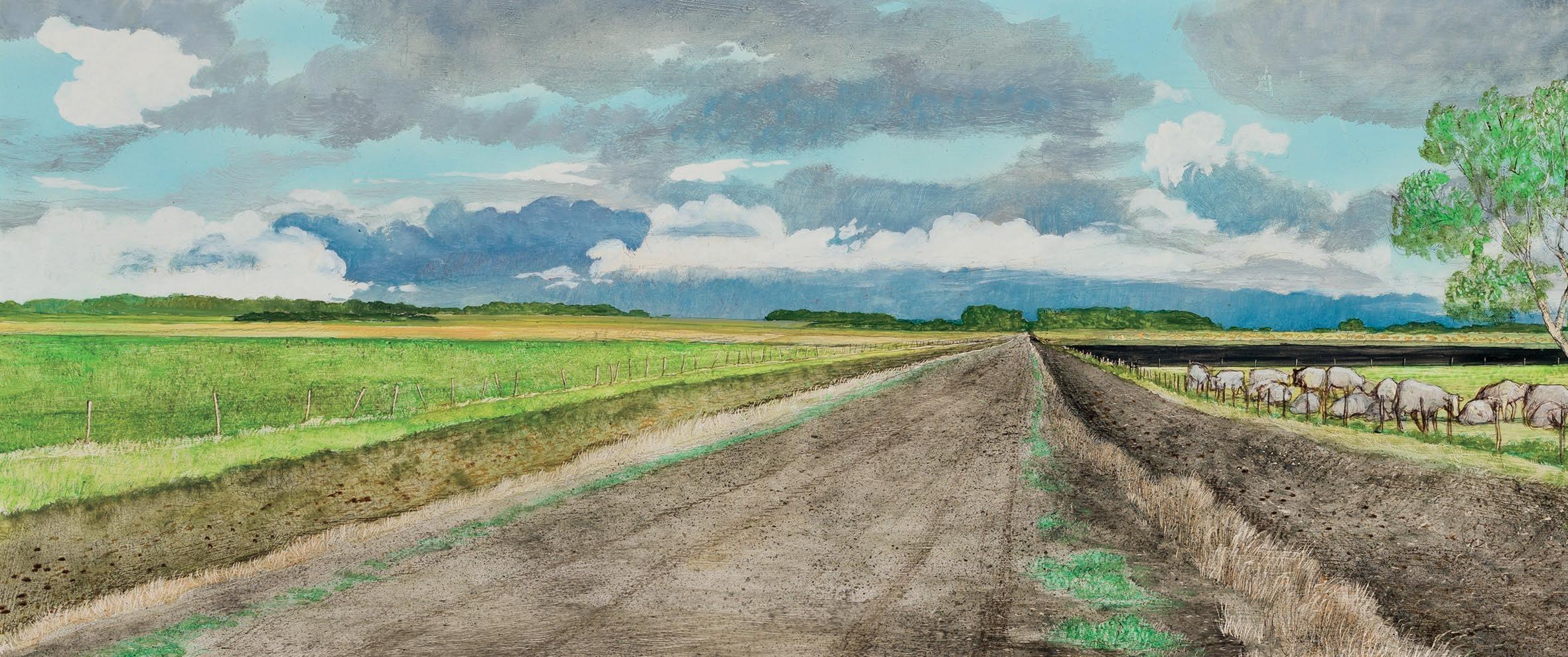
I was really taken by nature. I like birds, and I like to explore, take the measure of water in the spring in my rubber boots. I loved the big displays of nature, like storms and blizzards and all those things like that. To this day I’m thankful that there was this area immediately to the east of our farm called a bog, and there was nobody living for about 20 miles It was wild then, there were no fences. We used to love to go out there in order to get away from farm life.
The bog represented both an escape from his daily labours and an area of play, exploration and creative potential, a transient space that occupied both domestic and natural worlds. The romance of the untamed hinterland that the wetlands represented was intensified rather than tempered by its proximity
54
ARCA OC OSA 1927 – 1977
to the family farm. Kurelek wrote how his father left the eastern end of their farm fallow to grow for pasture, allowing the cows to graze in the bog through the summer; and how the wetlands became skating rinks in the winter and ponds to wade through in the spring melt. The “bog road” of the painting’s title was the straight, unpaved road that led to this transient space, lined by deep drainage ditches that can be seen as extensions of the swamp. The proximity of this relationship of the bog and the ditches is structured in the painting through the intensity of the single-point perspective, accentuating as well the openness of the prairie. The overall impression is relaxed—across the ditch, a group of dairy cows ambles along the fence, while the farmhouse lays low in the distance. One field over, the earth lies freshly tilled and awaiting planting, while farther still can be seen round bales of hay. The boundary between farmland and wildland is marked by the long, distant line of trees under scudding rain clouds, where a storm is breaking on the horizon.
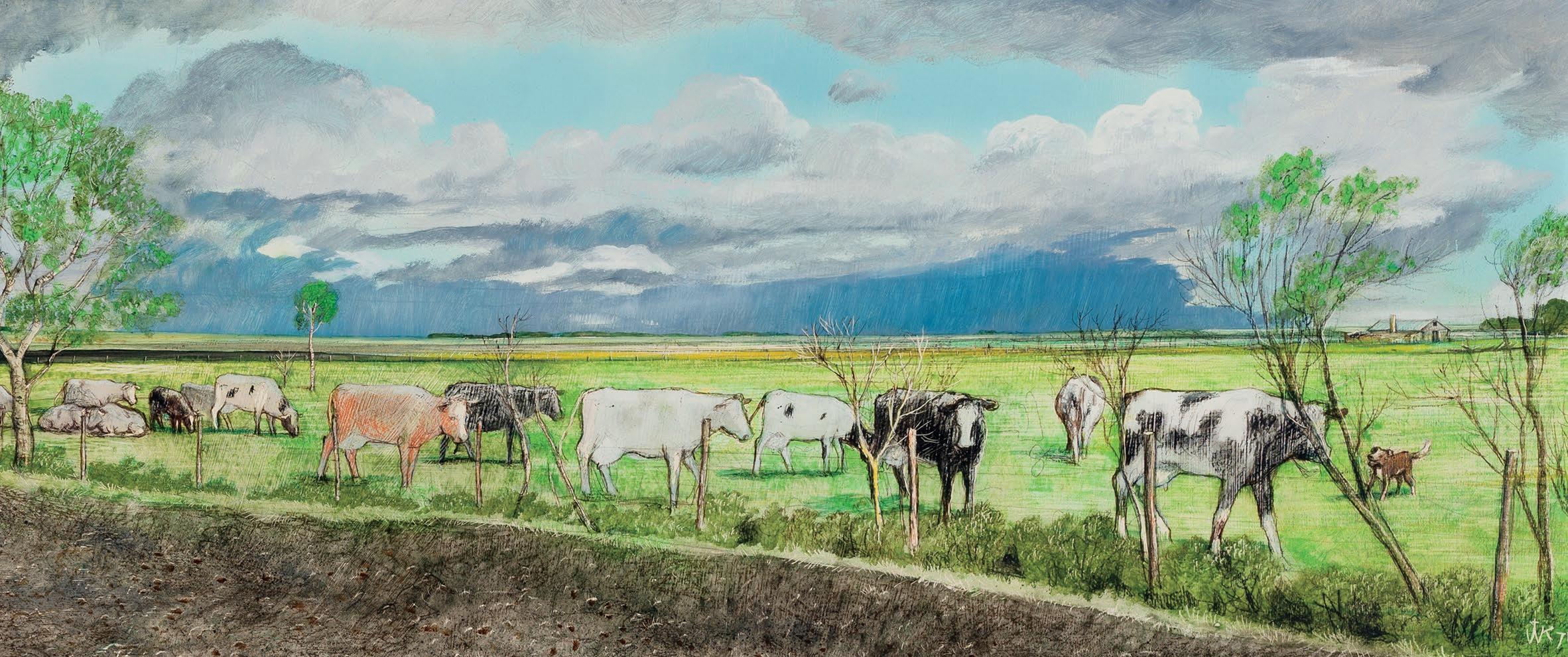
This scene is not derived from memory but likely drawn from one of the artist’s trips to Stonewall and rural Manitoba as an adult in the 1960s and 1970s. There is a palpable sense of an absence here, an afterimage of Kurelek’s childhood that can be felt in the placidity of the landscape and the bucolic pastoral ism of the farm. There is no buzz of roughhousing children, no
mischief-making antics (apart, perhaps, from the small farm dog jauntily greeting the cows to the right). Similarly, there are no overt indications of Kurelek’s more didactic impulses: no farmers at labour or at rest, spectacular religious tableaux, or markers of nature’s cosmic ambivalence to man. Instead, we get the sense that this is an image taken from direct observation, grounded in the eye-level perspective of a photograph. There is a sense of con tinuity, that Kurelek’s nostalgia is present as a memory of what has already passed through the landscape rather than existing within it, allowing the scene to be an unmediated celebration of nature and prairie life.
This work is in the original frame made by the artist.
e stim A te: $ 40,000 – 60,000
55

56
The Sower
bronze sculpture with patina and acrylic paint, signed, editioned 5/9 and dated 2018 27 × 13 × 14 in, 68.6 × 33 × 35.6 cm
Proven A nce
Private Collection, Winnipeg
l
A ture
Alan Small, “Appreciation from an Apostle: Renowned Prairie Sculptor Joe Fafard Pays Tribute to Revered Dutch Master in New Winnipeg Exhibition,” Winnipeg Free Press, July 6, 2018, para. 7, https://www.winnipegfreepress.com/arts-and-life/ entertainment/arts/appreciation-from-an-apostle487495241.html
J OE fA fAR d PRO d UCE d sculptures of Vincent van Gogh as early as 1983. Fafard read the artist’s letters and every biogra phy he could find, immersing himself in his life. He developed a remarkable body of work representing van Gogh: a grouping of 40 relief heads, two- and three-dimensional partial figures, and three-dimensional full-body works such as Dear Vincent from 1983, showing the artist seated on his famous cane chair.
The image of a man sowing seeds recurred in van Gogh’s work. Fafard told Alan Small: “Since Vincent was so interested in the idea, it should be a good idea to do a portrait of him as such because in a way he was a sower of ideas and many artists have used his ideas and influence to enrich their own art. Pablo Picasso said he was the originator of so many things, and I think that is true.” Adding a personal dimension to this work, Fafard himself grew up in the agricultural community of Sainte-Marthe, Saskatchewan, and later lived on a farm in Lumsden.
In The Sower, van Gogh holds his arm back with a brush in his hand, as if about to fling paint instead of seeds, symbolic of his concepts taking root with other artists.
e stim A te: $ 60,000 – 80,000
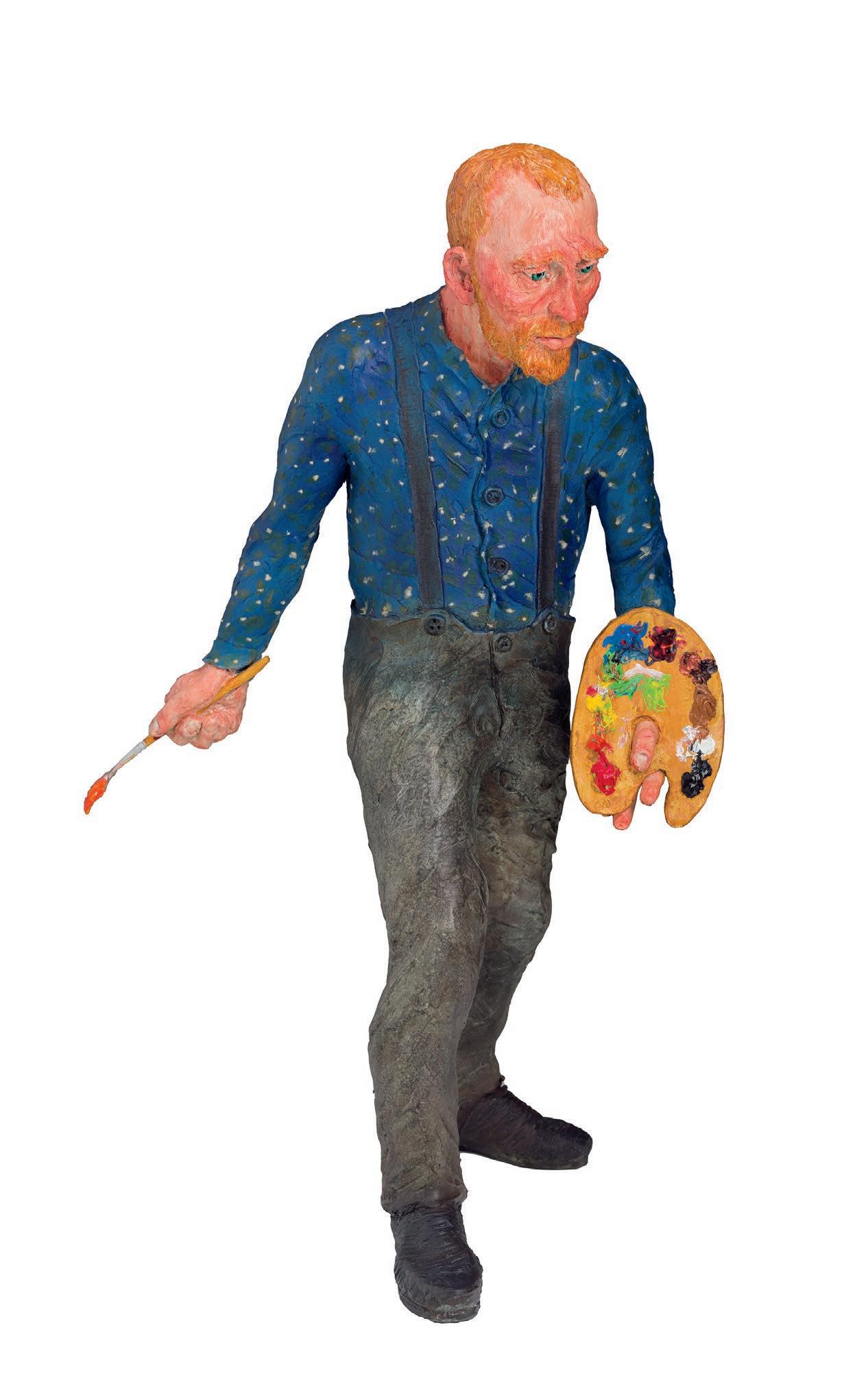
57 26 Joseph Hector Yvon (Joe) Fafard OC RCA 1942 – 2019
iter
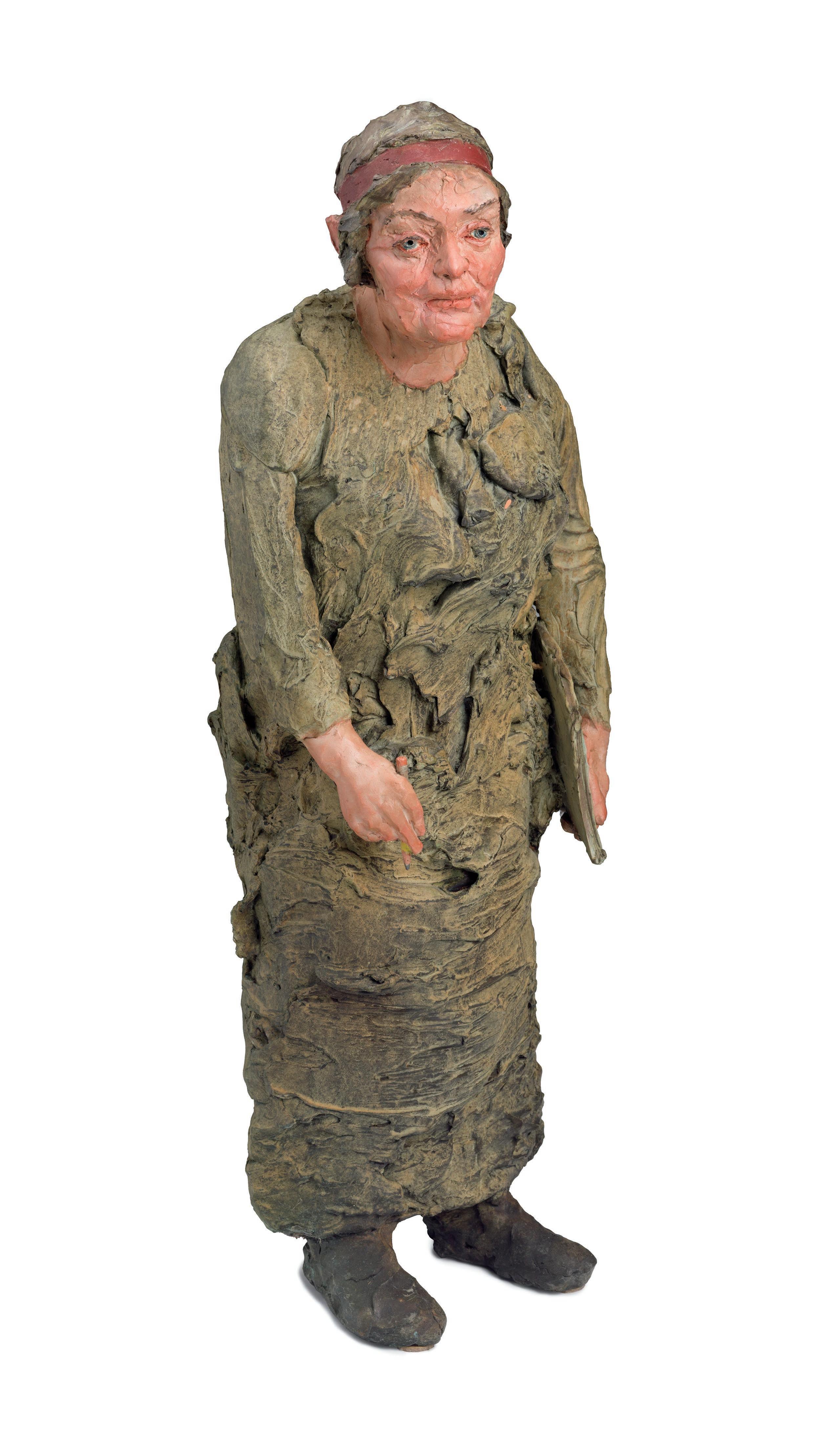
58
Emily
bronze sculpture with patina, signed, editioned 3/7 and dated 2005
30 1/2 × 10 1/2
Proven A nce
1/2
77.5
26.7
Galerie de Bellefeuille, Montreal

Private Collection, Vancouver
l iter A ture
Mayo Graham, editor, Joe Fafard: The Bronze Years, Montreal Museum of Fine Arts, 1996, page 31
S TARTING IN THE 1980s, Joe Fafard produced a series of artist portraits, cast in bronze in the foundry he had built in Pense, Saskatchewan. He sculpted famed international artists such as Vincent van Gogh, Claude Monet and Pablo Picasso, as well as West Coast icon Emily Carr. In this moving portrait of Carr, Fafard depicts her with pencil in hand and a paper tablet under her arm, a reference to either her drawings or the many autobiographical books she wrote, such as Klee Wyck. She has a sensitive, open expression on her face, which draws the empathy of the viewer. Carr reveals her softer side, likely because Fafard produced this individual cast of Emily from the large sculpture Emily Carr and Friends, which shows the artist with her horse, her monkey Woo and her dog Billie—animals that Carr loved. Fafard utilized a rough-hewn style in the treatment of this bronze casting, in keeping with Carr’s down-to-earth approach to her sketching, for she often camped and hiked in the woods to create her images.
Emily Carr and Friends was chosen by Heffel to be its signature sculpture, with three bronzes from the edition of seven installed outside its Vancouver, Toronto and Montreal locations.
e
30,000
40,000
59 27 Joseph Hector Yvon (Joe) Fafard OC RCA 1942 – 2019
× 8
in,
×
× 21.6 cm
stim A te: $
–
j
oe
fA fA rd
Emily
Carr and Friends bronze sculpture with patina,
2005 edition of 7 65 × 43 × 31 in, 165.1 × 109.2 × 78.7 cm Collection of Heffel Fine Art Auction House, Toronto Not for sale with this lot

60
28 Jean Paul Lemieux
La nuit des rois
oil on canvas, signed and dated 1973 and on verso titled 47 × 77 in, 119.4 × 195.6 cm
Proven A nce
Galerie Gilles Corbeil, Montreal, 1974
Margaret Carton, Montreal
A gift to the family of Margaret Carton, Toronto
I N 1973 , ON the eve of his seventieth birthday, painter Jean Paul Lemieux’s illustrious career was about to spread beyond Cana da’s borders. A major retrospective exhibition was on its way to the USSR , Czechoslovakia, Belgium and France, showcasing his pictorial work (1953 to 1973) for the first time.1 Comments in the visitors’ book from the Russian portion of the tour offer vivid accounts of the Canadian artist’s work and the universality of his messages. For example, one attendee noted, “The exhibition forces us to dig deep, to discover the thought process behind each of the paintings. This is the work of a thinker.” Another wrote, “This is not Canada, this is the horizon of conscience.” 2 These remarks speak volumes about the meaning of Lemieux’s art in cultures other than his.
It is easy to apply such comments to La nuit des rois, a sensa tional painting that is currently resurfacing in the Canadian art market. The piece disappeared from public display after it was acquired in 1974 by Galerie Gilles Corbeil in Montreal.3 This painting is sensational not only for its size (one of the biggest works Lemieux created in 1973) but also for the powerful effect of a subject that had inspired the painter since 1956—human loneliness, a theme he would explore until the end of his life. In his early classical period (1956 to 1970) and throughout his expressionist period (1970 to 1990), Lemieux depicted loneli ness in landscapes in which his figures extend beyond the edge of the canvas. By placing people at the edge, he creates the illu sion that they are about to exit the scene and disappear, leaving behind nothing but an expanse of snow that becomes a force field. And so it is in La nuit des rois, where faint, colourful lines in the distance hint at dwellings, a tiny hamlet teetering perilously on the horizon in what is otherwise a vast expanse of white snow.
Will it tip over into the immensity of the night and the depths of the universe? The sonority of these delicate strokes contrasts with the symphony of stars twinkling at night.
Lemieux turned to William Shakespeare for the title of his painting, which translates as “Night of the Kings,” naming it after the play Twelfth Night. This is, of course, a reference to the Chris tian feast of the Epiphany and the visit of the Magi, twelve nights after the birth of Jesus. The painter also gives a nod to one of his own paintings, Orion (1976, private collection), by placing the constellation at the right-hand side of the sky, above the human figure. In La nuit des rois we can see the diagonal line of the three stars of Orion, known as the “Three Kings.”
“Everything is space, presence, and sensitivity” in Lemieux’s mature work. This comment from the film Tel qu’en Lemieux, pro duced and directed in the painter’s Quebec City studio in 1973, holds true for La nuit des rois. 4 Appreciation of this masterful painting heightens our understanding of how his creative journey unfolded between 1970 and 1975, as his classical period gave way to his expressionist period.
We thank Michèle Grandbois, author of Jean Paul Lemieux au Musée du Québec, for contributing the above essay, translated from the French. This work will be included in Grandbois’s forth coming catalogue raisonné of the artist’s work.
1. The Jean Paul Lemieux exhibition was organized for France by the Ministère des Affaires culturelles du Québec and for the USSR and Czechoslovakia by Canada’s Department of External Affairs. It was presented in Russia and Europe between July 1974 and January 1975. A catalogue of the exhibition was published in French by Éditeur officiel du Québec in 1974.
2. Quoted in “Les Russes ont bien apprécié les oeuvres de J. Paul Lemieux,” Le Quotidien (Chicoutimi), February 6, 1975, and “Un maître québécois triomphe en Russie,” Journal de Québec (Quebec City), February 1, 1975.
3. The sale is recorded in the handwritten book Liste des oeuvres du peintre Jean Paul Lemieux [1965–1980], Fonds Jean Paul Lemieux et Madeleine Des Rosiers, Library and Archives Canada, Ottawa.
4. Guy Robert, dir., in Tel qu’en Lemieux (L’Office du film du Québec, 1973).
e stim A te: $ 600,000 – 800,000
61
CC QMG RCA 1904 – 1990
Angoisse
oil on canvas, signed
Proven
verso
of the family of Paul-Vanier Beaulieu, Laval
B ORN TO A BENAKI and Québécois parents, Rita Letendre was first introduced to Paul-Émile Borduas and the Automatists during her studies at the École des beaux-arts in Montreal. By 1950, she was committed to the Automatists’ gestural approach to abstraction, and her works were shown alongside theirs in seminal exhibitions such as La matière chante in 1954 at Galerie Antoine and Espace 55, at the Montreal Museum of Fine Arts. Her
works from the mid-1950s through the 1960s reveal her own unique approach to abstraction, which drew not only on the ges tural approach of the Automatists but also on influences such as Franz Kline, whom she particularly admired. During this period, she experimented with a grid-like application of pigments using a palette knife, resulting in a dense surface of tesserae. Layered generously and confidently onto the canvas, the paint takes on a seductive quality. It is tactile and sensuous, with a complex network of textured ridges and creases created by the edges of the spatula. In Angoisse, Letendre builds up a large expanse of lustrous black, creating a negative space. Simple touches of luminous white layered on top of golden orange, juxtaposed with olive-green slabs, give the work its soul, its life and vibrancy. Lush and magnetic, Angoisse is a stunning canvas from Letendre’s early Automatist period.
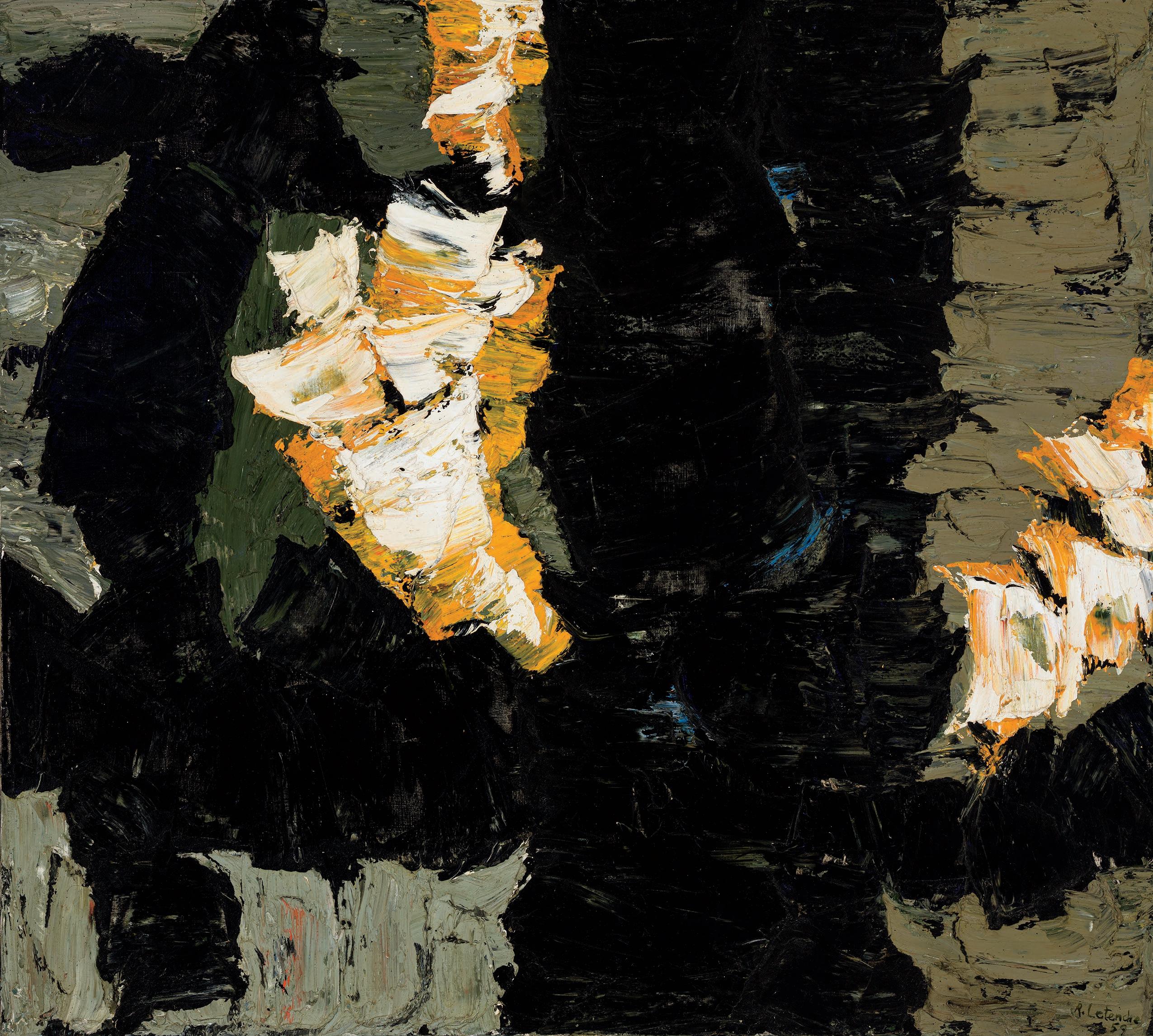
62
e stim A te: $ 40,000 – 60,000 29 Rita Letendre AANFM ARCA OC QMG 1928 – 2021
and dated 1959 and on
signed, titled and inscribed 4371 Havard Montreal 35 7/8 × 39 7/8 in, 91.1 × 101.3 cm
A nce Collection
Albert McEwen
Furieuse aurore #1 oil on canvas, signed and dated 1974 and on verso signed, titled and dated 36 × 40 in, 91.4 × 101.6 cm

Proven A nce
Marlborough-Godard, Toronto Galerie Madeleine Lacerte, Quebec City, 2006 Acquired from the above by a Private Collection, Toronto Post-War & Contemporary Art, Heffel Fine Art Auction House, May 25, 2016, lot 62 Private Collection, Toronto
T UMU lTUOUS AN d VIBRANT, Furieuse aurore #1 is a quintes sential example of Jean McEwen’s explorations of the relations between colours and their pictorial possibilities. Influenced by
works from Colour Field painters such as Mark Rothko, Barnett Newman and Clyfford Still, McEwen developed a distinctive and textured approach to colour over the course of his career. His energetic and expressive use of the paintbrush added depth and verve to his planes of colour, and this oil on canvas is no excep tion. Balanced on each side by marbled planes of orange, maroon and black, the central section layers gossamer-like strokes of chartreuse green onto a stormy black, crimson and sapphire back ground. These delicate, yet restless billows are reminiscent of the particles visible during the aurora borealis. McEwen received many awards and distinctions for his work, such as the Victor Martyn Lynch-Staunton Award from the Canada Council for the Arts in 1977 and the Prix Paul-Émile Borduas in 1998. Important retrospectives of his works were held at the Musée d’art contem porain de Montréal in 1973 and at the Montreal Museum of Fine Arts in 1987.
63
e stim A te: $ 40,000 – 60,000 30 Jean
AANFM RCA 1923 – 1999
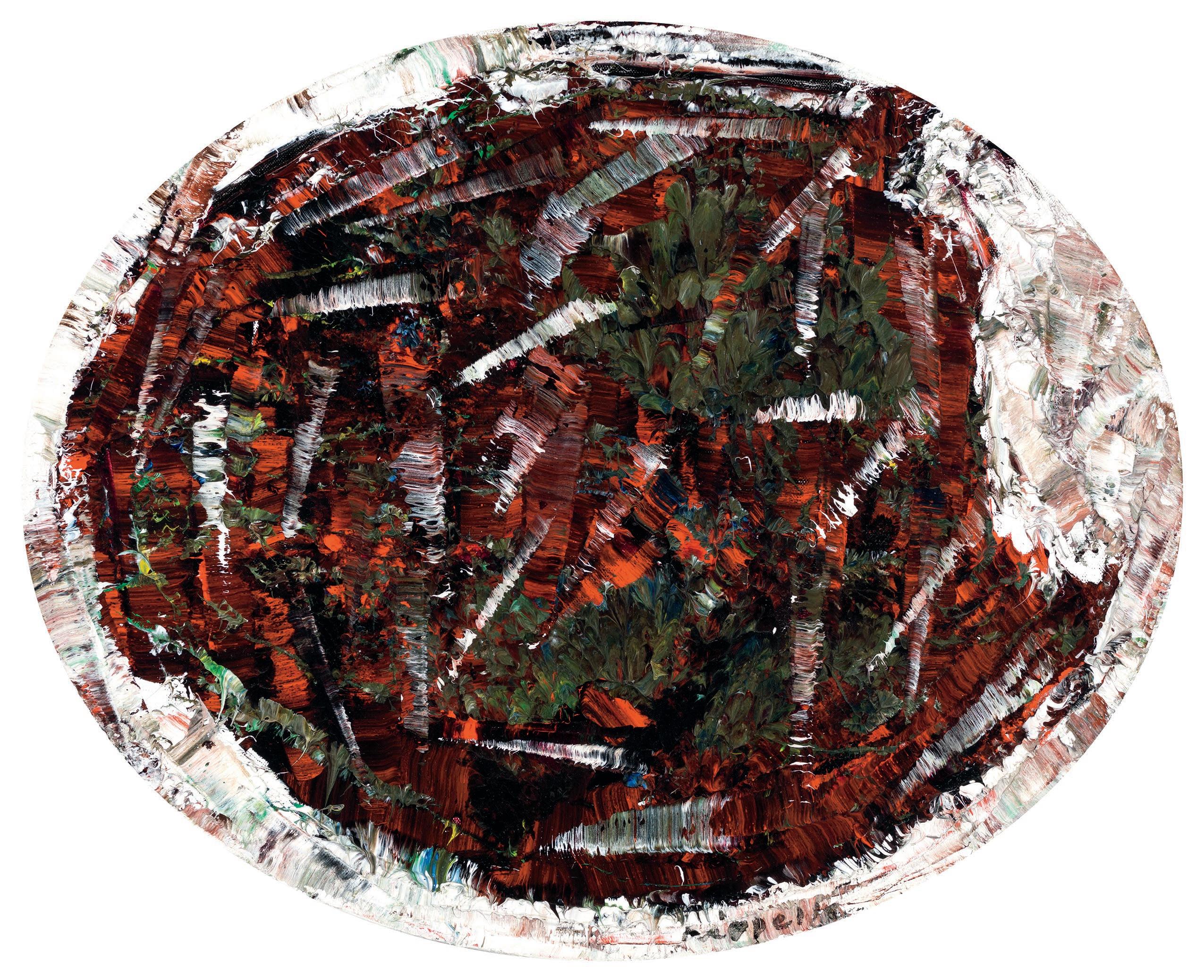
64
Ovale IV
oil on canvas, signed and on verso titled Oval IV and inscribed Brun and Y 18188 , 1977 13 1/8 × 16 1/8 in, 33.3 × 41 cm
Proven A nce
Galerie Maeght, Paris
Private Collection, Ottawa
Post-War & Contemporary Art, B yd ealers, May 29, 2022, lot 63
Private Collection, Toronto
l iter A ture
Yseult Riopelle, Jean Paul Riopelle Catalogue Raisonné, Volume 5, 1972 – 1979, 2020, reproduced page 237, catalogue #1977.107 H .1977
Andréanne Roy, Jacques Des Rochers and Yseult Riopelle, editors, Riopelle: The Call of Northern Landscapes and Indigenous Cultures, Montreal Museum of Fine Arts, 2020, pages 154 and 248
I N THE 1970 S , Jean Paul Riopelle made frequent trips from Paris to spend time in Canada. He built a studio in 1974 at Sainte-Marguerite-du-Lac-Masson in the Laurentians, and also frequented Isle-aux-Grues and Île-aux-Oies in Quebec on hunt ing and fishing trips with his friend Champlain Charest. The boreal forest of Quebec was a source for his abstract paintings at this time. As Charest stated, “Riopelle always started from something: there was always a substratum to what he produced. Riopelle always began with forms that he liked.” Riopelle’s love for nature and his identification with the territory of Quebec grew in the 1970s. He declared that he moved towards nature in his abstractions, and in this painting, you can feel the presence of the forest through colour—bright orange sparks like autumn leaves emerge from the depths of forest-green and earthy brown tones. Riopelle wielded his palette knife with passion, and here white mixed with other hues presses in from the edges like snow, while daggers of bright white slash across the surface. In Ovale iV, Riopelle’s experience of the boreal forest is distilled with great vitality.
65 31 Jean Paul Riopelle AUTO CAS OC QMG RCA SCA 1923 – 2002
e stim A te: $ 40,000 – 60,000
32 Jean Philippe Dallaire
Martine
oil on board, signed, titled and dated 1957 and on verso signed, titled, dated July 1957 and inscribed Ville St-Laurent, P. Qué, Canada
24 in, 50.8
Galerie Treize, Montreal, Jean-Philippe Dallaire— Dessins inédits de 1957, October 10 – November 23, 1982
One could say that I do not take life seriously. I always had a fondness for birds, little flags and the texture of fabrics. Perhaps it is a bit decorative, but so what.
NOWN f OR HIS joyful paintings depicting curious characters, Jean-Philippe Dallaire was one of the leading artists working fig uratively in the 1960s in Canada. He lived in Paris from 1938 to 1945, and during the German occupation from 1940 to 1944, he was held in Saint-Denis, an internment camp near Paris. During his stay in the French capital, he discovered Pablo Picasso and the Surrealists, and he met fellow Canadian artist Alfred Pellan. Sur realism, Cubism and art brut deeply influenced Dallaire’s work, long after he came back to Canada. In 1957, he was working as an illustrator for animated educational films at the National Film Board and worked from a studio in Ville Saint-Laurent.
This whimsical portrait wonderfully represents the artist’s many influences. A deconstructed character is drawn with cal ligraphic black lines and painted with bold planes of mottled colour. The titular Martine wears a red and white striped shirt, sports a short-cropped haircut and holds up a little orange flag. Dallaire’s singular exploration of form and colour is on full display in this delightful work.
Included with this lot is the accompanying preparatory ink on paper sketch by the artist, measuring 8 3/4 × 7 1/4 inches and framed.

66 K
e stim A te: $ 25,000 – 35,000
QMG 1916 – 1965
20 ×
× 61 cm Proven A nce Collection of the family of Paul-Vanier Beaulieu, Laval l iter A ture National Gallery of Canada, “Jean Dallaire,” https://www.gallery.ca/collection/artist/jean-dallaire e xhibited
J EAN -P HI l IPPE dA ll AIRE , 1957
Jean Paul Riopelle
Famine chiendent
bronze sculpture with patina, signed, editioned 3/8 and inscribed Fonderia Art. F.lli Bonvicini Sommacampagna, 1989
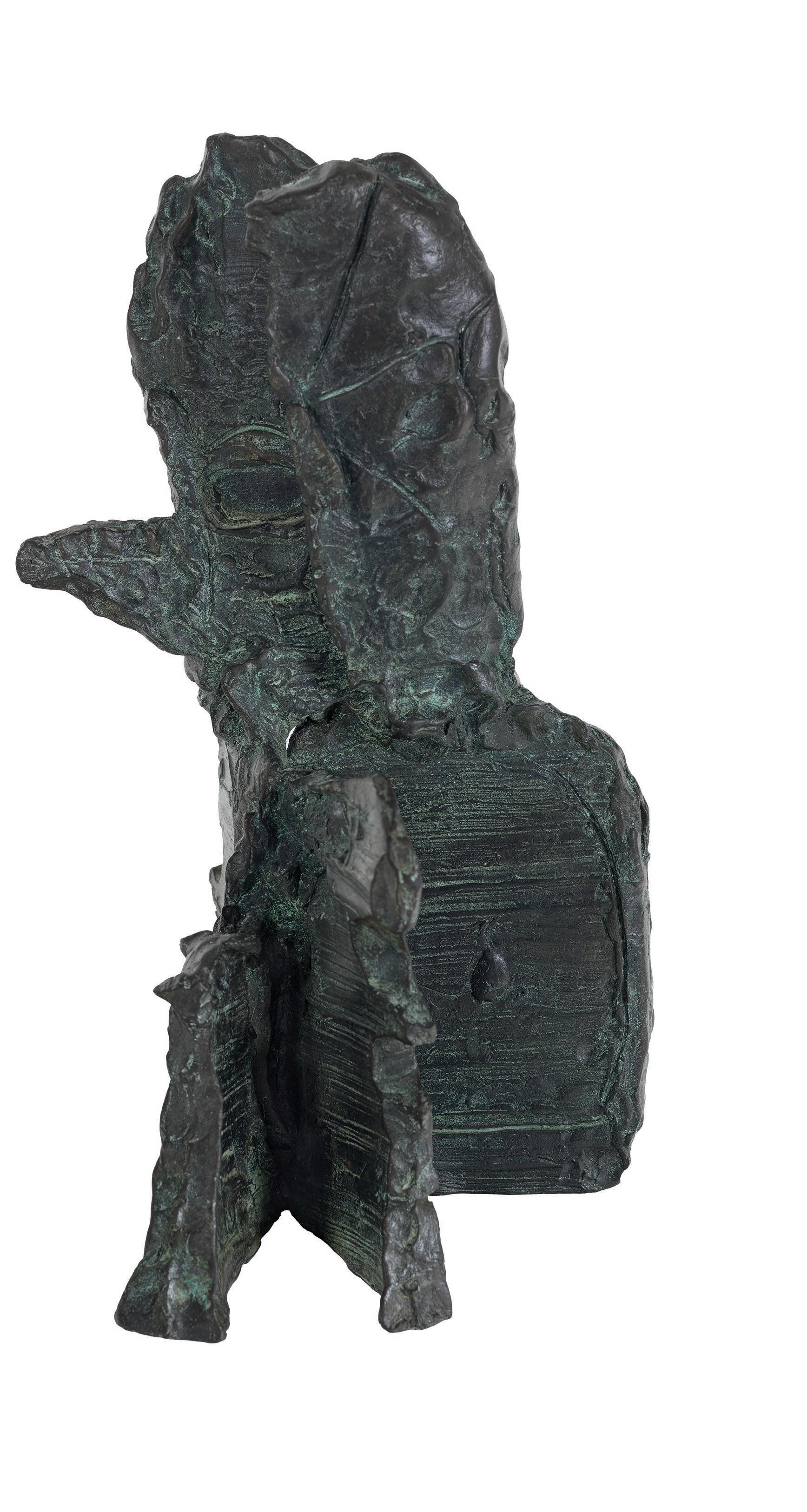
12 1/4 × 8 × 7 in, 31.1 × 20.3 × 17.8 cm
Proven A nce
Galerie Lelong, Paris Galerie d’art Michel Bigué, Saint-Sauveur-des-Monts
Private Collection, Montreal
l iter A ture
Yseult Riopelle and Gilles Daigneault, Riopelle—Mémoires d’ateliers, 2010, reproduced page 77, listed page 130
Yseult Riopelle, Jean Paul Riopelle Catalogue Raisonné, Volume 4, 1966 – 1971, 2014, reproduced page 498, catalogue #1970.10 SC .1970
I N THE SECON d half of the 1960s, Jean Paul Riopelle experienced a creative outburst that radically influenced his painted and printed works, and pushed him to integrate sculpture into his artistic practice. Although he focused greatly on his three-dimensional works during that specific period, his interest originated in his childhood, when he made sculptures out of snow. While other children were busy making traditional snowmen, Riopelle would create fantastical improvisations.
Between 1969 and 1972, Riopelle produced over 80 clay pieces. The majority of these were later executed in bronze, starting in 1970. Throughout his career, this ensemble of pieces followed him to his many studios, where he would place them in various arrangements like pieces on a chessboard. Not unlike his painted works, Riopelle’s sculptures have heavily tex tured finishes and irregular forms with creases and edges. The end result is organic, lively and deeply expressive.
Chiendent is the French common name for the invasive weed known as couch grass. The plant has edible roots that, once dried and pow dered, were mixed with flour for the production of pains de famine (breads of famine). Riopelle often gave surrealistic titles to his works, with occasional references to the natural world.
The terra cotta model for this sculpture was executed in 1970, and this bronze was cast in 1989.
67 33
AUTO CAS OC QMG RCA SCA 1923 – 2002
e stim A te: $ 25,000 – 35,000
The Yard
board,
Cutts Gallery, Toronto Private Collection,
early Abstract Expressionist work during the formative years of Painters Eleven, a group of Toronto-based painters who were determined to advance the case of abstraction and modernism in Ontario. Town quickly established himself as a standout in Anglo-Canada’s nascent abstract art movement. He was earnestly developing his own non-figurative language while explicitly looking to the painterly
advancements happening in New York—in particular Willem de Kooning’s action paintings.
Typical of his paintings in this early period, the entire canvas of The Yard is covered in a dense collage of textured brushwork, confidently overlaid with colour that arrives in bright shocks and energetic sweeps. Calligraphic scrawls move in tremors across the broadly applied pigment, and the whole canvas seems to buzz in a dense medley of colour and bristling energy. Town was often playful in naming his Abstract Expressionist canvases, and was frequently more interested in complicating rather than clarifying the relationship between the title and painted image. Here, we are not given a clear direction on how to interpret The Yard. Evoking something geographic or architectural, Town’s title suggests that the canvas has expanded to become a dimensional ized space, bursting at the seams to contain the painter’s vibrant expressionism.
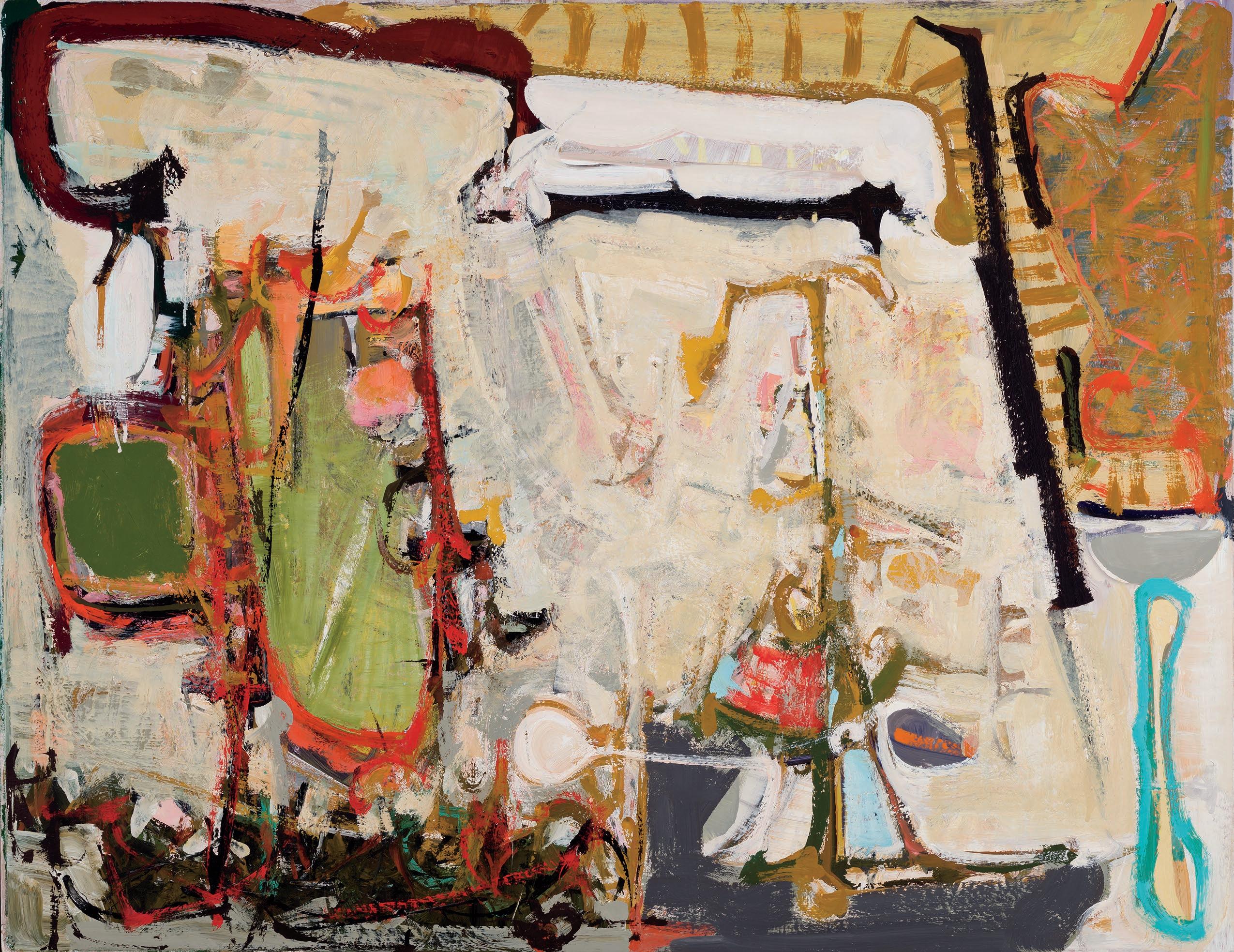
68
e stim A te: $ 25,000 – 35,000 34 Harold Barling Town CGP CPE CSGA OC OSA P1 1 RCA 1924 – 1990
oil on
on verso signed, titled, dated 1954 – 1955 and inscribed HTD 202-0 36 7/8 × 48 in, 93.7 × 121.9 cm Proven A nce Christopher
Toronto H ARO ld T OWN PAINTE d this
the frequent oscillation between representation and abstraction seen throughout his career.
Four Horizons, Reflections
Proven A nce Margery Steele, Toronto, 1967
descent to the present Private Collection, Ontario
AKAMURA WAS one of the founding members of Painters Eleven, a group of Toronto-based painters who showed together between 1953 and 1960, with a focus on abstraction. Near the end of this period, Nakamura developed and explored his interest in science, striving to find the intersections between art, nature, science, abstraction and geometry, believing that these shared universal patterns. This interest was expressed in
K
This work, produced in the decade following the dissolution of Painters Eleven, is a superb example of the artist’s “reflec tion” paintings. In these works, a high horizon line of blue-green forest stretches across an open lake, the sky and trees reflected delicately in the water in intricate patterns. In Four Horizons, Reflections, the scene is refracted and kaleidoscoped, reori ented from a horizontal landscape into the form of repeating, tessellated squares. The prismatic geometry is bordered by a bluish-white field—perhaps the sky above the treeline, itself reflected—making the abstracted “landscape” appear to float in an indeterminate void. The vast emptiness of the landscape is deflected through the shimmering compound lens of abstraction, showcasing Nakamura’s ability to find pattern and order in the natural world.
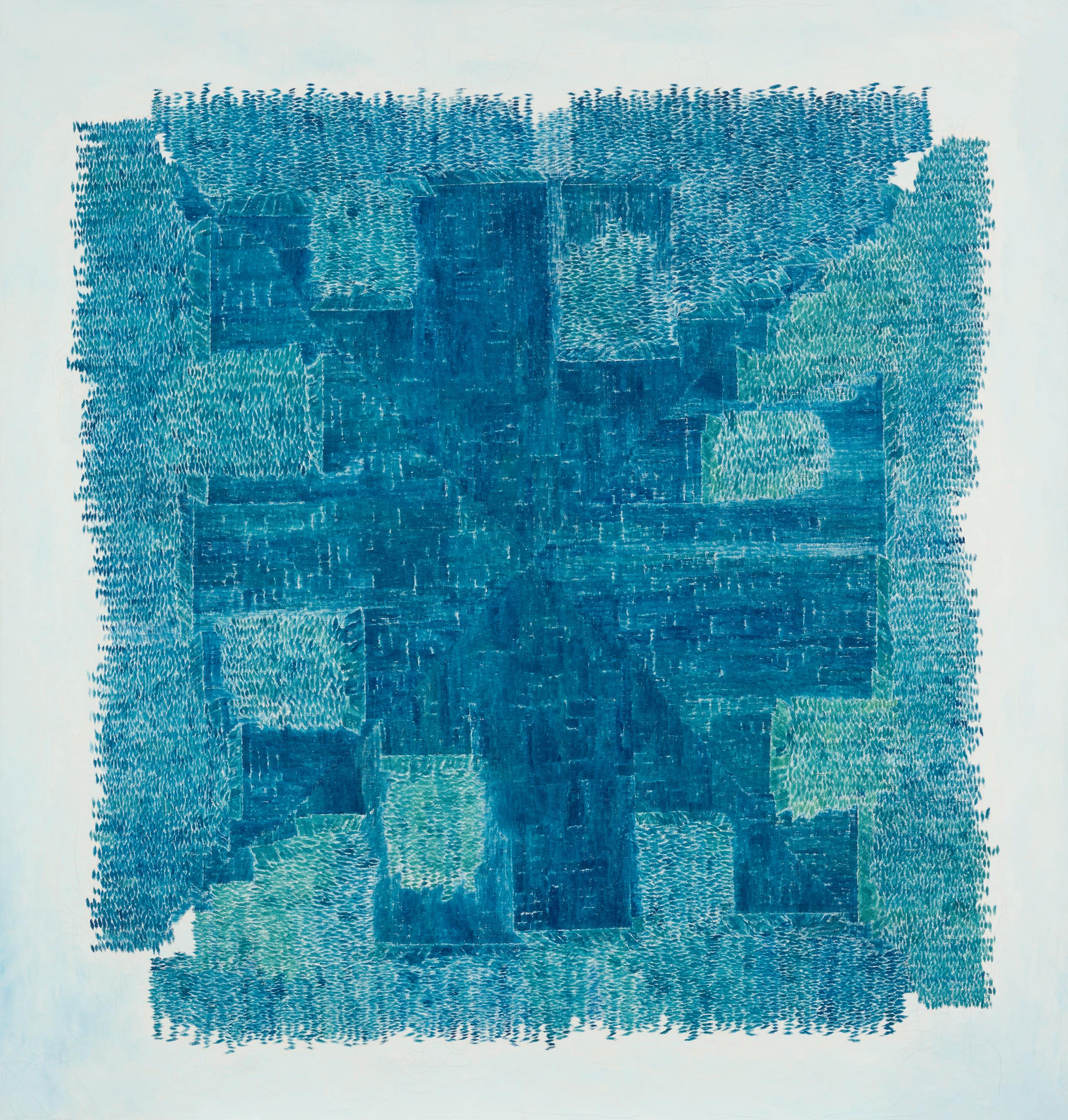
69
e stim A te: $ 25,000 – 35,000 35 Kazuo Nakamura CGP CSGA CSPWC P1 1 1926 – 2002
oil on canvas, on verso signed, titled on a label, dated 1967 and inscribed Toronto 9 45 × 43 in, 114.3 × 109.2 cm
By
A z UO N

70
36 Shara Hughes
1981 – American
Rough Rivers
oil, crayon and enamel on canvas, on verso signed, titled, dated 2017 and inscribed NYC 48 × 40 in, 121.9 × 101.6 cm
Proven A nce
Rachel Uffner Gallery, New York
Acquired from the above by the present Private Collection, Montreal
S HARA H UGHES IS a widely exhibited contemporary American artist whose vibrant paintings sit happily between landscape and abstraction. More “both / and” than one genre or the other, Rough Rivers deploys recognizable landscape motifs—hills and rivers for example—in an exuberantly abstracted, non-descriptive manner. Hers is a decidedly present-day take on both abstraction as a genre and method, and the long-standing attention to land scape in American painting. Little wonder that she was chosen to show in the 2017 Whitney Biennial, the longest-running survey of American art, and that her paintings are currently exhibited at the Kunstmuseum Luzern in Switzerland.
In Rough Rivers, Hughes spontaneously develops a remarkable vocabulary of abstracted earth, water and atmospheric forms. With the work wittily set in a “portrait” format, we can nonethe less readily see the fundamental land / sky divide of “landscape” formats running laterally across the bottom middle of the surface, set down with bold blue and green outlines. But this conventional composition is only hinted at, ready to be further improvised. The largely open zone at the bottom is not a foreground in any expected sense. Instead, it is light in tone, open in design, and—typically for this painting—rendered with a variety of tech niques. Red and blue forms appear to be stained into a porous surface, while their white, circular cousins and a few red streaks are painted on top of this dreamy support. The work is painterly, sensuous.
The upper reaches of the canvas could be described as “cos mic” in the sense that they appear as sky above the strong lateral horizon line and because the forms themselves are reminiscent of what we might see and imagine as we look up. The central green form, with its reverberating, outward moving circles, is planet like. This upper zone is animated by lightly applied streaks of dark blue against white paint. We notice that the snaking, river-like form that begins behind the central blue “mountain” winds its way beyond the top boundary of the surface, only to return in the upper right corner. In this way, it frames or holds the three highly coloured and inflected arabesques that dance across this part of the surface. What Hughes never does here is to confine her imaginative, exuberant forms. They are held to focus our attention, but not for analysis. One has the sense that meta morphosis governs this highly organic surface, that what we see now will transmute into an equally intriguing set of patterns and relationships even as we look on.
Painting. Landscape. Abstraction. Recorded with capitals, like chapter headings in a textbook, these categories certainly refer to well-traveled paths in the history of modern and indeed pre-modern art. Many have said that these traditions are outworn and should be eclipsed, but as Hughes shows in Rough Rivers, they continue to deliver inventiveness and visual pleasure. The paint ing opens towards the future by drawing on the experience and vocabulary afforded by reimagining its conventions.
We thank Mark Cheetham, Professor of Art History at the University of Toronto, for contributing the above essay. Cheetham is the author of two books on abstract art: The Rhetoric of Purity: Essentialist Theory and the Advent of Abstract Painting and Abstract Art Against Autonomy: Infection, Resistance, and Cure since the 60s.
Please note: this work is unframed.
e
stim A te: $ 250,000 – 350,000
71
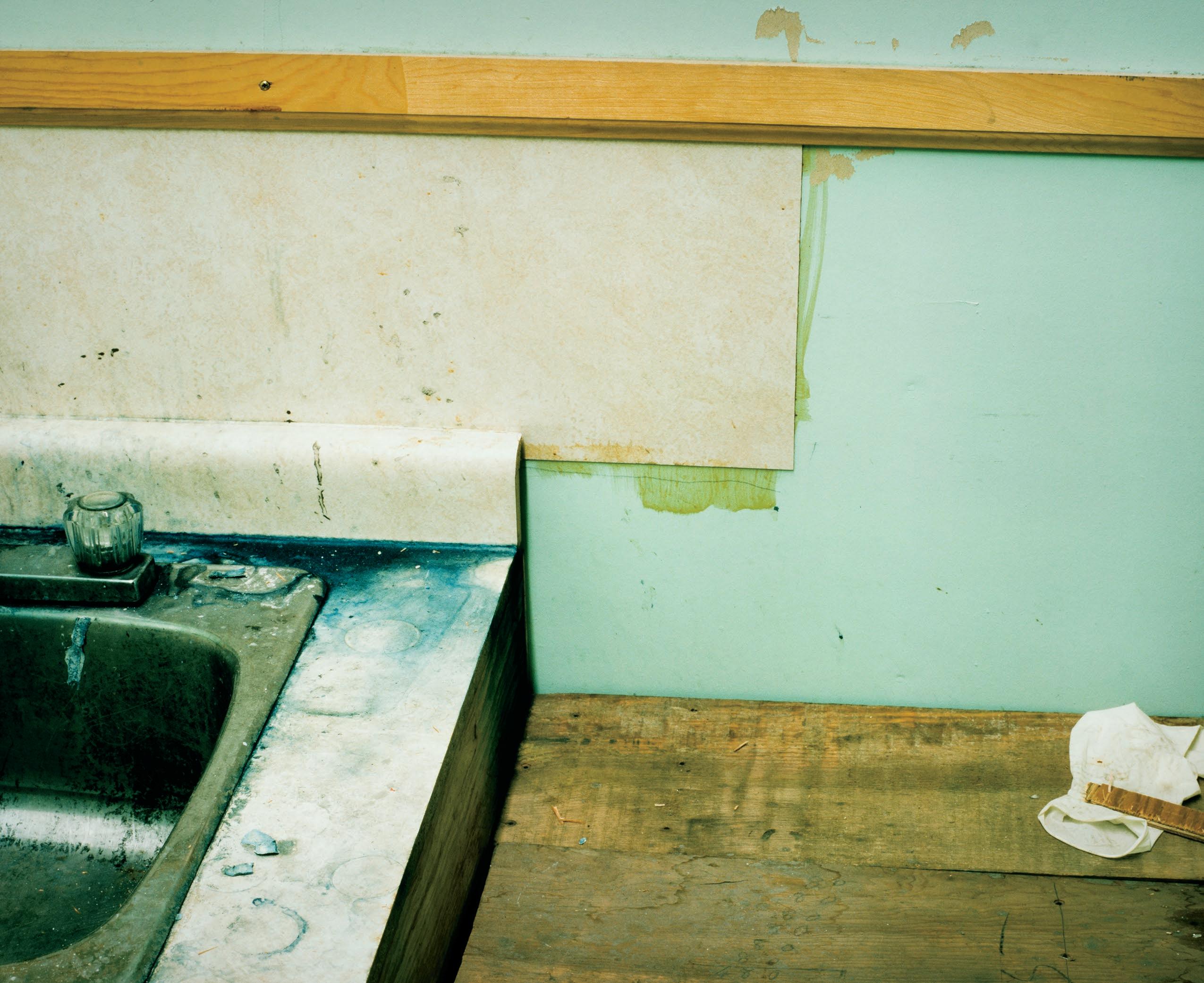
72
Wall
Diagonal Composition II
Cibachrome transparency in fluorescent light box display, on verso titled, editioned 4/8 and dated 1998 on a label 25 × 29 1/2 × 5 1/2 in, 63.5 × 74.9 × 14 cm
Proven A nce
White Cube, London, 2009
Private Collection, Toronto
l iter A ture
Rolf Lauter, editor, Jeff Wall: Figures & Places: Selected Works from 1978 – 2000, 2001, mentioned pages 51 and 53, reproduced, unpaginated Michael Fried, Why Photography Matters as Art as Never Before, 2008, page 72, reproduced page 53
O NE CANNOT OVEREMPHASI z E the importance of Jeff Wall’s photographs in the international art world, both now and over the past several decades. One of the most discussed and celebrated Canadian artists of any time, his reputation is well earned. He is a constant innovator in photography and an acute writer about art’s roles in society. He strives to see what photography is and can be. “The historical image I want to create is one which recognizes the complexity of the experiences we must have every day in develop ing relationships with the past,” he states.
One of his tactics, on display in Diagonal Composition ii, is to enter into conversation (rather than competition) with significant artworks and artists from the past, especially the “fathers” of modernism such as Édouard Manet, whose groundbreaking 1882 painting A Bar at the Folies-Bergère Wall restaged for the 1970s in the epically scaled backlit Cibachrome photograph Picture for Women (1979). He began using this “real world” technology— borrowed from advertising—in 1978, capitalizing on the glow of the image and, often, its large scale. How might the smaller and more humble Diagonal Composition ii keep company with Wall’s more dramatic photographic essays?
The work is disorienting at first, but we come to see that it is taken from a high, vertical angle into the corner of an unlovely room in which the filthy sink, wall and floor seem to compete for abuse. Unlike Picture for Women and most of Wall’s work, there is no clear narrative here, yet the backlit image radiates an unexpected allure, beckoning us to look harder because there
is “nothing to see.” With time, we appreciate vibrant colour, contrasting textures, and in general the materiality of the stuff we contemplate. Why look? Because the image is about looking at the everyday, about recording that process instead of seeing through the photograph to a storyline.
Unexpectedly too, several aspects of Diagonal Composition ii ally it to Wall’s ongoing examination of the powerful modern tradition in Western painting. Perhaps it glancingly refers to the concatenation of materials fundamental to synthetic Cubism. More persuasively, from its title to its appearance, the photograph enters into a dialogue with abstract art in the West, particularly that of the early twentieth century. In this context, subject matter itself was not always primary. Wall might have titled the piece In My Studio Basement but did not. Instead, one strain of the mod ernist theory of abstraction claims that images supply their own internal reference points, in this case, the interactions of colour, texture and composition. Even without the laconic but nonethe less leading title, we look for and find diagonal lines. Perhaps the most significant angle traces from the elevated viewpoint, which inscribes the presence of the photographer witnessing this scene. Abstract paintings are, of course, notorious for having neutral titles just like the one here, and appearing in seemingly random numbered series, suggesting that the viewer look at what is presented, not for an extra-pictorial narrative.
Diagonal Composition ii is significant in the artist’s career because its manner of composition is relatively unorchestrated (he calls this sort of photograph “documentary”), a dramatic difference from Wall’s characteristic practice of posing scenes with actors and manipulating them digitally (which he calls “cinematographic”). Yet he returned to versions of this still life composition three times between 1993 and 2000, seeing and recording variations. Even this scene of neglect becomes “aes thetic” in that it is a matter of conscious selection and, ironically, dramatic presentation. He turns on the light, literally and metaphorically.
We thank Mark Cheetham, Professor of Art History at the University of Toronto, for contributing the above essay. Cheetham is the author of two books on abstract art: The Rhetoric of Purity: Essentialist Theory and the Advent of Abstract Painting and Abstract Art Against Autonomy: Infection, Resistance, and Cure since the 60s
e stim A te: $ 100,000 – 150,000
73
37 Jeff
OC 1946 –


















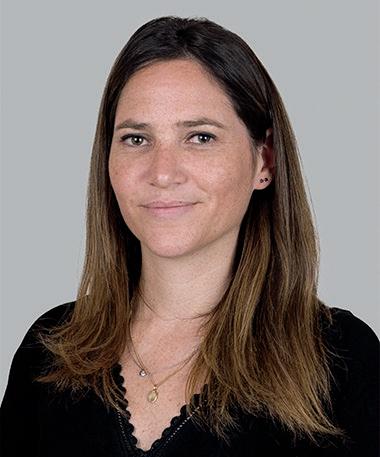







74 montre A l TA n IA Pogg I one Director of Montreal Office and Senior Specialist J AS m I n DA I gle Manager of Imaging, Montreal mA r I e-Hélène B u S que Co-Director of Online Auctions, Consignment Specialist rA n IA C HADDAD Senior Administrator, Consignment Specialist Jo H n mAC le A n Manager of Facilities, Montreal, Art Handler r o B er T C.S. Heffel Vice-President D AVID K.J. Heffel President toronto Ju DITH S C oln IK Past Director, Consignment Specialist An D er S oI nonen Art Handler lI n DSAy J ACKS on Director of Appraisals, Eastern Division, Consignment Specialist mA r TI e gI efer T Director of Imaging; Collector Motorcycle Specialist Kr ISTIA n mA r TI n Senior Administrator, Consignment Specialist m el I n A r ym B erg Manager of Toronto Office, Consignment Specialist re B e CCA r y KISS National Director, Brand and Communications D A n I el gA ll Ay Consignment Specialist wo JCI e CH ole J n IK Art Handler With the largest and most experienced team of fine art specialists in Canada, it is our mission to provide transparent and superior client service to sellers and buyers of fine art globally. f ine Art sP eci A lists g r AHA m HA ll Art Handler A n TH ony wu Asian Art Specialist A ll A n J. Be H ul Director of Heffel Numismatics ro CH elle K onn Consignment Specialist mATTH ew S CA r A f I le Client Services and Administration A le C K err Client Services and Administration, Consignment Specialist gor D on B u T ler Director of Art Handling and Storage Facilities mATHI eu lAC ro I x Art Handler A l I x D e SAI n T- H I l AI re Client Services and Administration o tt A w A A n D rew g IBBS Director of Ottawa Office, Consignment Specialist
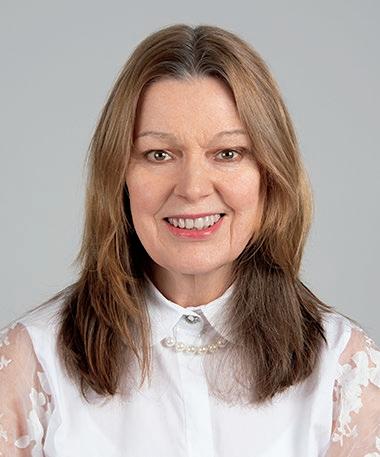

























75 cA lg A ry r o SA l I n Te o mr A Director of Art Research PATS y K I m Heffel Corporate Director lA uren Kr AT zer National Director of Consignments Bo BB y mA Master Framer, Manager of Storage Facility, North Vancouver g or A n u ro S e VIC Director of Information Services J A re D T I ller Manager of Online Auctions, Calgary, Consignment Specialist D e I r D re H ofer Consignment and Appraisal Specialist nor B er T mA Controller KI r BI P ITT Director of Marketing, Consignment Specialist m olly Ton K en Manager of Calgary Office, Consignment Specialist D ougl AS w ATT Art Handler g ID eon SA m S on Information Technology Support m ere DITH longr ID ge Senior Administrator Cl A r A w ong Director of Information Management, Consignment Specialist n orth v A ncouver SH erry w A ng Client Services and Administration Ke VI n o e H en Art Handler g regg C ASS elm A n Art Handler Jo SH Heffel Numismatics Client Services v A ncouver Jul IA B A l A z S Manager of Vancouver Office, Consignment Specialist wA r D B ASTIA n Manager of Imaging and Manager of Facilities, Vancouver mA r TI n Bur IA n Chief Financial Officer THIBA ulT B enne TT Co-Director of Online Auctions, Consignment Specialist AI n S ley H effel Manager of Appraisal Services, Consignment Specialist Se TH m en D oz A Art Handler Cyn THIA TAI Client Services and Administration K AT r I n A C H eng Manager of Heffel Numismatics
T HESE terms and Conditions of b usiness represent the terms upon which the Auction House contracts with the Consignor and, acting in its capacity as agent on behalf of the Consignor, contracts with the Buyer. These Terms and Conditions of Business shall apply to the sale of the Lot by the Auction House to the Buyer on behalf of the Consignor, and shall supersede and take precedence over any previously agreed Terms and Conditions of Business. These Terms and Conditions of Business are hereby incorporated into and form part of the Consignment Agreement entered into by the Auction House and the Consignor.
A d efined t erms
1. Auction House
The Auction House is Heffel Gallery Limited, or an affiliated entity;
2. Consignor
The Consignor is the person or entity named in the Consign ment Agreement as the source from which the Property or Lot has been received for auction;
3. Seller’s Commission
The Seller’s Commission is the amount paid by the Consignor to the Auction House on the sale of a Lot, which is calculated on the Hammer Price, at the rates specified in writing by the Consignor and the Auction House on the Consignment Agreement Form, plus applicable Sales Tax and Expenses;
4. Property
The Property is any Property delivered by the Consignor to the Auction House to be placed in the auction sale held by the Auction House on its premises, online or elsewhere and, specifically, that Property described by Lot number in the Auction House catalogue for the auction sale. The Auction House will have the authority to partition the Property into Lots (the “Lots” or “Lot”);
5. Reserve
The Reserve is a confidential minimum price for the sale of the Lot, agreed to between the Consignor and the Auction House. The Reserve will not exceed the low estimate;
6. Knocked Down
Knocked Down means the conclusion of the sale of the Lot being auctioned by the Auctioneer;
7. Expenses
Expenses shall include all costs incurred, directly or indirectly, in relation to the consignment and sale of the Lot;
8. Hammer Price
The Hammer Price is the price at which the Auctioneer has Knocked Down the Lot to the Buyer;
9. Buyer
The Buyer is the person, corporation or other entity or such enti ty’s agent who bids successfully on the Lot at the auction sale;
10. Purchase Price
The Purchase Price is the Hammer Price and the Buyer’s Premium, applicable Sales Tax and additional charges and Expenses, including expenses due from a defaulting Buyer;
11. Buyer’s Premium
The Buyer’s Premium is the amount paid by the Buyer to the Auction House on the purchase of a Lot, which is calcu lated on the Hammer Price as follows: a rate of twenty-five percent (25%) of the Hammer Price of the Lot up to and including $ 25,000; plus twenty percent (20%) on the part of the Hammer Price over $ 25,000 and up to and including $ 5,000,000; plus fifteen percent (15%) on the part of the Hammer Price over $ 5,000,000, plus applicable Sales Tax;
12. Sales Tax
Sales Tax means Federal and Provincial sales, excise and other taxes applicable to the sale of the Lot, applied using place of supply rules required by Canadian taxation authori ties. QST will be levied on all purchases collected in Quebec or shipped to Quebec;
13. Registered Bidder
A Registered Bidder is a bidder who has fully completed the registration process, provided the required information to the Auction House and has been assigned a unique paddle num ber for the purpose of bidding on Lots in the auction;
14. Proceeds of Sale
The Proceeds of Sale are the net amount due to the Consignor from the Auction House, which shall be the Hammer Price less Seller’s Commission at the Published Rates, Expenses, Sales Tax and any other amounts due to the Auction House or associated companies;
15. Live and Online Auctions
These Terms and Conditions of Business apply to all live and online auction sales conducted by the Auction House. For the purposes of online auctions, all references to the Auctioneer shall mean the Auction House and Knocked Down is a literal reference defining the close of the auction sale.
b t he b uyer
1. The Auction House
The Auction House acts solely as agent for the Consignor, except as otherwise provided herein.
2. The Buyer
a) The Buyer is the highest Registered Bidder acknowledged by the Auctioneer as the highest bidder at the time the Lot is Knocked Down;
76
t erms A nd c onditions of b usiness
b) The Auctioneer has the right, at their sole discretion, to reopen a Lot if they have inadvertently missed a Bid, or if a Registered Bidder, immediately at the close of a Lot, notifies the Auctioneer of their intent to Bid;
c) The Auctioneer shall have the right to regulate and control the bidding and to advance the bids in whatever intervals they consider appropriate for the Lot in question;
d) The Auction House shall have absolute discretion in settling any dispute in determining the successful bidder;
e) The Buyer acknowledges that invoices generated during the sale or shortly after may not be error free, and therefore are subject to review;
f) Every Registered Bidder shall be deemed to act as principal unless the Auction House has acknowledged in writing at least two (2) business days prior to the date of the auction that the Registered Bidder is acting as an agent on behalf of a dis closed principal and such agency relationship is acceptable to the Auction House;
g) In order to become a Registered Bidder, the registration pro cess shall be completed in full, and the required information shall be provided to the Auction House. Every Registered Bidder will be assigned a unique paddle number (the “Pad dle”) for the purpose of bidding on Lots in the auction. Those interested in bidding in the live auction via telephone bid, absentee bid or through the Digital Saleroom shall register at least two (2) business days in advance of the auction. For online auctions, a password will be created for use only in current and future online auctions. This online registration procedure does not allow for participation in the live auction and may require up to two (2) business days to complete;
h) Every Registered Bidder acknowledges that once a bid is made with their Paddle, or Paddle and password, as the case may be, it may not be withdrawn without the consent of the Auctioneer, who, in their sole discretion, may refuse such consent; and
i) Every Registered Bidder agrees that if a Lot is Knocked Down on their bid, they are bound to purchase the Lot for the Pur chase Price.
3. Buyer’s Price
The Buyer shall pay the Purchase Price (inclusive of the Buy er’s Premium) and applicable Sales Tax to the Auction House. The Buyer acknowledges and agrees that the Auction House may also receive a Seller’s Commission.
4. Sales Tax Exemption
All or part of the Sales Tax may be exempt in certain circum stances if the Lot is delivered outside of the jurisdiction of sale of the Lot. It is the Buyer’s obligation to demonstrate, to the satisfaction of the Auction House, that such delivery or removal results in an exemption from the relevant Sales Tax legislation. Shipments out of the jurisdiction of sale of the Lot(s) shall only be eligible for exemption from Sales Tax if shipped directly from the Auction House with shipping contracted by the Auction House. All claims for Sales Tax exemption must be made prior to or at the time of payment of the Purchase Price. Sales Tax will not be refunded once the Auction House has released the Lot. The Buyer agrees and shall fully indemnify the Auction House for any amount
claimed by any taxing authority due as Sales Tax upon the sale of the Lot, including any related costs, legal fees, interest and penalties.
5. Payment of the Purchase Price
a) The Buyer shall:
(i) unless they have already done so, provide the Auction House with their name, address and banking or other suitable refer ences as may be required by the Auction House; and
(ii) make payment by 4:30 p.m. on the seventh (7th) day follow ing the auction by: a) Bank Wire direct to the Auction House’s account, b) Certified Cheque or Bank Draft, c) Personal or Corporate Cheque, d) Debit Card and Credit Card only by Visa, Mastercard or Union Pay or e) Interac e-Transfer. Bank Wire payments should be made to the Royal Bank of Canada as per the account transit details provided on the invoice. All Certified Cheques, Bank Drafts and Personal or Corporate Cheques must be verified and cleared by the Auction House’s bank prior to all purchases being released. Credit Card pay ments are subject to our acceptance and approval and to a maximum of $ 5,000 if the Buyer is providing their Credit Card details by fax or to a maximum of $ 25,000 per Lot pur chased if paying online or if the Credit Card is presented in person with valid identification. The Buyer is limited to two e-Transfers per Lot and up to a maximum of $ 10,000 per e-Transfer as per the instructions provided on the invoice. In all circumstances, the Auction House prefers payment by Bank Wire.
b) Title shall pass, and release and/or delivery of the Lot shall occur, only upon payment of the Purchase Price by the Buyer and receipt of cleared funds by the Auction House.
6. Descriptions of Lot
a) All representations or statements made by the Auction House, or in the Consignment Agreement, or in the catalogue or other publication or report as to the authorship, origin, date, age, size, medium, attribution, genuineness, provenance, con dition or estimated selling price of the Lot are statements of opinion only. The Buyer agrees that the Auction House shall not be liable for any errors or omissions in the catalogue or any supplementary material produced by the Auction House;
b) All photographic representations and other illustrations pre sented in the catalogue are solely for guidance and are not to be relied upon in terms of tone or colour or necessarily to reveal any imperfections in the Lot;
c) Many Lots are of an age or nature which precludes them from being in pristine condition. Some descriptions in the catalogue or given by way of condition report make reference to damage and/or restoration. Such information is given for guidance only and the absence of such a reference does not imply that a Lot is free from defects, nor does any reference to particular defects imply the absence of others;
d) The prospective Buyer must satisfy themselves as to all mat ters referred to in a), b) and c) of this paragraph by inspection, other investigation or otherwise prior to the sale of the Lot. The Buyer acknowledges that the Buyer has not relied on the Auction House, its statements or descriptions in regard to determining whether or not to purchase a Lot. The Buyer understands it is incumbent upon the Buyer to inspect the Lot
77
and hire any necessary experts to make the determination as to the nature, authenticity, quality and condition of any Lot. If the prospective Buyer is unable to personally view any Lot, the Auction House may, upon request, e-mail or fax a condition report describing the Lot to the prospective Buyer. Although the Auction House takes great care in executing such condition reports in both written and verbal format, condition reports are only matters of opinion, are non-exhaustive, and the Buyer agrees that the Auction House shall not be held responsible for any errors or omissions contained within. The Buyer shall be responsible for ascertaining the condition of the Lot; and
e) The Auction House makes no representations or warranties to the Buyer that the Buyer of a Lot will acquire any copyright or other reproduction right in any purchased Lot.
7. Purchased Lot
a) The Buyer shall collect the Lot from the Auction House by 4:30 p.m. on the seventh (7th) day following the date of the auction sale, after which date the Buyer shall be responsible for all Expenses until the date the Lot is removed from the offices of the Auction House;
b) All packing, handling and shipping of any Lot by the Auction House is undertaken solely as a courtesy service to the Buyer, and will only be undertaken at the discretion of the Auction House and at the Buyer’s risk. Prior to all packing and ship ping, the Auction House must receive a fully completed and signed Shipping Authorization Form for Property and pay ment in full of all purchases; and
c) The Auction House shall not be liable for any damage to glass or frames of the Lot and shall not be liable for any errors or omissions or damage caused by packers and shippers, whether or not such agent was recommended by the Auction House.
8. Risk
a) The purchased Lot shall be at the Consignor’s risk in all respects for seven (7) days after the auction sale, after which the Lot will be at the Buyer’s risk. The Buyer may arrange insurance coverage through the Auction House at the then prevailing rates and subject to the then existing policy; and
b) Neither the Auction House nor its employees nor its agents shall be liable for any loss or damage of any kind to the Lot, whether caused by negligence or otherwise, while any Lot is in or under the custody or control of the Auction House. Proceeds received from the insurance shall be the extent of the Auction House’s liability for any loss, damage or diminution in value.
9. Non-payment and Failure to Collect Lot(s)
If the Buyer fails either to pay for or to take away any Lot by 4:30 p.m. on the seventh (7th) day following the date of the auction sale, the Auction House may in its absolute discretion be entitled to one or more of the following remedies without providing further notice to the Buyer and without prejudice to any other rights or remedies that the Auction House or the Consignor may have:
a) To issue judicial proceedings against the Buyer for damages for breach of contract together with the costs of such proceed ings on a full indemnity basis;
b) To rescind the sale of that or any other Lot(s) sold to the Buyer;
c) To resell the Lot or cause it to be resold by public or private sale, or by way of live or online auction, with any deficiency to be claimed from the Buyer and any surplus, after Expenses, to be delivered to the Buyer;
d) To store the Lot on the premises of the Auction House or third-party storage facilities with Expenses accruing to the account of the Buyer, and to release the Lot to the Buyer only after payment of the Purchase Price and Expenses to the Auc tion House;
e) To charge interest on the Purchase Price at the rate of five percent (5%) per month above the Royal Bank of Canada base rate at the time of the auction sale and adjusted month to month thereafter;
f) To retain that or any other Lot sold to or consigned by the Buyer at the same or any other auction and release the same only after payment of the aggregate outstanding Purchase Price;
g) To apply any Proceeds of Sale of any Lot then due or at any time thereafter becoming due to the Buyer towards settle ment of the Purchase Price, and the Auction House shall be entitled to a lien on any other property of the Buyer that is in the Auction House’s possession for any purpose;
h) To apply any payments made by the Buyer to the Auction House towards any sums owing from the Buyer to the Auc tion House without regard to any directions received from the Buyer or their agent, whether express or implied;
i) In the absolute discretion of the Auction House, to refuse or revoke the Buyer’s registration in any future auctions held by the Auction House; and
j) All the above rights and remedies granted to the Auction House may be assigned to the Consignor at the Auction House’s discretion. Further, the Auction House may disclose to the Consignor the Buyer’s identity, contact information and other such information as the Consignor may need in order to maintain a claim against the Buyer for non-payment.
10. No Warranty
The Auction House, its employees and agents shall not be responsible for the correctness of any statement as to the authorship, origin, date, age, size, medium, attribution, gen uineness or provenance of any Lot or for any other errors of description or for any faults or defects in any Lot, and no warranty whatsoever is given by the Auction House, its employees or agents in respect of any Lot, and any express or implied conditions or warranties are hereby excluded.
11. Attendance by Buyer
a) Prospective Buyers are advised to inspect the Lot(s) before the sale, and to satisfy themselves as to the description, attri bution and condition of each Lot. The Auction House will arrange suitable viewing conditions during the preview pre ceding the sale, or by private appointment;
b) If prospective Buyers are unable to personally attend the live auction, telephone bid, or bid in the Digital Saleroom, the Auction House will execute bids on their behalf subject to completion of the proper Absentee Bid Form, duly signed and delivered to the Auction House two (2) business days before the start of the auction sale. The Auction House shall not
78
be responsible or liable in the making of any such bid by its employees or agents;
c) In the event that the Auction House has received more than one Absentee Bid Form on a Lot for an identical amount and at auction those absentee bids are the highest bids for that Lot, the Lot shall be Knocked Down to the person whose Absentee Bid Form was received first; and
d) At the discretion of the Auction House, the Auction House may execute bids in the live auction, if appropriately instructed by telephone or through Heffel’s Digital Sale room, on behalf of the prospective Buyer, and the prospective Buyer hereby agrees that neither the Auction House nor its employees nor agents shall be liable to either the Buyer or the Consignor for any neglect or default in making such a bid.
12. Export Permits
Without limitation, the Buyer acknowledges that certain property of Canadian cultural importance sold by the Auction House may be subject to the provisions of the Cultural Prop erty Export and Import Act (Canada), and that compliance with the provisions of the said act is the sole responsibility of the Buyer. Failure by the Buyer to obtain any necessary export license shall not affect the finality of the sale of the Lot or the obligations of the Buyer.
c . the consignor
1. The Auction House
a) The Auction House shall have absolute discretion as to whether the Lot is suitable for sale, the particular auction sale for the Lot, the date of the auction sale, the manner in which the auction sale is conducted, the catalogue descriptions of the Lot, and any other matters related to the sale of the Lot at the auction sale;
b) The Auction House reserves the right to withdraw any Lot at any time prior to the auction sale if, in the sole discretion of the Auction House:
(i) there is doubt as to its authenticity; (ii) there is doubt as to the accuracy of any of the Consignor’s representations or warranties; (iii) the Consignor has breached or is about to breach any provi sions of the Consignment Agreement; or (iv) any other just cause exists.
c) In the event of a withdrawal pursuant to Conditions C.1.b (ii) or (iii), the Consignor shall pay a charge to the Auction House, as provided in Condition C.8.
2. Warranties and Indemnities
a) The Consignor warrants to the Auction House and to the Buyer that the Consignor has and shall be able to deliver unencumbered title to the Lot, free and clear of all claims. You, as the Consignor, are the owner of the Lot or a joint owner of the Lot acting with the express permission of all of the other co-owners, or, if you are not the owner of the Lot: (i) You have the permission of the owners to sell the property under the terms of this Agreement and the Buyer’s Agreement; (ii) You will disclose to the owner(s) all material facts in relation to the sale of the Lot;
(iii)
You are irrevocably authorized to receive the proceeds of sale on behalf of the owner(s) of the Lot;
(iv) You have or will obtain the consent of the owner(s) before you deduct any commission, costs or other amounts from the proceeds of sale you receive from the Auction House;
(v) You have conducted appropriate customer due diligence on the owner(s) of the Lot in accordance with any and all appli cable anti money laundering and sanctions laws, consent to us relying on this due diligence and will retain for a period of not less than five (5) years the documentation and records evidencing the due diligence;
(vi) You will make such documentation and records (including originals, if available) evidencing your due diligence promptly available for immediate inspection by an independent thirdparty auditor upon our written request to do so. The Auction House will not disclose such documentation and records to any third parties unless (1) it is already in the public domain, (2) it is required to be disclosed by law, or (3) it is in accor dance with anti–money laundering laws; and
(vii) You and your principal (if any) are not aware of, nor are you knowingly engaged in any activity designed to facilitate tax evasion or tax fraud.
b) At the time of handing over the Property to us, you have met all import and export requirements of all applicable law. You are not aware that anyone else has failed to meet these requirements;
c) The Property and any proceeds of sale paid to you pursuant to this Agreement will not be used for any unlawful purpose and are not connected with any unlawful activity;
d) The Consignor shall indemnify the Auction House, its employees and agents and the Buyer for breach of its repre sentations, warranties and obligations set forth herein and against all claims made or proceedings brought by persons entitled or purporting to be entitled to the Lot;
e) The Consignor shall indemnify the Auction House, its employees and agents and the Buyer against all claims made or proceedings brought due to any default of the Consignor in complying with any applicable legislation, regulations and these Terms and Conditions of Business; and
f) The Consignor shall reimburse the Auction House in full and on demand for all costs, Expenses, judgment, award, settlement, or any other loss or damage whatsoever made, including reasonable legal fees incurred or suffered as a result of any breach or alleged breach by the Consignor of Conditions or its obligations as set forth in this Agreement.
3. Reserves
The Auction House is authorized by the Consignor to Knock Down a Lot at less than the Reserve, provided that, for the purposes of calculating the Proceeds of Sale due to the Con signor, the Hammer Price shall be deemed to be the full amount of the agreed Reserve established by the Auction House and the Consignor.
4. Commission and Expenses
a) The Consignor authorizes the Auction House to deduct the Seller’s Commission and Expenses from the Hammer Price
79
and, notwithstanding that the Auction House is the Consign or’s agent, acknowledges that the Auction House shall charge and retain the Buyer’s Premium;
b) The Consignor shall pay and authorizes the Auction House to deduct all Expenses incurred on behalf of the Consignor, together with any Sales Tax thereon including but not limited to:
(i) the costs of packing the Lot and transporting it to the Auction House, including any customs, export or import duties and charges;
(ii) if the Lot is unsold, the costs of packing it and returning it to the Consignor, including any customs, export or import duties and charges;
(iii) the costs of any restoration to the Lot that has been agreed by the Consignor in advance;
(iv) the costs of any framing and/or unframing, and any mount ing, unmounting and/or remounting, if applicable for the Lot;
(v) the costs of any third-party expert opinions or certificates that the Auction House believes are appropriate for the Lot;
(vi) the costs of any physically non-invasive tests or analyses that the Auction House believes need to be carried out to decide the quality of the Lot, its artist or that it is authentic; and (vii) the costs of photographing the Lots for use in the catalogue and/or promoting the sale of the Lot or auction.
c) The Auction House retains all rights to photographic and printing material and the right of reproduction of such photographs.
5. Insurance
a) Lots are only covered by insurance under the Fine Arts Insurance Policy of the Auction House if the Consignor so authorizes;
b) The rate of insurance premium payable by the Consignor is $ 15 per $ 1,000 (1.5%) of the greater value of the high esti mate value of the Lot or the realized Hammer Price or for the alternative amount as specified in the Consignment Receipt;
c) If the Consignor instructs the Auction House not to insure a Lot, THE AUCTION HOUSE SHAll HAVE NO lIABIlIT y Of ANy KINd fOR ANy lOSS, THEf T, dAMAGE, dIMINISHEd VAlUE TO THE lOT WHIlE IN ITS CARE, CUSTOdy OR CONTROl, and the Lot shall at all times remain at the risk of the Consignor, who hereby undertakes to:
(i) indemnify the Auction House against all claims made or proceedings brought against the Auction House in respect of loss or damage to the Lot of whatever nature, howsoever and wheresoever occurred, and in any circumstances even where negligence is alleged or proven;
(ii) reimburse the Auction House for all Expenses incurred by the Auction House. Any payment which the Auction House shall make in respect of such loss or damage or Expenses shall be binding upon the Consignor and shall be accepted by the Consignor as conclusive evidence that the Auction House was liable to make such payment; and (iii) notify any insurer of the existence of the indemnity contained in these Terms and Conditions of Business.
d) The Auction House does not accept responsibility for Lots damaged by changes in atmospheric conditions and the Auc tion House shall not be liable for such damage nor for any other damage to picture frames or to glass in picture frames; and
e) The value for which a Lot is insured under the Fine Arts Insurance Policy of the Auction House in accordance with Condition C.5.b above shall be the total amount due to the Consignor in the event of a successful claim being made against the Auction House. The actual proceeds received from the Auction House’s insurance shall be and shall repre sent the sole liability of the Auction House for any damages, loss, theft or diminished value of the Lot. Under no circum stances shall the Auction House be liable for any special, consequential, incidental or indirect damages of any kind or lost profits or potential lost profits.
6. Payment of Proceeds of Sale
a) The Auction House shall pay the Proceeds of Sale to the Con signor thirty-five (35) days after the date of sale, if the Auction House has been paid the Purchase Price in full by the Buyer;
b) If the Auction House has not received the Purchase Price from the Buyer within the time period specified, then the Auction House will pay the Proceeds of Sale within seven (7) working days following receipt of the Purchase Price from the Buyer; and
c) If before the Purchase Price is paid in full by the Buyer, the Auction House pays the Consignor an amount equal to the Proceeds of Sale, title to the property in the Lot shall pass to the Auction House.
7. Collection of the Purchase Price
If the Buyer fails to pay to the Auction House the Purchase Price within thirty (30) days after the date of sale, the Auction House will endeavour to take the Consignor’s instructions as to the appropriate course of action to be taken and, so far as in the Auction House’s opinion such instructions are practicable, will assist the Consignor in recovering the Purchase Price from the Buyer, save that the Auction House shall not be obligated to issue judicial proceedings against the Buyer in its own name. Notwithstanding the foregoing, the Auction House reserves the right and is hereby authorized at the Consignor’s expense, and in each case at the absolute discretion of the Auction House, to agree to special terms for payment of the Purchase Price, to remove, store and insure the Lot sold, to settle claims made by or against the Buyer on such terms as the Auction House shall think fit, to take such steps as are necessary to collect monies from the Buyer to the Consignor and, if appro priate, to set aside the sale and refund money to the Buyer.
8. Charges for Withdrawn Lots
The Consignor may not withdraw a Lot prior to the auction sale without the consent of the Auction House. In the event that such consent is given, or in the event of a withdrawal pursuant to Condition C.1.b (ii) or (iii), a charge of twenty-five percent (25%) of the high presale estimate, together with any applicable Sales Tax and Expenses, is immediately payable to the Auction House, prior to any release of the Property.
9. Unsold Lots
a) Unsold Lots must be collected at the Consignor’s expense within the period of ninety (90) days after receipt by the Consignor of notice from the Auction House that the Lots
80
are to be collected (the “Collection Notice”). Should the Consignor fail to collect the Lot from the Auction House within ninety (90) days from the receipt of the Collection Notice, the Auction House shall have the right to place such Lots in the Auction House’s storage facilities or third-party storage facilities, with Expenses accruing to the account of the Consignor. The Auction House shall also have the right to sell such Lots by public or private sale and on such terms as the Auction House shall alone determine, and shall deduct from the Proceeds of Sale any sum owing to the Auction House or to any associated company of the Auction House including Expenses, before remitting the balance to the Con signor. If the incurred Expenses by the Auction House exceed the sums received from the sale of the Lot, the Buyer shall be liable for the difference between the sums received and the Expenses. If the Consignor cannot be traced, the Auction House shall place the funds in a bank account in the name of the Auction House for the Consignor. In this condition the expression “Proceeds of Sale” shall have the same meaning in relation to a private sale as it has in relation to a sale by auction;
b) Lots returned at the Consignor’s request shall be returned at the Consignor’s risk and expense and will not be insured in transit unless the Auction House is otherwise instructed by the Consignor at the Consignor’s expense; and
c) If any Lot is unsold by auction, the Auction House is autho rized as the exclusive agent for the Consignor for a period of ninety (90) days following the auction to sell such Lot by private sale or auction sale for a price that will result in a pay ment to the Consignor of not less than the net amount (i.e., after deduction of the Seller’s Commission and Expenses) to which the Consignor would have been entitled had the Lot been sold at a price equal to the agreed Reserve, or for such lesser amount as the Auction House and the Consignor shall agree. In such event, the Consignor’s obligations to the Auc tion House hereunder with respect to such a Lot are the same as if it had been sold at auction. The Auction House shall continue to have the exclusive right to sell any unsold Lots after the said period of ninety (90) days, until such time as the Auction House is notified in writing by the Consignor that such right is terminated.
10. Consignor’s Sales Tax Status
The Consignor shall give to the Auction House all relevant information as to their Sales Tax status with regard to the Lot to be sold, which the Consignor warrants is and will be correct and upon which the Auction House shall be entitled to rely.
11. Photographs and Illustrations
In consideration of the Auction House’s services to the Con signor, the Consignor hereby warrants and represents to the Auction House that the Consignor has the right to grant to the Auction House, and the Consignor does hereby grant to the Auction House, a non-exclusive, perpetual, fully paid up, royalty-free and non-revocable right and permission to: a) reproduce (by illustration, photograph, electronic reproduc tion, or any other form or medium whether presently known or hereinafter devised) any work within any Lot given to the Auction House for sale by the Consignor; and
b) use and publish such illustration, photograph or other repro duction in connection with the public exhibition, promotion and sale of the Lot in question and otherwise in connection with the operation of the Auction House’s business, including without limitation by including the illustration, photograph or other reproduction in promotional catalogues, compila tions, the Auction House’s Art Index, and other publications and materials distributed to the public, and by communicat ing the illustration, photograph or other reproduction to the public by telecommunication via an Internet website oper ated by or affiliated with the Auction House (“Permission”). Moreover, the Consignor makes the same warranty and rep resentation and grants the same Permission to the Auction House in respect of any illustrations, photographs or other reproductions of any work provided to the Auction House by the Consignor. The Consignor agrees to fully indemnify the Auction House and hold it harmless from any damages caused to the Auction House by reason of any breach by the Consignor of this warranty and representation.
d . gener A l conditions
1. The Auction House as agent for the Consignor is not respon sible for any act, omission or default by the Consignor or the Buyer.
2. The Auction House shall have the right at its absolute discre tion to refuse admission to its premises or attendance at its auctions by any person.
3. The Auction House has the right at its absolute discretion to refuse any bid, to advance the bidding as it may decide, to with draw or divide any Lot, to combine any two or more Lots and, in the case of dispute, to put up any Lot for auction again. At no time shall a Registered Bidder retract or withdraw their bid.
4. The Auctioneer may open the bidding on any Lot below the Reserve by placing a bid on behalf of the Auction House. The Auctioneer, on behalf of the Auction House, may continue to bid up to the amount of the Reserve, either by placing consec utive bids or by placing bids in response to other bidders.
5. For advertising and promotional purposes, the Consignor acknowledges and agrees that the Auction House shall, in relation to any sale of the Lot, make reference to the aggre gate Purchase Price of the Lot, inclusive of the Buyer’s Premium, notwithstanding that the Seller’s Commission is calculated on the Hammer Price.
6. Any indemnity hereunder shall extend to all actions, pro ceedings, costs, claims and demands whatsoever incurred or suffered by the person for whose benefit the indemnity is given, and the Auction House shall hold any indemnity on trust for its employees and agents where it is expressed to be for their benefit.
7. Any notice given hereunder shall be in writing and if given by post shall be deemed to have been duly received by the addressee within three (3) business days delivered by a recog nized overnight delivery service with a signature required.
8. The copyright for all illustrations and written matter relating to the Lots shall be and will remain at all times the absolute property of the Auction House and shall not, without the prior written consent of the Auction House, be used by any other person.
81
9. The Auction House will not accept any liability for any fail ure or errors that may occur in the operation of any online, telephonic, video or digital representations produced and/or broadcasted during an auction sale.
10. This Agreement shall be governed by and construed in accor dance with British Columbia Law and the laws of Canada applicable therein. Any dispute, controversy or claim arising out of, relating to, or in connection with this Agreement, or the breach, termination, or validity thereof (“Dispute”), shall be submitted for mediation in Vancouver, British Columbia, Canada. If the Dispute is not settled by mediation within sixty (60) days from the date when mediation is initiated, then the Dispute shall be submitted for final and binding arbitration to the British Columbia International Commercial Arbitra tion Centre, with such Dispute to be resolved pursuant to its Rules and procedure. The arbitration shall be conducted by one arbitrator, who shall be appointed within thirty (30) days after the initiation of the arbitration. The language used in the arbitration proceedings will be English. The arbitra tion shall be confidential, except to the extent necessary to enforce a judgment or where disclosure is required by law. The arbitration award shall be final and binding on all parties involved. Judgment upon the award may be entered by any court having jurisdiction thereof or having jurisdiction over the relevant party or its assets.
11. Unless otherwise provided for herein, all monetary amounts referred to herein shall refer to the lawful money of Canada.
12. All words importing the singular number shall include the plural and vice versa, and words importing the use of any gen der shall include the masculine, feminine and neuter genders and the word “person” shall include an individual, a trust, a partnership, a body corporate, an association or other incor porated or unincorporated organization or entity.
13. If any provision of this Agreement or the application thereof to any circumstances shall be held to be invalid or unen forceable, the remaining provisions of this Agreement, or the application thereof to other circumstances, shall not be affected thereby and shall be held valid to the full extent permitted by law.
14. In the event of any discrepancy or conflict between the English and French versions of these Terms and Conditions of Business, the English version will prevail.
The Buyer and the Consignor are hereby advised to read fully the Agreement which sets out and establishes the rights and obligations of the Auction House, the Buyer and the Consignor and the terms by which the Auction House shall conduct the sale and handle other related matters.
P ro P erty collection notice
H E ff E l G A ll ER y lIMITE d maintains a strict Property Col lection Notice policy that governs the Property collection terms between the Auction House and the Consignor, Buyer and Clients being provided professional services from the Auction House. The Collection Notice is pursuant to the Auction House’s published Terms and Conditions of Business with specific reference to Conditions B.7, B.9, B.12, C.5, C.9 and D.6.
A . P ro P erty collection re Q uirement
1. Buyer
a) Sold Property must be collected or have a completed and signed Shipping Authorization Form for Property submitted to the Auction House within seven (7) days post auction sale date and a shipping dispatch date not greater than thirty (30) days post auction sale date;
2. Consignor
a) Unsold Property must be collected by the Consignor within ninety (90) days post auction sale date;
3. Client being provided additional professional services
a) Property delivered and deposited with the Auction House by the Client for the purpose of appraisal, assessment, research, consultancy, photography, framing, conservation or for other purpose must be collected within thirty (30) days after deliv ery receipt of the Property to the Auction House.
b tre Atment of P ro P erty collection notice
defA ult A nd of uncl A imed P ro P erty
1. All Property in default to the Property Collection Notice, as defined in Condition A, will be resolved as follows: a) Property in default of the Property Collection Notice will require a completed and signed Auction House or third party Storage Agreement for Property submitted to the Auction House within seven (7) days of default; b) Property listed in the signed and completed Storage Agreement for Property may be moved off-site from the Auction House offices or preview galleries to warehouse storage at the Prop erty Owner’s expense; c) Remaining unclaimed Property will be subject to the Unclaimed Property Act (British Columbia) [SBC 1999] 199948-19 to 32 and consequential amendments and repeal.
These Property Collection Notice terms shall supersede and take precedence over any previously agreed terms.
82
VERSION 2021.11 © H E ff E l G A ll ER y lIMITE d
VERSION 2020.03 © H E ff E l G A ll ER y lIMITE d
AAM Art Association of Montreal founded in 1860
AAN f M Association des artistes non-figuratifs de Montréal
AAP Association des arts plastiques
ACM Arts Club of Montreal
AGA Art Guild America
AGQ Association des graveurs du Québec
AHSA Art, Historical and Scientific Association of Vancouver
A l C Arts and Letters Club
AOCA Associate Ontario College of Art
ARCA Associate Member Royal Canadian Academy of Arts
ASA Alberta Society of Artists
ASPWC American Society of Painters in Water Colors
ASQ Association des sculpteurs du Québec
AUTO Les Automatistes
AWCS American Watercolor Society
BCSA British Columbia Society of Artists
BCS fA British Columbia Society of Fine Arts founded in 1909
BHG Beaver Hall Group, Montreal 1920 – 1922
CAC Canadian Art Club
CAS Contemporary Arts Society
CC Companion of the Order of Canada
CGP Canadian Group of Painters 1933 – 1969
CH Companion of Honour Commonwealth
CPE Canadian Painters–Etchers’ Society
CSAA Canadian Society of Applied Art
CSGA Canadian Society of Graphic Artists founded in 1905
CSMA Canadian Society of Marine Artists
CSPWC Canadian Society of Painters in Water Colour founded in 1925
EGP Eastern Group of Painters
f BA Federation of British Artists
f CA Federation of Canadian Artists
f RSA Fellow of the Royal Society of Arts
G 7 Group of Seven 1920 – 1933
IA f Institut des arts figuratifs
IWCA Institute of Western Canadian Artists
l P Les Plasticiens
MSA Montreal Society of Arts
NA d National Academy of Design
NEAC New English Art Club
NSSA Nova Scotia Society of Artists
OC Order of Canada
OIP Ontario Institute of Painters
OM Order of Merit British
OSA Ontario Society of Artists founded in 1872
P 11 Painters Eleven 1953 – 1960
P d CC Print and Drawing Council of Canada
PNIAI Professional Native Indian Artists Incorporation
POSA President Ontario Society of Artists
PPCM Pen and Pencil Club, Montreal
PRCA President Royal Canadian Academy of Arts
PSA Pastel Society of America
PSC Pastel Society of Canada
P y Prisme d’yeux
QMG Quebec Modern Group
R 5 Regina Five 1961 – 1964
RA Royal Academy
RAAV Regroupement des artistes en arts visuels du Québec
RAIC Royal Architects Institute of Canada
RBA Royal Society of British Artists
RCA Royal Canadian Academy of Arts founded in 1880
RI Royal Institute of Painters in Watercolour
RMS Royal Miniature Society
ROI Royal Institute of Oil Painters
RPS Royal Photographic Society
RSA Royal Scottish Academy
RSC Royal Society of Canada
RSMA Royal Society of Marine Artists
RSPP Royal Society of Portrait Painters
RWS Royal Watercolour Society
SAA Society of American Artists
SAAVQ Société des artistes en arts visuels du Québec
SAP Société des arts plastiques
SAPQ Société des artistes professionnels du Québec
SC The Studio Club
SCA Society of Canadian Artists 1867 – 1872
SCPEE Society of Canadian Painters, Etchers and Engravers
SSC Sculptors’ Society of Canada
SWAA Saskatchewan Women Artists’ Association
TCC Toronto Camera Club
TPG Transcendental Painting Group 1938 – 1942
WAAC Women’s Art Association of Canada
WIAC Women’s International Art Club
WS Woodlands School
y R Young Romantics
w
ϕ
Denotes that additional information on this lot can be found on our website at www.heffel.com
Indicates that Heffel owns an equity interest in the Lot or may have funded all or part of our interest with the help of a third party. Additionally Heffel may have entered into arrangements to provide a Consignor a guaranteed Reserve bid. A guaranteed Reserve bid may have funded all or part with a third-party guarantor.
83
cA t A logue Abbrevi A tions A nd s ymbols VERSION 2019.09 © H E ff E l G A ll ER y lIMITE d
These catalogue terms are provided for your guidance:
c ornelius dA vid k rieghoff
In our best judgment, a work by the artist.
Attributed to c ornelius dA vid k rieghoff
In our best judgment, a work possibly executed in whole or in part by the named artist.
s tudio of c ornelius dA vid k rieghoff
In our best judgment, a work by an unknown hand in the studio of the artist, possibly executed under the supervision of the named artist.
c ircle of c ornelius dA vid k rieghoff
In our best judgment, a work of the period of the artist, closely related to the style of the named artist.
mA nner of c ornelius dA vid k rieghoff
In our best judgment, a work in the style of the named artist and of a later date.
After c ornelius dA vid k rieghoff
In our best judgment, a copy of a known work of the named artist.
nA tion A lity
Unless otherwise noted, all artists are Canadian.
s igned / t itled / dA ted
In our best judgment, the work has been signed/titled/dated by the artist. If we state “dated 1856” then the artist has inscribed the date when the work was produced. If the artist has not inscribed the date and we state “1856”, then it is known the work was produced in 1856, based on independent research. If the artist has not inscribed the date and there is no independent date reference, then the use of “circa” approximates the date based on style and period.
b e A rs s ign A ture / b e A rs dA te
In our best judgment, the signature/date is by a hand other than that of the artist.
d imensions
Measurements are given height before width in both inches and centimetres.
Proven A nce
Is intended to indicate previous collections or owners.
c ertific A tes / l iter A ture / e xhibited
Any reference to certificates, literature or exhibition history represents the best judgment of the authority or authors named.
Literature citations may be to references cited in our Lot essay. These references may also pertain to generic statements and may not be direct literary references to the Lot being sold.
e stim A te
Our Estimates are intended as a statement of our best judgment only, and represent a conservative appraisal of the expected Hammer Price.
h effel’s c ode of b usiness
H E ff E l TAKES GREAT pride in being the leader in the Canadian fine art auction industry and has an unparalleled track record. We are proud to have been the dominant auction house in the Cana dian art market from 2004 to the present. Our firm’s growth and success has been built on hard work and innovation, our commit ment to our Clients and our deep respect for the fine art we offer. At Heffel we treat our consignments with great care and respect, and consider it an honour to have them pass through our hands. We are fully cognizant of the historical value of the works we handle and their place in art history.
Heffel, to further define its distinction in the Canadian art auc tion industry, has taken the following initiative. David and Robert Heffel, second-generation art dealers of the Company’s founding Heffel family, have personally crafted the foundation documents (as published on our website www.heffel.com): Heffel’s Corporate Constitutional Values and Heffel’s Code of Business Conduct, Ethics and Practices. We believe the values and ethics set out in these documents will lay in stone our moral compass. Heffel has flour ished through more than four decades of change, since 1978, proof that our hard work, commitment, philosophy, honour and ethics in all that we do serve our Clients well.
Heffel’s Employees and Shareholders are committed to Heffel’s Code of Business Conduct, Ethics and Practices, together with Heffel’s Corporate Constitutional Values, our Terms and Conditions of Business and related corporate policies, all as amended from time to time, with respect to our Clients, and look forward to continued shared success in this auction season and ongoing.
David K.J. Heffel
President, Director and Shareholder (through Heffel Investments Ltd.)
Robert C S Heffel
Vice-President, Director and Shareholder (through R.C.S.H. Investments Ltd.)
84 cA t A logue terms
h effel gA llery l imited
c onduct, e thics A nd Pr A ctices
VERSION 2019.03 © H E ff E l G A ll ER y lIMITE d
To
Catalogue Subscriptions tax included
■ One Year (four catalogues) Post-War & Contemporary Art / Canadian, Impressionist
Modern
Two Years (eight catalogues) Post-War & Contemporary Art / Canadian, Impressionist & Modern
■ One Year (four catalogues) Post-War & Contemporary Art / Canadian, Impressionist & Modern
■ Two Years (eight catalogues) Post-War & Contemporary Art / Canadian, Impressionist & Modern Art
Price Database
tax included
Please contact Heffel Gallery Limited (“Heffel”)
■ One Block of 25 Searches
■ One-Year Subscription (35 searches per month)
Two-Year Subscription
Billing Information
searches per month)
Artists of Particular Interest in Purchasing
250
350
Artists of Particular Interest in Selling
85 Please complete this Collector Profile Form to assist us in offering you our finest service.
1 2 3 4 5 6 7 8 9
1 2 3 4 5 6 7 8 9 A nnu A l subscri P tion form c ollector Profile f orm Please complete this Annual Subscription Form to receive our twice-yearly Auction Catalogues and Auction Result Sheet
order, return a copy of this form with a cheque payable to: Heffel Gallery Limited, 2247 Granville Street Vancouver, BC , Canada V 6 H 3 G 1 Tel 604-732-6505 · Fax 604-732-4245 · Toll free 1-888-818-6505 mail@heffel.com · www.heffel.com
d elivered within cA n A d A
&
Art $ 80 ■
Art $ 130 d elivered to the u nited s t A tes A nd o verse A s
Art $ 90
$ 150
—
to set up
$ 50
$
■
(35
$
NaME addrEss ciTy PosTal codE E-Mail addrEss rEsidENcE TElEPhoNE busiNEss TElEPhoNE crEdiT card NuMbEr ExPiry daTE cvv NuMbEr sigNaTurE daTE d igit A l c ommunic A tion c onsent The Client agrees to receive e-mails and SMS notifications from Heffel. VERSION 2021.04 © H E ff E l G A ll ER y lIMITE d
f orm
Heffel recommends submitting your Absentee Bid Form via e-mail to bids@heffel.com for expedited service. Should you wish to par ticipate in French, please complete the French version of this form.
you are bidding as a corporation (and not as an individual),
provide the Registered Business Name and Address of
Lot Number Lot Description Maximum
I request Heffel Gallery Limited (“Heffel”) to enter bids on my behalf for the following Lots, up to the maximum Hammer Price I have indicated for each Lot. I understand that if my bid is successful, the purchase price shall be the Hammer Price plus the Buyer’s Premium calculated at a rate of twenty-five per cent (25%) of the Hammer Price of the Lot up to and including $ 25,000; plus twenty percent (20%) on the part of the Hammer Price over $ 25,000 and up to and including $ 5,000,000; plus fifteen percent (15%) on the part of the Hammer Price over $ 5,000,000, plus applicable Sales Tax. I understand that Heffel executes Absentee Bids as a convenience for its clients and is not responsible for inadvertently failing to execute bids or for errors relating to their execution of my bids. On my behalf, Heffel will try to purchase these Lots for the lowest possible price, taking into account the Reserve and other bids. If identical Absentee Bids are received, Heffel will give precedence to the Absentee Bid Form received first. I understand and acknowledge all successful bids are subject to the Terms and Conditions of Business printed in the Heffel catalogue.
To be sure that bids will be accepted and delivery of the Lot(s)
not delayed, bidders not yet known to Heffel must supply a bank reference letter at least two (2) business days before the time of the auction. All Absentee Bidders must supply a valid Visa, Mastercard or UnionPay number, expiry date and CVV number.
the above financial institution to release information
discuss with them particulars of my financial con dition and typical transactions conducted.
Heffel
To allow time for processing, Absentee Bids should be received at least two (2) business days before the sale begins. Heffel will confirm by telephone or e-mail all bids received. If you have not received our confirmation within two (2) business days, please re-submit your bids or contact us at:
86 Absentee b id
If
please
the corporation. salE daTE billiNg NaME or rEgisTErEd busiNEss NaME (as aPPlicablE) daTE oF birTh (iF biddiNg as aN iNdividual) addrEss or rEgisTErEd busiNEss addrEss (as aPPlicablE) ciTy ProviNcE/sTaTE, couNTry PosTal codE E-Mail addrEss dayTiME TElEPhoNE EvENiNg TElEPhoNE Fax cEllular
sigNaTurE daTE daTE rEcEivEd (For oFFicE usE oNly) coNFirMEd (For oFFicE usE oNly) d igit A l c ommunic A tion c onsent The Client agrees to receive e-mails and SMS notifications from Heffel. Please view our General Bidding Increments as published by Heffel.
Bid numerical order artist Hammer Price $ CA d (excluding Buyer’s Premium) 1 2 3 4 5 6
is/are
NaME oF baNk braNch locaTioN NaME oF accouNT oFFicEr TElEPhoNE E-Mail addrEss oF accouNT oFFicEr crEdiT card NuMbEr ExPiry daTE cvv NuMbEr I authorize
to
and to
sigNaTurE daTE
h effel gA llery l imited 13 Hazelton Avenue, Toronto, ON , Canada M 5 R 2 E 1 Tel 416-961-6505 · Fax 416-961-4245 bids@heffel.com · www.heffel.com VERSION 2022.03 © H E ff E l G A ll ER y lIMITE d
Heffel recommends submitting your Telephone Bid Form
e-mail
bids@heffel.com for expedited service. Should you wish to par ticipate in French, please complete the French version of this form.
If you are bidding as a corporation (and not as an individual), please provide the Registered Business Name and Address of the corporation.
Lot Number Lot Description Maximum Bid
I request Heffel Gallery Limited (“Heffel”) to enter bids on my behalf for the following Lots, up to the maximum Hammer Price I have indicated for each Lot. I understand that if my bid is suc cessful, the purchase price shall be the Hammer Price plus the Buyer’s Premium calculated at a rate of twenty-five percent (25%) of the Hammer Price of the Lot up to and including $ 25,000; plus twenty percent (20%) on the part of the Hammer Price over $ 25,000 and up to and including $ 5,000,000; plus fifteen per cent (15%) on the part of the Hammer Price over $ 5,000,000, plus applicable Sales Tax. I understand that Heffel executes Tele phone/Absentee Bids as a convenience for its clients and is not responsible for inadvertently failing to execute bids or for errors relating to their execution of my bids. On my behalf, Heffel will try to purchase these Lots for the lowest possible price, taking into account the Reserve and other bids. I am aware that all tele phone bid lines may be recorded. I understand and acknowledge all successful bids are subject to the Terms and Conditions of Busi ness printed in the Heffel catalogue.
To
sure that bids will be accepted and delivery of the Lot(s)
not delayed, bidders not yet known to Heffel must supply a bank reference letter at least two (2) business days before the time of the auction. All Telephone Bidders must supply a valid Visa, Mastercard or UnionPay number, expiry date and CVV number.
the above financial institution to release information
discuss with them particulars of my financial con dition and typical transactions conducted.
Heffel
To allow time for processing, Telephone/Absentee Bids should be received at least two (2) business days before the sale begins. Heffel will confirm by telephone or e-mail all bids received. If you have not received our confirmation within two (2) business days, please re-submit your bids or contact us at:
87
via
to
salE daTE billiNg NaME or rEgisTErEd busiNEss NaME (as aPPlicablE) daTE oF birTh (iF biddiNg as aN iNdividual) addrEss or rEgisTErEd busiNEss addrEss (as aPPlicablE) ciTy ProviNcE/sTaTE, couNTry PosTal codE E-Mail addrEss TElEPhoNE No. To call back-uP TElEPhoNE No.
sigNaTurE daTE daTE rEcEivEd (For oFFicE usE oNly) coNFirMEd (For oFFicE usE oNly) d igit A l c ommunic A tion c onsent The Client agrees to receive e-mails and SMS notifications from Heffel. t ele P hone b id f orm Please view our General Bidding Increments as published by Heffel.
numerical order artist Hammer Price $ CA d (excluding Buyer’s Premium) 1 2 3 4 5 6
be
is/are
NaME oF baNk braNch locaTioN NaME oF accouNT oFFicEr TElEPhoNE E-Mail addrEss oF accouNT oFFicEr crEdiT card NuMbEr ExPiry daTE cvv NuMbEr I authorize
to
and to
sigNaTurE daTE
h effel gA llery l imited 13 Hazelton Avenue, Toronto, ON , Canada M 5 R 2 E 1 Tel 416-961-6505 · Fax 416-961-4245 bids@heffel.com · www.heffel.com VERSION 2022.03 © H E ff E l G A ll ER y l IMITE d
egistr A tion f orm
Heffel recommends submitting your Digital Saleroom Registration Form via e-mail to bids@heffel.com for expedited service. This form should be received at least two (2) business days before the sale begins. Should you wish to participate in French, please complete the French version of this form.
If you are bidding as a corporation (and not as an individual), please provide the Registered Business Name and Address of the corporation.
those who
order to access
online auctions
auction.
log on to Heffel.com
their existing online paddle number and password
If my bid is successful, the purchase price shall be the Hammer Price plus a Buyer’s Premium of twenty-five percent (25%) of the Hammer Price of the Lot up to and including $ 25,000; plus twenty percent (20%) on the part of the Hammer Price over $ 25,000 and up to and including $ 5,000,000; plus fifteen percent (15%) on the part of the Hammer Price over $ 5,000,000, plus applicable Sales Tax. I understand and acknowledge that all successful bids are subject to the Terms and Conditions of Business as printed in the Heffel catalogues.
cliENT
To be sure that bids will be accepted and delivery of Lot(s) not delayed, bidders not yet known to Heffel should supply a bank reference at least two (2) business days before the time of the auction.
■ I authorize the above financial institution to release information to Heffel and to discuss with them particulars of my financial condition and typical transactions conducted.
d igitA l c ommunic Ation c onsent The Client agrees to receive e-mails and SMS notifications from Heffel.
88 VERSION 2022.03 © H E ff E l G A ll ER y lIMITE d s al E daTE cliENT billiNg NaME or rEgisTErEd busiNEss NaME PlEasE PriNT addrEss or rEgisTErEd busiNEss addrEss (rEgisTErEd busiNEss billiNg NaME & addrEss should MaTch ThE ProviNcial salEs Tax ExEMPTioN cErTiFicaTE) ciTy ProviNcE/sTaTE, couNTry PosTal codE dayTiME TElEPhoNE EvENiNg TElEPhoNE Fax E-Mail addrEss oNTario Tax NuMbEr (iF aPPlicablE) daTE oF birTh (aPPlicablE whEN biddiNg as aN iNdividual) ■ e xisting h effel.com u sers ExisTiNg oNliNE PaddlE NuMbEr Once approved,
have previously bid in Heffel’s
will
with
in
the digital saleroom for the live
■ n ew h effel.com r egistr A nts dEsirEd Password (MiNiMuM oF 8 characTErs aNd a coMbiNaTioN oF NuMbErs, uPPErcasE, lowErcasE aNd sPEcial characTErs) oNliNE PaddlE NuMbEr (To bE suPPliEd by hEFFEl uPoN aPProval)
sigNaTurE daTE drivEr’s licENcE NuMbEr ExPiry daTE visa, MasTErcard or uNioNPay # ExPiry daTE aNd cvv NuMbEr
NaME oF baNk braNch addrEss oF baNk NaME oF accouNT oFFicEr TElEPhoNE E Mail addrEss oF accouNT oFFicEr
Live
Auction Paddle # (for office use only) d igit A l sA leroom r
ing
Heffel
Option A
tion
submitting shipping authorization
please sign and
Option B
ground shipment
orm for Pro P erty
at heffel.com
Pro P
expedited service.
fax to 1-888-685-6505.
i nform Ation
Number Property Description
insurance does not cover Fedex shipments with glass.
works
Your Property will be insured under Heffel’s insurance policy at a rate of 1.5% of the value. Heffel does not insure ceramics, frames or glass. Please review Section 3 of Heffel’s Terms and Conditions
Shipping for further information regarding insurance coverage.
insure my Property while in transit. I accept full responsibility for any loss or damage to my Property while in transit.
Ation
Option C
do not require packing/shipping
Heffel.
have reviewed
of
of Business and accept all consumer
for my Property
be retrieved
liabilities.
behalf
costs will be provided for approval prior to shipment
authorized below to proceed.
shipping quotation necessary, please forward my
indicated above
s ign Ature
agreement
the above, Heffel’s Terms and Condi
Terms
Conditions for Shipping
89 VERSION 2020.03 © H E ff E l G A ll ER y lIMITE d s hi PP
Authoriz A
f
recommends
and payment by logging in
for
Alternatively,
return this form via e-mail to shipping@heffel.com or via
Please contact the Shipping Department at 1-888-818-6505 for questions. s hi PP ing m ethod ( c hoose oP tion A , b or c )
Consolidated
(when available) to destination Heffel Gallery: ■ Heffel Vancouver ■ Heffel Calgary ■ Heffel Montreal ■ Heffel Toronto P A cking m ethod ■ Soft packed (Cardboard) ■ Hard packed (Custom crate)
Direct shipment to address below via Heffel approved third-party carrier: rEciPiENT’s NaME addrEss ciTy ProviNcE/sTaTE, couNTry PosTal codE E-Mail addrEss dayTiME TElEPhoNE EvENiNg TElEPhoNE Tax id (For u s. shiPMENTs oNly) P A cking m ethod ■ Soft packed (Cardboard) ■ Hard packed (Custom crate) Heffel’s
Framed
will be shipped without glass.
I
services provided by
I
Section B.4
Heffel’s Terms and Conditions
tax
I authorize
to
on my
by: auThorizEd Third ParTy’s Full NaME
erty
Lot
in numerical order artist / title 1 2 3 oP tion A l l oss A nd dA m A ge l i A bility c over A ge
for
■ Please DO NOT
PAyment i nform
crEdiT card NuMbEr (visa, MasTErcard or uNioN Pay) ExPiry daTE cvv NuMbEr Shipping
unless
■ No
Property as
Signed with
to
tions of Business and Heffel’s
and
. ProPErTy owNEr’s NaME sigNaTurE daTE h effel gA llery l imited 13 Hazelton Avenue, Toronto, ON , Canada M 5 R 2 E 1 Tel 416-961-6505 · Fax 416-961-4245 shipping@heffel.com · www.heffel.com
Heffel Gallery Limited (“Heffel” or “Auction House”) provides professional guidance and assistance to have Property packed, insured and forwarded at the Property Owner’s expense and risk pursuant to Heffel’s Terms and Conditions of Business and Property Collection Notice, as published in the auction sale catalogue and online. The Property Owner is aware and accepts that Heffel does not operate a full-service fine art packing business and shall provide such assistance for the con venience only of the Property Owner. Heffel agrees to ship your Property (the “Property”), as described by sale and Lot number or such other designation on the front side of this Shipping Authoriza tion Form for Property, subject to the following terms and conditions:
1. If the Property has been purchased at an auction or private sale conducted by Heffel, Heffel will not pack and ship, or release the Property, until payment in full of the purchase price for the Property, including the Buyer’s Premium and any applicable sales tax has been received in funds cleared by Heffel.
2. All packing and shipping services offered by Heffel must be preceded by a com pleted and signed Shipping Authorization Form for Property which releases Heffel from any liability that may result from damage sustained by the Prop erty during packing and shipping.
3. The Property Owner agrees that Heffel’s liability for any loss or damage to the Property shall be limited according to the following terms:
a) Lots are only covered by insurance under the Terms and Conditions of the Fine Arts Insurance Policy provided to Heffel if the Property Owner so authorizes;
b) The rate of the insurance premium payable by the Property Owner is $ 15 per $ 1,000 (1.5% of the value). The value of insurance is determined by the High Estimate value, or Purchase Price, or Appraised Value or for the alternative amount as listed and defined under Insured Value while in transit as specified in the Shipping Authorization Form for Property. Heffel will charge a flat rate fee of $ 40 should the value be less than $ 2,500;
c) The value for which a Lot is insured under the Fine Arts Insurance Policy provided to Heffel in accordance with Condition 3.b above shall be the total amount due to the Property Owner in the event of a successful claim being made against the Auction House;
d) With regard to loss or damage, however caused, not covered by Heffel’s Insur ance Underwriters, the Property Owner hereby releases Heffel, its employees, agents and contractors with respect to such damage;
e) Heffel does not accept responsibility for Lots damaged by changes in atmo spheric conditions and Heffel shall not be liable for such damage nor for any other damage to picture frames or to glass in picture frames;
f) In no event will Heffel be liable for damage to glass, frames or ceramics;
g) If your Property is damaged in transit, please contact the Shipping Department promptly and provide photographs of the damage, retain the shipping box and materials and gather all relevant information;
h) If the Property Owner instructs Heffel not to insure a Lot, it shall at all times remain at the risk of the Property Owner, who hereby undertakes to:
(i) Indemnify Heffel against all claims made or proceedings brought against Hef fel in respect of loss or damage to the Lot of whatever nature, howsoever and wheresoever occurred, and in any circumstances even where negligence is alleged or proven;
(ii) Reimburse Heffel for all Expenses incurred by Heffel. Any payment which Heffel shall make in respect of such loss or damage or Expenses shall be bind ing upon the Property Owner and shall be accepted by the Property Owner as conclusive evidence that Heffel was liable to make such payment; and
(iii) Notify any insurer of the existence of the indemnity contained in these Terms and Conditions for Shipping.
4. All such works are packed at the Property Owner’s risk and then must be trans ported by a Heffel approved third-party carrier. Prior to export, works may be subject to the Cultural Property Export and Import Act (Canada), and compli ance with the provisions of the said act is the sole responsibility of the Property Owner.
5. Heffel shall have the right to subcontract other parties in order to fulfill its obliga tion under these Terms and Conditions for Shipping.
6. As per section B.4 of Heffel’s Terms and Conditions of Business, all or part of the Sales Tax may be exempt in certain circumstances if the Lot is delivered outside of the jurisdiction of sale of the Lot. Shipments out of the jurisdiction of sale of the Lot(s) shall only be eligible for exemption from Sales Tax if shipped directly from the Auction House with shipping contracted by the Auction House. All claims for Sales Tax exemption must be made prior to or at the time of payment of the Purchase Price. Sales Tax will not be refunded once the Auction House has released the Lot. The Buyer agrees and shall fully indemnify the Auction House for any amount claimed by any taxing authority due as Sales Tax upon the sale of the Lot, including any related costs, legal fees, interest and penalties.
P A cking oP tions
Soft packed
Works will be glass taped, plastic wrapped, cardboard wrapped and labeled. All fees are exclusive of applicable taxes.
• Works up to 40 united inches (height + width + depth = united inches) — $30 per work
• Works 41 to 75 united inches — $ 50 per work
• Works 76 to 150 united inches — $ 100 per work
• Works 151 to 250 united inches — minimum $ 150 per work
Hard packed (Custom Crate)
Custom crates are available when required or upon request. Works will be glass taped, plastic wrapped, cardboard wrapped, or divided foam packed in a custom wooden crate and labeled. All fees are exclusive of applicable taxes.
• Works up to 40 united inches (height + width + depth = united inches) — $150 per crate
• Works 41 to 75 united inches — $ 300 – $ 500 per crate
• Works 76 to 150 united inches — $ 500 – $ 750 per crate
• Works 151 to 250 united inches — minimum $ 750 per crate
International shipments as per international wooden packing restrictions may require ISPM 15 rules certified crating material to be used. Additional minimum $200 per crate.
s hi PP ing t r A ns P ort A tion cA rrier oP tions
Heffel may periodically offer consolidated ground shipments between Heffel’s offices in Vancouver, Calgary, Toronto and Montreal.
Consolidated rates, in addition to the Packing Options outlined above, between our offices are as follows. All fees are exclusive of applicable taxes.
Regional (maximum range of two provinces)
• Works up to 40 united inches (height + width + depth = united inches) — $35 per work
• Works 41 to 75 united inches — $50 per work
• Works 76 to 150 united inches — $ 100 per work
• Works 151 to 250 united inches — minimum $ 150 per work
National
• Works up to 40 united inches (height + width + depth = united inches) — $35 per work
• Works 41 to 75 united inches — $ 75 per work
• Works 76 to 150 united inches — $ 150 per work
• Works 151 to 250 united inches — minimum $ 250 per work
90 VERSION 2019.03 © H E ff E l G A ll ER y lIMITE d
t erms A nd co nditions for s hi PP ing
A B
Borduas, Paul-Émile 1 Bush, Jack Hamilton 10, 13, 15
C G
Dallaire, Jean-Philippe 32
Fafard, Joseph Hector Yvon (Joe) 26, 27 Ferron, Marcelle 2, 17, 20
H J
Hepworth, Barbara 19 Hughes, Edward John (E.J.) 6, 7, 23 Hughes, Shara 36
K– L
Kurelek, William 24, 25
Leduc, Fernand 12
Lemieux, Jean Paul 28
Letendre, Rita 29
M O
McCarthy, Doris Jean 8, 9 McEwen, Jean Albert 3, 30 Nakamura, Kazuo 35
P R
Perehudoff, William (Bill) 11 Riopelle, Jean Paul 14, 16, 31, 33
S Z
Smith, Gordon Appelbe 4, 22 Tanabe, Takao 5, 21 Town, Harold Barling 34 Wall, Jeff 37 Warhol, Andy 18
91 i ndex of A rtists by lot
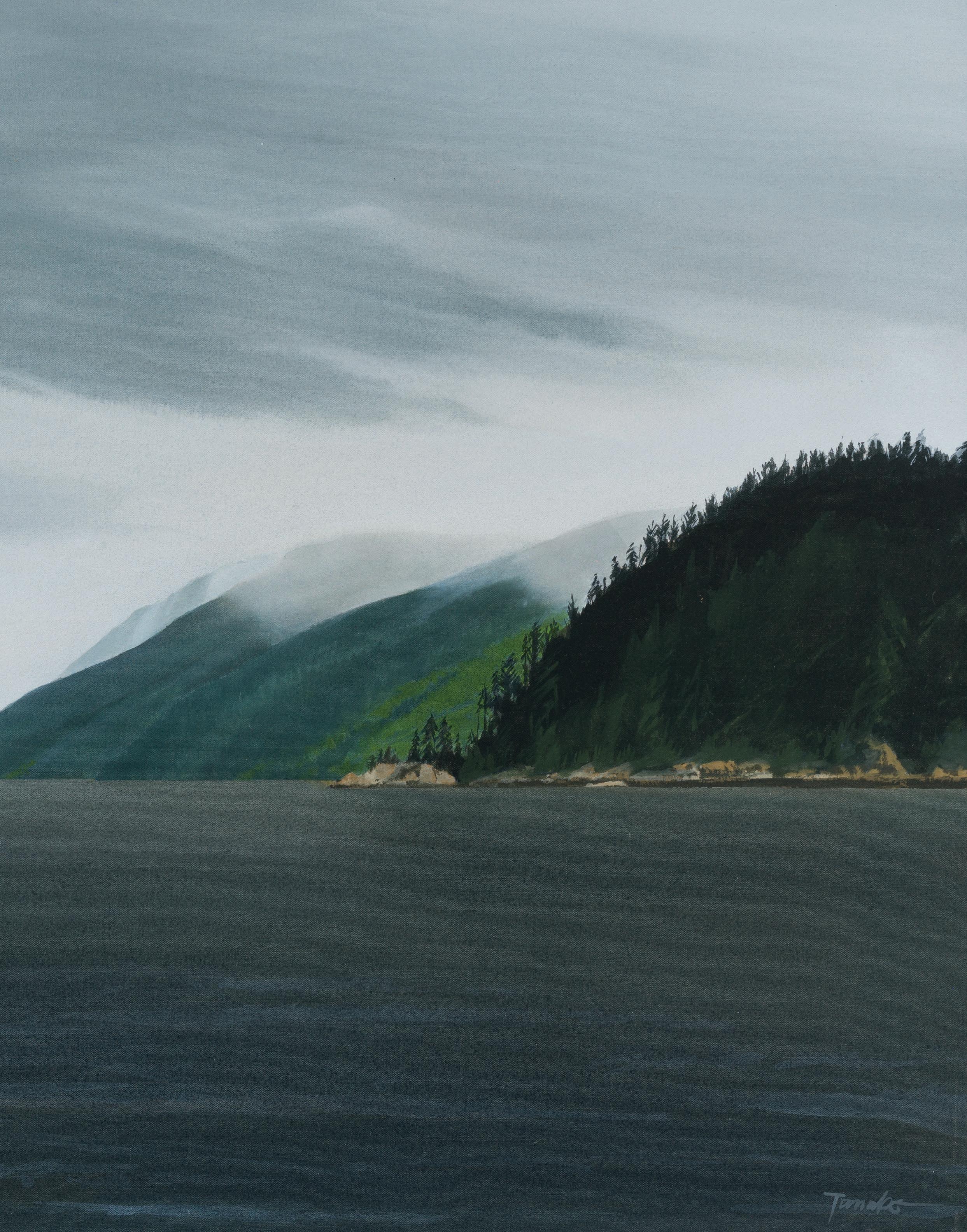


n umism A tics WWW HEFFEL COM 1 888 818 6505 MAIL @ HEFFEL COM Vancouver Calgary Toronto Ottawa Montreal r oyA l cA n A di A n m int 2023 Pure Gold Coin – Lunar Year of the Rabbit numismatic coin 102 mm diameter P rice: $99,500 CAD ( P r IC e S u BJ e CT T o CHA nge) s P ecific Ations Composition: 99.99% pure gold Mintage: 38 Weight: 1005 g Face Value: 2,500 dollars Finish: Proof Edge: Serrated Artist: Aries Cheung (reverse), Susanna Blunt (obverse)

